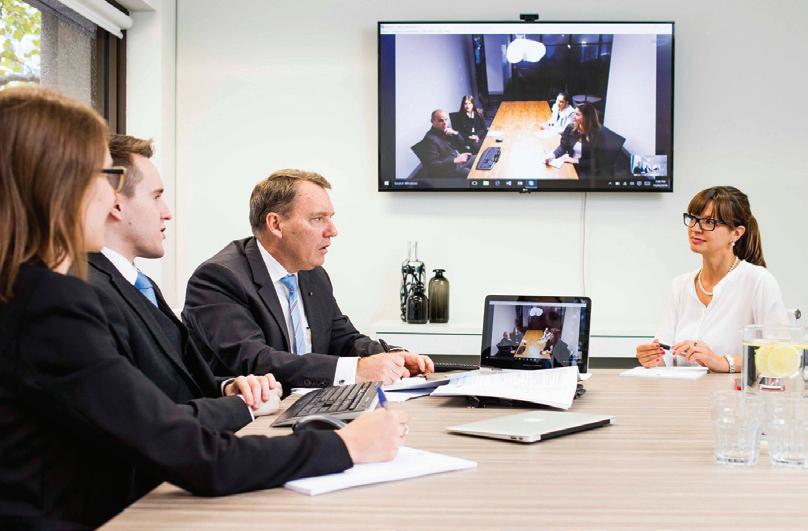Surviving COVID-19 A patient’s story

Excerpts from a Bar diary in the Plague Year Human rights, business, and sentencing during the pandemic

Surviving COVID-19 A patient’s story

Excerpts from a Bar diary in the Plague Year Human rights, business, and sentencing during the pandemic
The Victorian Bar funds two independent services where members and their families can access crisis support and counselling.


Despite everything, we have 5 a stellar issue of Bar News!
Letters to the Editor 6 President’s column 8
WENDY HARRIS CEO report KATHERINE LORENZ 10
Around Town
Wigs and Gowns Squadron 12 (WAGS) Annual Sailing Day
JULIE R DAVIS
Jewish opening of the legal year: 14 remembering legal luminaries
ANNETTE CHARAK
Community opening 15 of the legal year 2020
Opening of the legal year: Red Mass 16
Supporting Djirra on International 18 Women’s Day
NATALIE CAMPBELL AND LAURA HILLY
The 2020 Flagstaff Bell 19 CAROLINE PATERSON
News and Views
Truth or consequences: an 20 interview with Dan Crennan QC
JUSTIN WHEELAHAN AND CAMPBELL THOMSON
Cyber snippets—why you 24 should be worried
HEATHER HIBBERD
Our Top Courtroom Dramas 26
NATALIE HICKEY
The virtual advocate 30
ERIK S. DOBER
Iso Stories
Advocacy in the age of Coronavirus 34
COVID-19: Up close and personal 38
JOHN GURR
Excerpts from a Bar diary 40 in the plague year
CAMPBELL THOMSON Iso life 43
FABIAN BRIMFIELD
My experience of giving 44 birth in lockdown
LUCY LINE
Experiencing the whiplash 45 and its recovery
NATALIE HICKEY

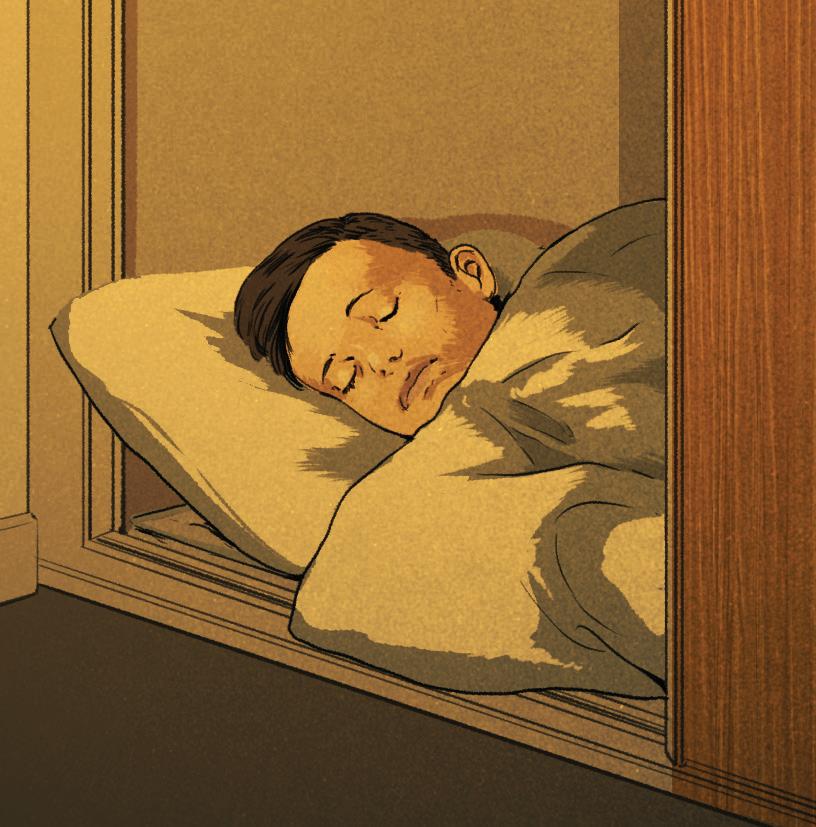


46 Reflection: the act of serious thought or consideration
TEMPLE SAVILLE
48 A Readers’ Digest
VERONICA HOLT
52 A view from the big smoke
ADAM CHERNOK
54 Human rights and rule of power in COVID-19 times in Victoria
FELICITY GERRY AND JENNIFER KEENE-MCCANN
57 Business and human rights during the COVID-19 pandemic
SHANTA MARTIN
59 Reimagining proportionality in a global pandemic
RICHARD EDNEY
62 How I ruined America (and possibly the world)
ANONYMOUS QC
65 Poetry for the pandemic
Bar Lore
66 When Monash law students’ hoax created law folklore
JACK HAMMOND
70 The Nazi Volksgerichthof (People’s Court)
BRIAN WALTERS
Back of the Lift
72 Adjourned Sine Die
73 Silence all stand
75 Vale
Boilerplate
90 A bit about words
JULIAN BURNSIDE
93 What unwanted sexual attention feels like, and what we should do about it
95 Book reviews
98 Grammar pedant
ANNETTE CHARAK
99 Then and Now: Barbara Cotterell and Sarah Fisken
CAMPBELL THOMSON
100 History and storytelling
PETER HEEREY
102 Being a line umpire for Tennis Australia
KAREN MAK

Editors: Natalie Hickey, Justin Wheelahan and Annette Charak.
Victorian Bar News Editorial Committee: Natalie Hickey, Justin Wheelahan, Annette Charak (Editors), Maree Norton (Deputy Editor), Carmella Ben-Simon, Campbell Thomson, John Tesarsch, Tony Horan, Temple Saville, Brad Barr, Jesse Rudd, Hadi Mazloum, Veronica Holt, Shanta Martin, Denise Bennett and Amanda Utt.
Contributors: Jennifer Batrouney AM QC, Oren Bigos SC, The Hon Michael Black AC QC, Her Honour Judge Katherine Bourke, Fabian Brimfield, Hugh Burchill, Kate Burke, Robert Burns, Julian Burnside AO QC, Natalie Campbell, Annette Charak, The Hon Stephen Charles AO QC, Adam Chernok, Jennifer Clark, Eleanor Coates, Georgina Costello SC, Julie R Davis, Brenton Devanny, Erik S Dober, Tessa Duthie, Richard Edney, Renee Enbom SC, Kylie Evans, Garry Fitzgerald QC, The Hon Jack Forrest QC, Felicity Gerry QC, Bill Gillies, Katharine Gladman, Tim Glass, John Gurr, Jack Hammond QC, Wendy Harris QC, Paul Hayes QC, John Heard, The Hon Peter Heerey AM QC, Heather Hibberd, Natalie Hickey, Dr Laura Hilly, Paul Holdenson QC, Veronica Holt, Simone Jacobson, Ben Jellis, Peter Jopling AM QC, Jennifer Keene-McCann, Dr Bryan Keon-Cohen AM QC, Richard Lawson, Lucy Line, Katherine Lorenz, Karen Mak, Melissa Marcus, Shanta Martin, His Honour Judge Michael McInerney, Murray McInnis, Julian McMahon AC SC, Ron Merkel QC, Simon Moglia, Stephen Moloney, Allan Myers AC QC, Daniel Nguyen, Caroline Paterson, The Hon Justice Phillip Priest, Mark Purvis, Uthra Ramachandran, Siobhan Ryan, Robert Sadler, Temple Saville, Anna Svenson, Campbell Thomson, Robert Thyssen, Fiona Todd, Bronia Tulloch, Priya Wakhlu, Ian Waller QC, Brian Walters AM QC, Stephen Warne, Justin Wheelahan, Michael Wise QC, Michael Wood, Chris Wren QC, RNJ Young.
Photography: Allstar Picture Library Limited/Alamy Stock Photo, Alona Photo, Andrew Curtis and the Monash University Archives, Lily Crennan, Fizkes, kseniiavladimir, SongQuan Deng, Tony Baggett, Catholic Archdiocese of Melbourne, Ian Dagnall Computing, Picturelux/The Hollywood Archive, The Monash Reader, World History AF Archive
Publisher: Victorian Bar Inc., Level 5, Owen Dixon Chambers East, 205 William Street, Melbourne VIC 3000. Registration No. A 0034304 S
The publication of Victorian Bar News may be cited as (2020) 167 Vic. B.N. Opinions expressed are not necessarily those of the Bar Council or the Victorian Bar or of any person other than the author.
Advertising: All enquiries including requests for advertising rates to be sent to: Elizabeth Gray
Victorian Bar Inc.
Level 5, Owen Dixon Chambers East 205 William Street Melbourne VIC 3000
Tel: (03) 9225 7111
Email: elizabeth.gray@vicbar.com.au
Illustrations, design and production: Guy Shield www.guyshield.com
Printed by Southern Colour www.southerncolour.com.au
Contributions: Victorian Bar News welcomes contributions to vbneditors@vicbar.com.au

Despite everything, we have a stellar issue of Bar News!
NATALIE HICKEY, JUSTIN WHEELAHAN, ANNETTE CHARAK
Back before lockdown, our editorial committee debated themes for our Winter issue. One such option was technology. This, at the very least, received a tepid response. Well, how times have changed people!
At Bar News, we are the eyes and ears of the Bar, lucky enough to receive and communicate your stories. Barristers never cease to surprise us with their hidden talents!
When coronavirus hit in March, it felt like the tide was being sucked out before a tsunami. We muddled our way through it like everyone else. Forced home, we took our own tentative steps together into an online world. For many, our first Zoom meeting together was in fact our first Zoom meeting ever. We tried out virtual backdrops. Some enjoyed peering into each other’s rooms, whereas others found reading delayed online body language utterly exhausting. We learned from each other which practice areas had stopped completely, and which continued to chug along. We also debated films. You will see our Top Courtroom Dramas inside.
Through all of this, we were determined to bring you a publication in the middle of this year—in one form or other. With a history of almost 40 years, most will agree that this issue will be historically significant. The High Court library retains back copies for the record. We wanted to ensure this point in time was documented for posterity. To that end, a huge thanks to the powersthat-be for enabling us to distribute a print issue. This looked sketchy for a while as there were health risks to be managed and costs to be saved. As everyone was at home, the purpose of a hardcopy magazine seemed to disappear. It is uncertain whether we will have a print or digital future, but what we can say, right now, is that we have a hard copy magazine. We hope it helps bind the fabric of our community together.
We will return to our halcyon days. In the meantime, enjoy the reminders of our immediate past. There are beautiful photos of sailing boats and lawn
bowls. We are reminded of Jewish, secular and Catholic openings of the legal year, and an International Women’s Day event. We bookend our issue with Karen Mak’s tale of being a line umpire during the Australian Tennis Open. Let’s not get too used to our ‘new normal’.
Turning to COVID-19, we would like to express our gratitude to John Gurr for sharing his story of testing positive for the disease. He went through a harrowing experience with his family. We can all learn much from John’s first-hand experience. We also want to thank Adam Chernok for his honest, nuanced and poetic account of surfing as catharsis, to ameliorate his grief after the untimely passing of his close mate and fellow barrister, the much-loved James Westmore.
As for life in lockdown, your pictures tell a thousand words. Now is the time, literally, to look into each other’s lives. Such vivid, different, uplifting photographs. Thank you!
We have poetry and personal reflections. Lucy Line gave birth in lockdown. Fabian Brimfield, against his tropical backdrop, has a warning about using Zoom for work after using it personally. Campbell Thomson has channelled Daniel Defoe in his journal of a plague year. Temple Saville reminds us to think of medical personnel going through hell in New York. Veronica Holt also gives us an insight into our readers who joined the Bar in the midst of an unprecedented global lockdown. We also have a splendid satire from ‘Anonymous QC’ about being Trump’s ‘adviser’. As he said to the editors, “I had way too much time on my hands”.
The legal implications of life in lockdown are worrying for many. There are articles about human rights and the rule of law. The principle of proportionality to sentencing, when considering prisoners locked down during the pandemic, is also
examined. We have tips and tricks for managing, respectively, cyber security and online hearings.
For those who are historically-minded, Brian Walters QC takes us back to Berlin, inside Hitler’s People’s Court. This dealt with so-called political crimes in a manner which serves to remind us of the centrality of the rule of law.
We also have an interview with Daniel Crennan QC, now two years into his commission as Deputy Chair at ASIC. Dan explains his role in establishing ASIC’s Office of Enforcement, and ASIC’s “Why not litigate?” mantra. We asked Dan, amongst other things, about whether COVID-19 means ASIC will take the foot off the pedal on enforcement.
If you would like a distraction from the pandemic, look no further than Jack Hammond QC’s inside story of the famous Campbell McComas (aka Professor Granville Williams) hoax at Monash University in 1976. It is a classic tale. We challenge you not to laugh out loud.
A special thanks also to our featured and guest writers who have helped us with Back of the Lift and our regular sections, making up a third of the magazine. This time, our usual Red Bag/Blue Bag column has been replaced by a junior and senior perspective on an issue far too prevalent: unwanted sexual attention.
Finally, thank you Guy Shield! Guy helps with our magazine layout and is a passionate illustrator. He was challenged like never before this time round. The results are beautifully evocative.
What is inside the cover is a remarkable story of our Bar—individually and as a whole—over the past few months. We feel that challenging times will not end soon. Please tell us your thoughts and ideas, submit stories, give us photos, and we will do our best to publish them. Contact us at vbneditors@vicbar.com.au
The Editors
Have your Say Victorian Bar News encourages letters to the Editors on topics ranging from the meaningful to the mundane. Write to the Editors at Victorian Bar News, Owen Dixon Chambers, 222 William Street, Melbourne, VIC 3000 or email vbneditors@vicbar.com.au

Dear Editors,
Re: End of week drinks via Zoom. I see that Bar News is compiling a photo-essay portraying our work environments in the time of coronavirus. I don’t have a photograph, but I have this drawing that you might like.
Every Friday afternoon, I share a drink via Zoom with some
of the juniors appearing with me in the Royal Commission into the Management of Police Informants. Before today’s drink I received this terrific drawing from one of the juniors, Caroline Dawes. It reflects our work together as a team despite being spread across Victoria at the moment. Those in the drawing with me are Caroline, Siobhan Kelly and Holly Jager.
Renee Enbom
Why should the victim of family violence have to leave home and seek refuge?
The issue of family violence should be a matter of concern to all members of the community.
Over many years the Victorian Bar hosted numerous breakfasts in support of White Ribbon Day and has continued to demonstrate a commitment to raising awareness and dealing with the important issue of family violence.
White Ribbon Australia went into liquidation late last year. The liquidators announced that a WA charity called Communicare had agreed to take over the assets of White Ribbon. Notwithstanding the liquidation and financial mismanagement of White Ribbon Australia, its long-held objective of raising awareness about family violence remains important. Men, like myself, who were White Ribbon Ambassadors were not seeking to do anything other than raise awareness and demonstrate male support for those victims of family violence. Though it is four years since I was involved as a director or ambassador of White Ribbon, the issue of family violence is still a significant issue for me.
Despite the best efforts of police, other emergency services and the courts, the fact remains that a significant percentage of family violence remains unreported. It is also a fact that by the time the police attend the scene of a reported crime and make an arrest or a court order is obtained, the event has usually happened.
It is unfair to expect well-trained police to act as social workers. It is not their job. They are not specifically qualified for that task.
Fortunately, a new generation of members of the community have adopted the view that any form of family violence should not be tolerated. The fundamental issue confronting all of us is the issue of what some may see to be an entitlement to control other persons.
It is crucial for all of us, men and women, to play a role and not leave the matter to politicians, the courts, the police or other emergency services.
We need to think about meaningful solutions that will be available at an early stage of any relationship where the likelihood will be that difficulties develop into serious harm or, as in too many cases, death.
Murray McInnis, May 2020
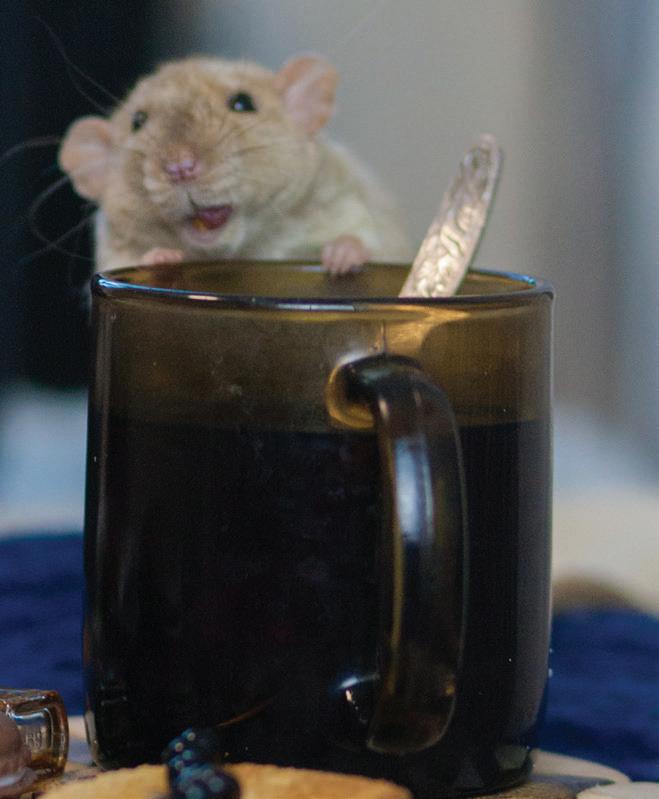
Oh, the days before technology and virtual court rooms.
Stephen Parmenter QC found this little gem when reading the 1982 English case of Prudential Assurance Co Ltd v Newman Industries Ltd (No 2) [1982] Ch 204 at 209 per Cumming-Bruce, Templeman and Brightman LJJ:
The great length of this judgment has naturally caused us to consider whether it would be sensible to hand down a typed or printed version, as an alternative to the many hours in court which will inevitably be spent on delivering our judgment. We have rejected this obvious and convenient expedient for two reasons. First, the appellants have been found guilty by the trial judge of a civil conspiracy in circumstances which, subject to stricter procedures, could equally well have led to their conviction on a charge of criminal conspiracy. In such circumstances we think that … we should express our conclusions orally in open court. Secondly, the delay which would be caused by typing or printing and then proof-reading a written judgment suitable for handing down would postpone judgment over the Long Vacation.
In the 4 March 2020 edition of the Australian Financial Review, Liz Main provided what was, on its face, a straightforward report of a day in court during the Banksia class action proceedings. The protagonists included Justice John Dixon and barrister Samuel Horgan QC. Buried

within the article, though, was the following:
Neither Mr Horgan’s nor Justice Dixon’s concentration was broken when Justice Dixon’s tipstaff unsuccessfully attempted to use a waste-paper basket to catch a mouse that ran past the judge’s bench during their discussion.
WENDY HARRIS
As I look back on November 2019, when I was honoured to take on the mantle of President of the Victorian Bar, there were some key things that I wanted to achieve during the next 12 months. All of these were framed within our strategic objective of ensuring that the Bar, and our members, thrive, and continue to do so. Amongst other things, we needed to make the market and community more aware of the Bar’s core values of excellence, leadership, independence and growth, the latter value being particularly pertinent to the Bar’s stature, health and diversity.
2020 was to be the year of increased engagement by VicBar as an institution with those across the legal profession and the community, specifically with our instructing law firms, government and corporate clients, the judiciary, the Law Institute of Victoria and other Bar Associations, and the legal and public organisations that are our partners in the administration of justice. It was to be the year of comprehensive reviews of our cradleto-grave education offering and the way we identify and meet the health and wellbeing needs of our members; of seeking to improve fee recovery for our criminal members, and of enhancing our mentoring architecture.
And in February things were looking pretty good! Then, in mid-March, the world turned upside down. Over the next few weeks, as the pandemic developed, I received emails and calls from colleagues—from very senior silks through to some new and junior barristers whom I’d unfortunately not had the opportunity to meet in better times. It was clear from very early on that I needed to reset my expectations of what leading the Bar meant in 2020, and how we could be clear in our communications and transparent in our actions to fulfil our new objective for the year.
Our “COVID-19 strategic objective,” if you’d like to call it that, was to bring the Bar as an institution, and our members, through to the other side—with practices intact and the foundations of the Bar strong so that we could continue to thrive into the future.
I am incredibly fortunate to have strong advisors and contributors in the Bar staff, the Bar Council, the Bar Executive, BCL, our committees and associations, and among our members who have helped me frame VicBar’s COVID-19 response to meet that objective. That response is fourfold and, at the time of writing in late May 2020, is ongoing.
The first is to ensure that we have in place the mechanisms to support our members’ physical and mental health. The uncertainties about practice, and the consequences of isolation, have taken their toll on many, and mitigating those impacts across different member cohorts is a priority.
The second is to support our members’ financial wellbeing in every way that we can—this means assisting members to continue practising in a virtual environment, and to ensure that those in government and government agencies understand the peculiar financial position under which barristers operate so that the relief packages also apply to barristers in need. I have also been extremely grateful for the transparent, collaborative and cooperative approach that the courts have taken in addressing the challenges thrown up by the situation as best they can.
The third is to support the infrastructure on which the foundations of the Bar, its culture, its accessibility and its collegiality rest. What sets the Victorian Bar apart from all others around the country and, frankly, the globe is the ability for barristers to access, through BCL, affordable, flexible rentals in the heart of the court precinct with accompanying technological and IT support. Preservation of this infrastructure is critical to ensuring that we have the necessary foundation on which to rebuild, post-pandemic.
Finally, and intimately connected to coming out the other side, is to continue, to the extent possible, our member education, support and market engagement strategies. This is not a time for isolation—it is a time to step up, to be innovative, responsive and adaptable and, indeed, to seize the opportunities that this crisis has presented. I have seen Victorian Bar members produce some brilliant virtual events and publish exceptional thought leadership that is helping our clients, the legal
The uncertainties about practice, and the consequences of isolation, have taken their toll on many, and mitigating those impacts across different member cohorts is a priority.
profession and the community navigate their way through the pandemic. It is by living our core values of excellence, leadership, independence and growth that the Victorian Bar and its members will continue to play that vital role in the justice system throughout 2020 and into the future. I’m extremely optimistic that our Bar will come out the other side well positioned to use this experience to enhance the way we work, the services we offer and client and community perception of our value proposition.
Among the lessons learned, some might be offered by the priority and lifestyle adjustments that have been forced upon us. I have spent the past several months bunkered down with my twin daughters at our little house on the Mornington Peninsula. We have found hidden upsides to life in iso-land. For me, that has included the opportunity for a long morning run among the kookaburras and the eucalypts, extra time spent with my girls (including in my new capacity as French and Maths tutor), and the luxury of not having to rush out of the house in the morning to make that first 8am meeting. These upsides—and the conscious effort that friends and family have made to stay virtually in touch—have made the restrictions much easier to bear at a personal level, and have left me with a determination not to let go too readily of the things that can help to mitigate the pressures that afflict us in our professional lives.

KATHERINE LORENZ
Ominously, it was Friday 13 March when I realised our world would change, significantly, in the short and mediumterm. During that week, we had started to receive emails and calls from members about the potential health risks of being in chambers and going to court. It was then that the VicBar team began planning how we would navigate the impending crisis so we could continue to provide existing services to members and spearhead new initiatives to meet the growing demand for assistance.
Fortunately, the objective was very clear: to support our members throughout the crisis and ensure that a strong and thriving Bar emerged on the other side. Everything we have done since Friday 13 March has been to further this approach.
The health and safety of members was uppermost in our minds. We worked hand-in-hand with BCL to put in place the protocols to follow if one of our members or staff tested positive. The 10 days leading up to the announcement of Stage 3 restrictions were quite tough. Members, quite understandably, expressed different—often polar— views about the pandemic’s likely impact, the strength or lack of government response, and what we should do about it. As an example, some members asked for chambers’ doors to be shut tight, whilst others wanted “business as usual”.
We followed government guidelines.
With the mediation centre closed and barristers and VicBar staff working from home, technology was always going to be key for remote
work. This was particularly true for remote court appearances and dayto-day tasks and meetings needed to maintain barristers’ practices.
The VicBar team supported BCL in communicating about the hardware and software members would need to operate in this new environment, and organised CPDs to make sure that everyone had the opportunity to upskill and continue a viable practice during the lockdown.
This meant postponing or moving all CPD and other events to an online forum. The readers’ course which had only just begun, posed a bigger issue. With restrictions and the threat of illness looming, our education team revamped the whole course to front-load as much of the “in-person” training as they could. Through a phenomenal effort, they moved the remainder of the course to an online platform, meaning that the 48 readers joined our Bar as originally anticipated on 7 May.
Regular liaison with courts and the wider legal profession was also critical. Members will recall the considerable uncertainty of those early days. There was growing alarm over litigants and lawyers who were exhibiting cold and flu-like symptoms, crowded court corridors, and the need for the judiciary to provide reassurance around continuity arrangements.
We worked with the Courts Council, heads of jurisdiction and other parts of the profession— particularly the Law Institute of Victoria—to support the courts’ critical decisions to ensure the continuation of the administration of justice. While each court and tribunal faced different logistical issues, they had a common objective

to ensure that those needing access to justice were served by the judicial system even in the difficult days of the pandemic. Heads of jurisdictions began regular correspondence with us, and we distributed these daily, sometimes twice daily, to members in our COVID-19 updates. It was this collaboration across the profession in Victoria, in concert with other State and Territory Bar Associations, that meant that workarounds were developed quickly and innumerable problems were solved.
We also recognised that, for some members, their practices evaporated, overnight, particularly when new

jury trials were suspended. As I said above, our key strategic aim was to bring as many of our members as possible through to the other side of the lockdown with thriving practices intact. The financial impact has been devastating for a number of our members. I’ve been working with the Bar Executive and our VicBar team to communicate the government’s relief measures and how barristers can access those, put together a plan to waive or significantly reduce Bar subscription fees for members in need, and provide proactive support.
We have always understood that communicating often and
The financial impact has been devastating for a number of our members.
transparently to members is key; so we “hijacked” the health and wellbeing page on the VicBar members’ website as a portal to consolidate our COVID-19 related information and resources. We feel that it is important that members easily access additional support as they need it.
At the time of writing, we are still in “lockdown”. We don’t know when or how we will return to “normal” —or indeed what the “new normal”
will look like. Future readers of this special commemorative COVID-19 edition of Bar News will know the answer to this—and I hope they will look back at this time not only as one of disruption but also of adaptation—that the Victorian Bar grasped the opportunity to marry effective technologies with strong and independent advocacy to serve the judicial system and those seeking justice in the community.
JULIE R DAVIS
The sun was shining and there was a 15-knot breeze. Perfect. On Thursday, 19 December 2019, a group of very excited barristers and solicitors lined up at the end of the Royal Melbourne Yacht Squadron marina in St Kilda. Inclement weather in two previous years had relegated the mariners to lunch earlier than anticipated in the club’s Olympic Bar. Not so this time. Enthusiastic planning, perfect conditions and renewed interest from sailors and crew saw seven yachts and 55 participants line up for the start.
Justice John Digby, the owner of a splendid cruising yacht named Aranui, assumed the mantle of honorary commodore of the WAGS. Skippers and crew (an assortment of barristers and solicitors, experienced and novice sailors among them) gathered for the race briefing at 11am. Immediate past commodore, Peter Rattray QC, set the course and start times at five-minute intervals between yachts. Those assembled heard Rattray direct the fleet to sail to Station Pier, thence to a buoy marked ‘C’ somewhere west of the Squadron and to return to the finish line adjacent to the Squadron Tower at the end of St Kilda pier.
Peter Rattray manned Ian McDonald SC’s chase boat to ensure all yachts sailed a proper course. Less concerned by Rattray’s focus on tactics, McDonald, with Neil Rattray and Julie Davis, kept up with the fleet while taking photos. The task of finding the buoy marked ‘C’ proved problematic.
After a very pleasant, sunny sail around the course, the yachts returned to the RMYS marina to tie up and adjourn to the clubhouse for lunch. Skippers and crew enjoyed a delicious barbecue cooked on the balcony,
overlooking magnificent St Kilda harbour and across the bay to Williamstown beyond. One or two glasses of fine wine were also enjoyed.
Mid-afternoon, Rattray and Digby announced the race results. Two yachts were disqualified for crossing the start line early. Another failed to sail around the elusive ‘C’ mark. The winner of the Neil McPhee QC trophy (although third across the finish line) was Wingara (John Hall). The second and third place-getters, respectively, were Panache 111 (Egils Stokans) and Aranui Liberty (Robert Galbally) was presented with the Thorssen Trophy (which is a broken channel mark light—a long story) for good sportsmanship to much applause and camaraderie.
It was a great day out. If you would like to hear the story of the Thorssen Trophy and have a relaxed, fun day with friends and colleagues, keep your eyes open for the WAGS Notice of Race to be published in November 2020.
Participants in the 2019 annual WAGS day were:
» Robert Galbally (retired solicitor and a member of the RMYS Committee) on his yacht Liberty with six crew;
» Egils Stokans (retired solicitor) with his yacht Panache 111 and three crew;
» Rebecca Badenoch (family law solicitor) on White Pointer, a Sandringham Yacht, with six crew;
» Richard McGarvie QC with 12 crew on his yacht Addiction;
» John Hall with six crew on his yacht Wingara;
» Romauld Andrew on his yacht Tandanya with four crew; and
» Peter H Clarke on his timber motor yacht Renaissance with seven crew.






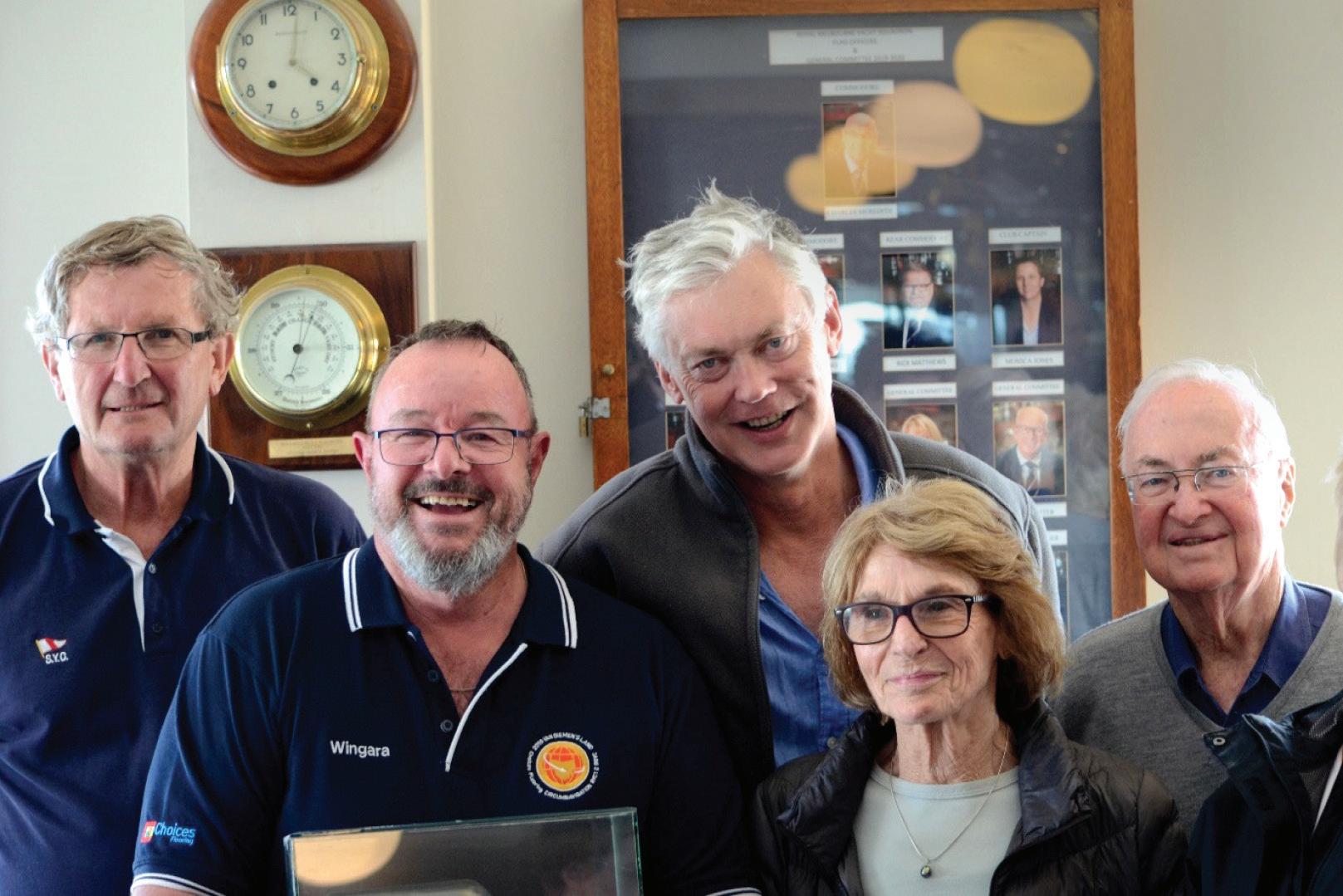





ANNETTE CHARAK*
The Jewish opening of the legal year was marked on 28 January 2020 at the East Melbourne synagogue. Along with some beautiful musical liturgy, traditional readings about justice and the role of law, and a legal prayer composed by the late Maurice Ashkenazy QC, it was an occasion to celebrate two members of the legal fraternity who had passed away in the previous year. In the presence of several family members, Ray Rosenberg was remembered by Simone Jacobson, one of Ray’s former readers, whose tribute to him appears in these pages.
Ian Waller QC paid tribute to his father, Emeritus Professor Louis Waller, a man who left his mark on generations of Monash University law students. Justice Mark Weinberg has described him as a “great teacher, one of the best I ever encountered.”
Julian Burnside QC has said, “Louis Waller was spectacular—he was probably the best teacher I’ve had anywhere at any time.”
Professor Waller, born Pinchas Leib Waligora in Siedlce Poland on 9 February 1935, arrived in this country at the age of three. He began his law studies in 1952 and found the course exacting and exciting. Among his teachers were several (including Zelman Cowen and David Derham) who sparkled as models for what he decided he himself wanted to become: a “public teacher of law”.
In 1964, he joined the newly established law faculty at Monash University as the Sir Leo Cussen Professor of Law, a position he held for 36 years. From 2000, he remained active at Monash as Emeritus Professor.
In 1984, Professor Waller was appointed the first chairperson of Victoria’s newly created Law Reform Commission. There, he helped produce reports that led to ground-breaking reforms to the criminal law. He also chaired the committee that considered the social, ethical and legal issues arising from IVF. The report of the Waller Committee led to landmark world-first legislation that would change forever the lives of those struggling with infertility.
Louis often remarked that his work in law reform involved dealing with profound issues affecting the beginning and the end of life. A feature article in The Age in June 1982 stated that “The professor’s respect for human life is informed by his religious belief.” It quoted him as saying, “I am Jewish; it is part of the fabric of my life.” Ian commented that his father’s appreciation of Jewish values and his awareness of Jewish history influenced his involvement in law reform, particularly to assist disadvantaged and marginalised people.
Through his teaching, his work in law reform and his active involvement on legal and ethical committees, Professor Waller’s

influence was deep and far-reaching. In 1989, he was made an Officer in the Order of Australia. He was particularly proud that the citation recognised his contribution as a “public teacher of law”. Jack Fajgenbaum QC described Louis’s story as “one of a three-year-old child who arrived in Australia, speaking only Yiddish, who rose to greatness as a wise scholar, a dedicated teacher, an outstanding academic and educator, a ground-breaking law reformer and a master of the English language, crisp, clear and precise. In accordance with the biblical command, he always pursued justice and pursued it justly.”
Ian said his father enjoyed attending the services marking the Jewish opening of the legal year, welcoming the opportunity to see friends, colleagues and former students. And, at a deeper level, it was an occasion which recognised and celebrated two fundamental aspects of his life: the law and his Jewish faith.
Professor Waller died on 8 October 2019. Among the items collected from his office at Monash University were several framed photos. They included one of Louis and Ian standing outside East Melbourne synagogue at the opening of the legal year, exactly 30 years ago. He will be missed.
*With thanks to Ian Waller QC for his significant contribution

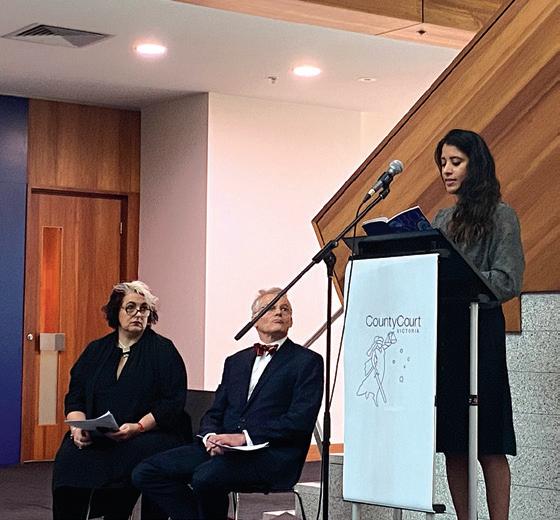

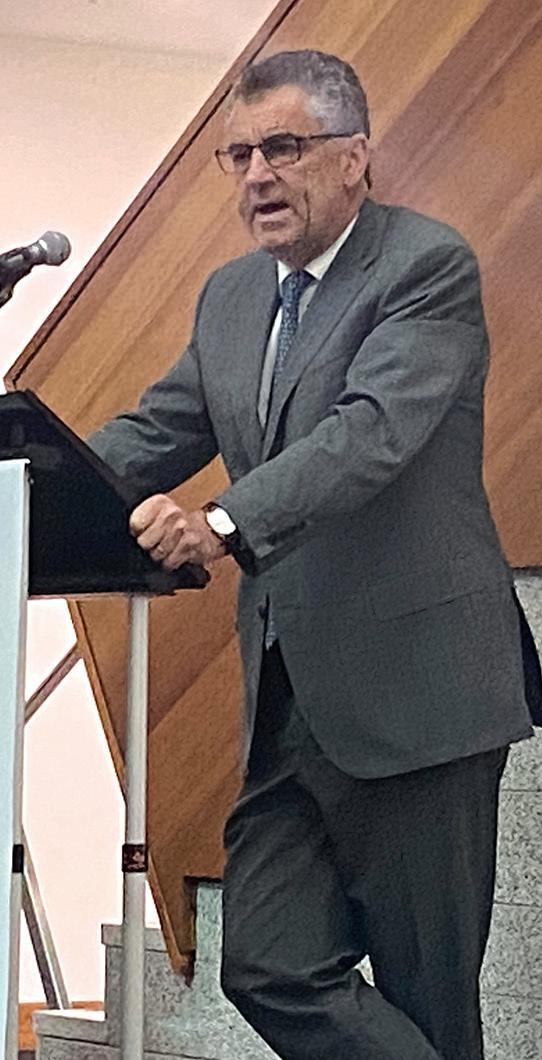
The BottledSnail Jazz Combo plays as guests file into Waldron Hall in the County Court on Monday 3 February 2020 for the Community Opening of the Legal Year, hosted by the International Commission of Jurists, Victoria.
President Maxwell speaks about the rule of law. It requires independent judges, access to courts, supervision by courts of executive power and treating like cases alike to provide certainty and predictability. He then stresses the importance of learning through uncertainty and acquiring wisdom through doubt. He says judges need to be curious, sceptical and open.


Jill Redwood describes how 80 per cent of East Gippsland’s forests were destroyed in the recent bushfires. She had battled for nine hours to save her Goongerah property. Fortunately, the old growth forests of Brown Mountain, which she and Environment East Gippsland had litigated to save from logging in the Federal Court, were spared. She thanks the lawyers involved in that case.
The instructing solicitor in the Brown Mountain case, Vanessa Bleyer, then speaks about environmental litigation strategy and the need to co-ordinate experts from different fields.
ICJV President, Justice Lesley Taylor, then awards the John Gibson Award for the best contribution to human rights in Victoria to David Burke, legal director at the Human Rights Law Centre. Justice Taylor says, “David spearheaded the profession’s response to the medical transfers of asylum seekers from Manus Island and Nauru. He has been instrumental in assisting law firms to take on proceedings at a moment’s notice.” David responds that collaboration between professionals is more important than ever with 400 people still in offshore detention after seven years.
The Melbourne poet Elena Gomez reads two poems from her recent collection, Body of Work, which was highly commended in the 2019 Premier’s Literary Awards.
Two students, sponsored by the Skyline Foundation, which assists gifted pupils from disadvantaged backgrounds to finish high school, discuss their aspirations. Malaz MohamedBakhit is to study law at Melbourne University and Tariq Ismat, Wathaurong man, looks forward to studying nursing.
Finally, Ngiyampaa singer songwriter, Pirritu Brett Lee, wraps up proceedings with a number he had taken on the 2019 Homelands international tour. Guests then mingle over morning tea catered by the Asylum Seeker Resource Centre. Thanks to John Dever for sponsoring the event.


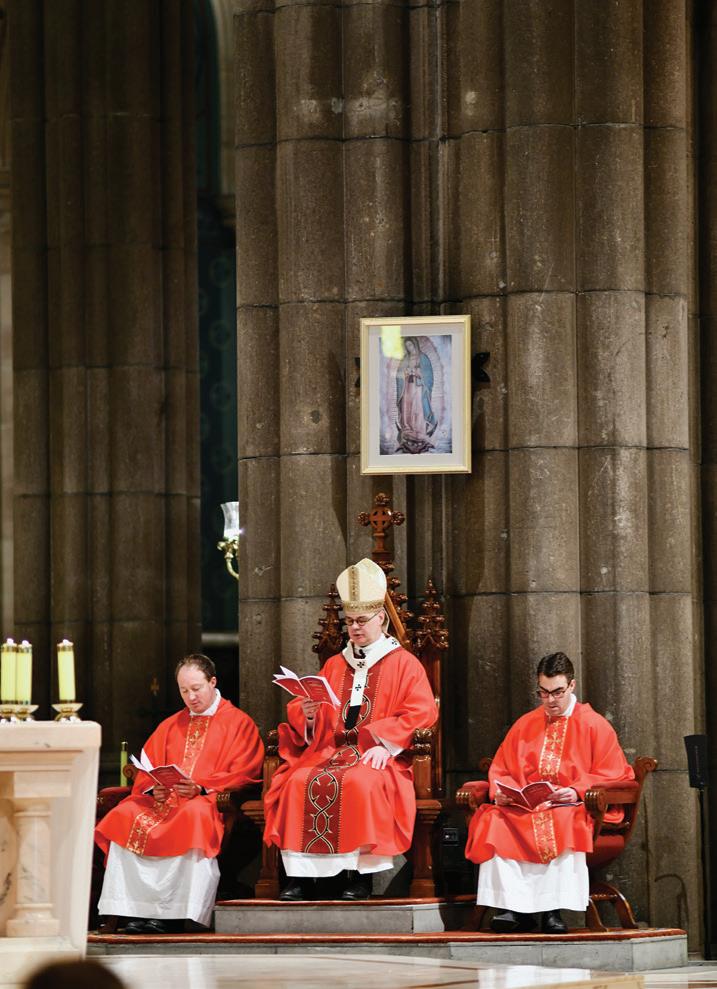
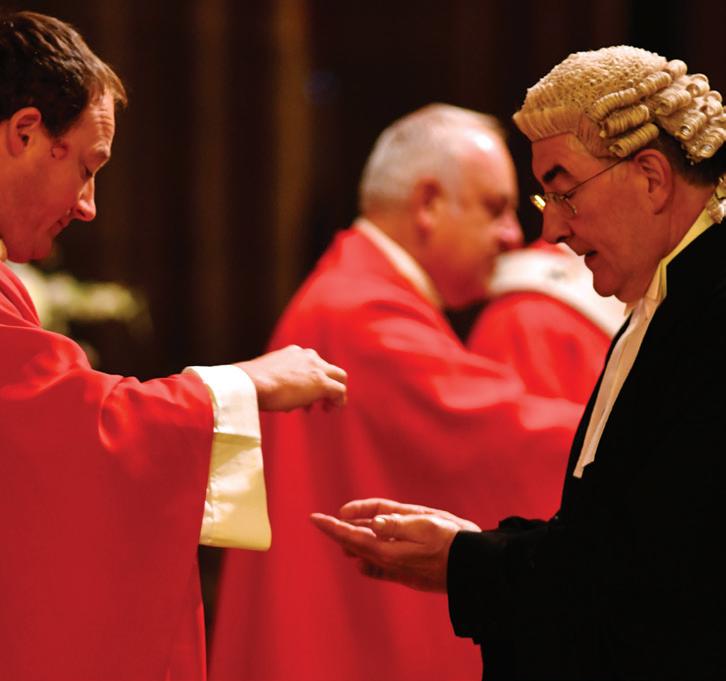


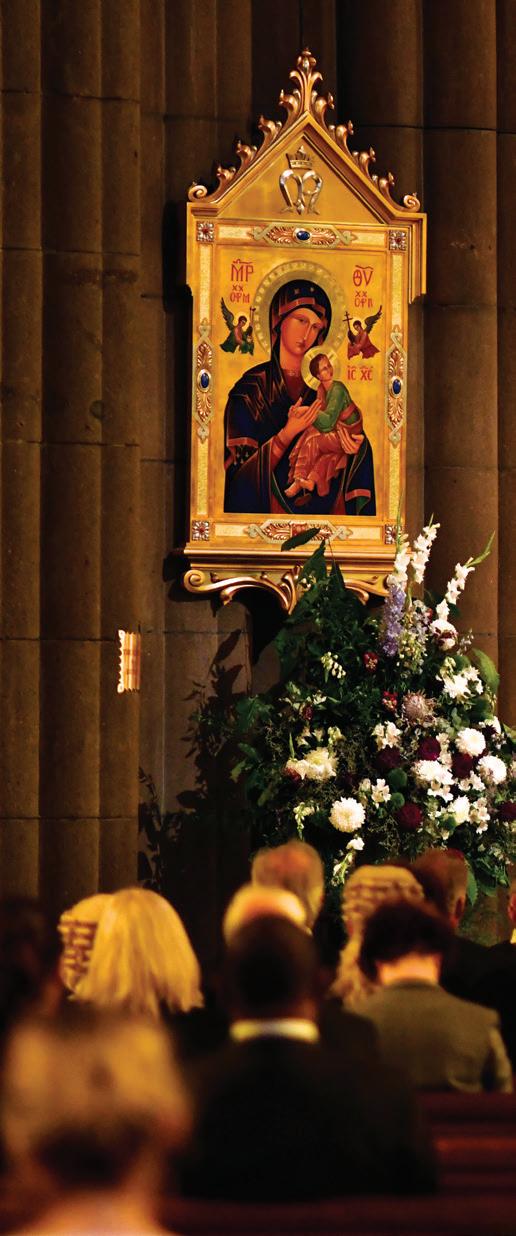


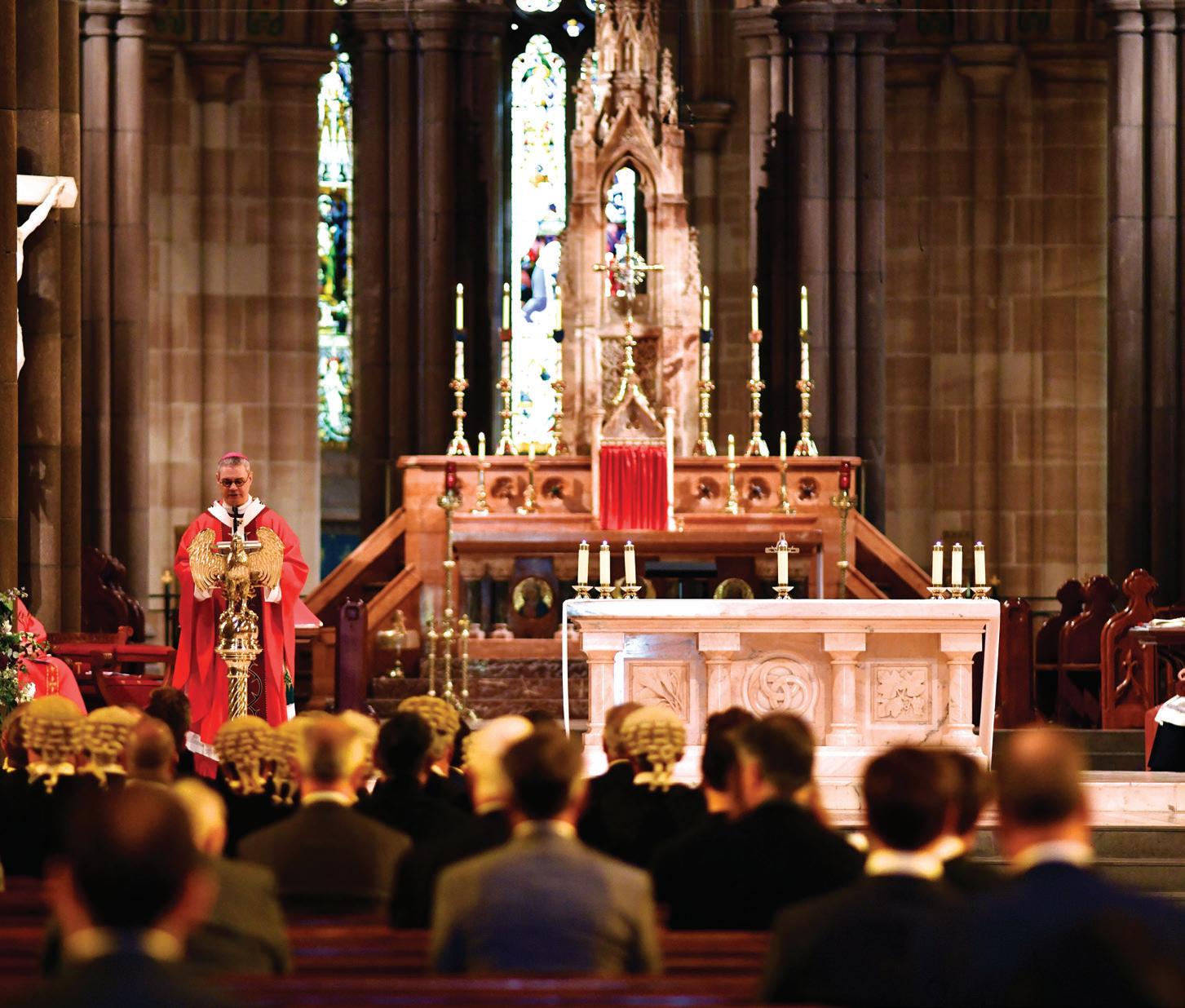




VBN
The first recorded Red Mass was celebrated in the Cathedral of Paris in 1245 and spread to most European countries thereafter. The Votive Mass of the Holy Spirit held annually on the first day of the Michaelmas Law Term in England and Ireland was called the Red Mass because the celebrant was vested in red, and the justices robed in scarlet. The Red Mass is like any other Roman Catholic mass, except the prayers of the faithful are focused on legal admistators dispensing justice, and the many afflicted by injustice throughout the world.
The traditional Red Mass was celebrated at St Patrick’s Cathedral on Tuesday 28 January by Archbishop Peter Comensoli to mark the opening of the legal year—his Grace’s first Red Mass since becoming Archbishop of Melbourne. The mass was well attended by the judiciary this year, and a procession of judges, magistrates, tribunal members, judicial registrars, court officials and barristers preceded Archbishop Comensoli into the Cathedral.
Archbishop Comensoli gave a sermon on the ancient Greek concept logos in the gospel of St John and St Mark—taking some present back to Fred Ellinghaus’s contract lectures on eros, logos and unconscionability as undergraduates. The Archbishop’s message was that the logos of Jesus, in word and deed, is a law, a rule and measure, for human flourishing. True justice cannot flourish unless mercy is allowed to flourish, for mercy is always attentive to the truth of the persons involved.
At this point, the Archbishop’s sermon was interrupted by a protestor. Archbishop Comensoli stood down briefly from the pulpit to listen to the protestor, and then returned to complete his sermon. The archbishop then invited those present to be courageous in their commitment to telling the story of justice and mercy in our society.
After the Red Mass, Archbishop Comensoli invited the judiciary and members of the legal profession and their families into the cathedral presbytery for tea, and convivial discussion.

NATALIE CAMPBELL AND LAURA HILLY
Djirra is an Aboriginal community controlled organisation where culture is shared and celebrated, and where practical support is available to all Aboriginal women and particularly to those who are currently experiencing—or have in the past experienced—family violence. Djirra works toward a future where all Aboriginal women are strong, safe, independent, healthy and positive in their lives, culture and communities. Its work is preventative, early interventionist and responsive and supports Aboriginal women to tell their stories and find solutions that work for them.
Djirra is the Woiwurrung word for the reed, traditionally used by Wurundjeri women for weaving. Weaving gave Aboriginal women the opportunity to come together, share their stories and knowledge, support each other and find solutions.
For International Women’s Day, an event took place on Level 16 of Aickin Chambers to celebrate and raise funds for the work of Djirra.
We raised over $1000. Little did we know that this event would occur on the precipice of a pandemic that would escalate the current crisis in family violence. Efforts to contain a public health crisis necessitating a community-wide lock-down intensified the experience of family violence for many.
Both the Family Court and Federal Circuit Court moved quickly to fast-track cases in which there was an increased risk of family violence resulting from COVID-19 social restrictions. There was also a prompt response from family violence services, including Djirra, to ensure access and continuity of critical services. Barristers practising in the area showed resilience and responsiveness in managing this additional caseload.
The reduction of face-to-face services, travel restrictions, stress caused by lockdowns and economic uncertainty mean that more than ever Djirra’s services need our support. Please go to givenow.com.au/fvpls to donate to Djirra now.
If you are experiencing or concerned about someone experiencing family violence the following services may assist:
DJIRRA: 1800 105 303
1800 Respect national helpline: 1800 737 732
Women’s Crisis Line: 1800 811 811
Men’s Referral Service: 1300 766 491
Lifeline (24 hour crisis line): 131 114
Relationships Australia: 1300 364 277
Vic Safe Steps crisis response line: 1800 015 188
NSW Domestic Violence Line: 1800 656 463


CAROLINE PATERSON
The evening of Friday 21 February 2020 was a mild and clear night. It was perfect weather for the second annual Flagstaff Bell, when the family law profession comes together at the start of the new year for a casual spit-roast dinner and to try their hands at lawn bowls.
The competition pits solicitors against the Bar and Bench. No prior experience is required and its absence, in fact, may be an advantage. James Moore, who came to the Bar in May 2019 and read with Joe Melilli, wore a fabulous pair of loose sweat pants with multi coloured knee pads, teamed with a striped tee shirt and blue jacket. This earned him an impromptu best dressed award.
This year, we had a terrific crowd of 170 barristers, solicitors, judges and their associates, with approximately 110 of those having a go on the green. After 13 matches, the scores were tied at 6.5 matches per team.
Everything came down to the last match on the green. Barristers Marita Ham, Mark Hebblewhite and Hilary Bonney— not known for their hand-eye coordination—were firmly in a losing position until former bowls champion, Judge Grant Riethmuller, stepped in and started offering unsolicited advice. This dramatically improved their performance. They managed to win the last two ends of their match, clinching victory for the Bar and Bench.
Judge Heather Riley of the Federal Circuit Court was thrilled to accept the Flagstaff Bell on behalf of the Bar and Bench from Family Law Bar Association President, Geoff Dickson QC. Her Honour was heard saying how pleased she was that this would give her bragging rights for the next 12 months as the trophy takes pride of place in her chambers.
The third Flagstaff Bell will be held on Friday 19 February 2021.
JUSTIN WHEELAHAN AND CAMPBELL THOMSON
VBN found Daniel Crennan QC working from home from Sydney over Zoom, seated in front of a framed Martin Kantor photograph of Paul Kelly next to the street sign for a town called Truth or Consequences in New Mexico. It seems a fitting home office for the ASIC commissioner and deputy chair who has been described as ASIC’s new “cop on the beat”, and a “Rudolph Giuliani-like figure”. Tumbleweeds may well be rolling through the physical offices of ASIC, closed due to COVID-19, but the work of enforcement quietly goes on from home. VBN took the time to ask Dan some questions about what the new job is like, neo-Kantian organisational philosophy, COVID-19 storm chasers, and that elusive concept of fairness.
VBN: Dan, how is it different being where you are from being a barrister running cases?
DC: Well, there’s a number of obvious differences. I don’t go to court anymore, I’m not working for a client, nor am I strictly speaking being employed by anybody. I’m a statutory appointee. The way the Office of Enforcement is structured, I am the current chair of any of the committees in which we make decisions or provide guidance relating to enforcement.
VBN: What was it like for you personally moving from your role as an independent member of the Victorian Bar to this regulatory role?
DC: Mildly traumatic is probably the best description. You do lose that independence, which is part of one of the precious possessions of a barrister. On the other hand you

gain a different type of collegiality, which is not sort of the whole Bar collegiality, or Bar Council collegiality—but you share with your fellow commissioners (without being melodramatic about it) very significant responsibilities to society as to the efficient running of the markets and the economy insofar as it relates to regulatory activities. The decisions you make are as difficult

as, and sometime more difficult than, the forensic decisions you might make as a barrister. We have to think about the effect of our decisions, for example, on the public list, the ASX.
VBN: Tell us about the review you conducted that led to the establishment of the office of enforcement.
DC: That was a little bit unusual. The review was not conducted within
ASIC by ASIC. Rather, the review was an internal review led by one of the commissioners, the deputy chair, being me with an external panel. So that was the design of the review, which included engaging a commercial silk, being Michael Wyles QC, Deputy Commissioner Leanne Close of the AFP, Professor Ian Ramsay, the Harold Ford Professor of Law at Melbourne Law School, and two junior barristers, Andrew
Di Pasquale and Andrew Bailey, conducting interviews and analysing the records and policy documents. We conducted quite a broad review as to how decision-making took place at ASIC relating to enforcement. We made various recommendations, one of which was to establish a separate office of enforcement within ASIC that conducted all enforcement investigations applying uniform rules and procedures.
One of the criticisms the Royal Commission made was that the supervisory part of regulatory work—which necessitates closer contact with the regulated— potentially undermined enforcement decisions. For example, a preference for enforceable undertakings might have been prevalent in the past where contraventions of law may have taken place, and litigation didn’t take place. In fact, the legislative framework that was in place prior to the passing of the Penalties Bill was perhaps more conducive to a negotiated outcome due to the unavailability of civil penalties for many key provisions such as s912A of the Corporations Act and s47 of the Credit Act.
The ‘Why not litigate?’ Socratic discipline is essentially a procedural discipline of asking ourselves that question when making enforcement decisions, both at executive and Commission level. The kernel of the decision-making is, “If we’re not
a matter of deterrence, this lacked some utility—notwithstanding that, perhaps, a declaration amounted to public denunciation. That Bill passed, and the Act received royal assent on 13 March last year. So, with this new arsenal of higher civil penalties and longer custodial sentences, we’re in a much better place to justifiably use the courts to achieve specific and general deterrence.
Coming from the Bar, I was naturally orientated towards litigation in any event. And that perhaps might have been one of the reasons that I was asked if I could take on leading the enforcement aspect of ASIC at the time.
VBN: What model did you use for the establishment of the office of enforcement?
DC: It was a model that Max Weber, a neo-Kantian formulated in a German organisational philosophy work called On Bureaucracy. It set out some fundamentals which he believed should be observed
The kernel of the decision-making is, “If we’re not going to litigate, why not?”
going to litigate, why not?” Inevitably that leads to a more litigationorientated approach. It does not equate to a “litigate everything” footing but rather an identification of the matters appropriate for litigation.
That didn’t occur in a vacuum, and it wasn’t just responsive to criticisms by the royal commission. It was very closely related to the introduction of penalties by the passing of the Penalties Bill. The Act introduced penalties for a whole vast raft of provisions in several Acts which found ASIC’s regulatory remit.
Effectively, the Act added civil penalties to provisions that before then carried no civil penalty consequences and significantly increased existing penalties. Previously, in seeking relief for contraventions of s912A, for example, all that we could seek from the court was the making of a declaration. As
by bureaucratic organisations, recognising that they had to make decisions, and those decisions had to inform and influence the broader society—no matter what they were about. So, the features of Weber’s model include clear accountability for decisions that are made, there’s clear lines of authority, ongoing education and so forth. They’re pretty basic sorts of things, but when we established the office of enforcement we introduced those concepts as very important—be accountable for your decisions, everyone must know who is accountable for the decisions, who makes these decisions, when and why.
VBN: So is COVID going to change the “Why not litigate?” approach?
DC: No, it won’t. There are challenges that the agency itself faces during COVID-19. For example, working at
home is a challenge of itself. One of the other difficulties we have is that we know, for example, that it’s going to be more difficult to respond to notices.
There is an understandable concern, and we’ve spoken in Canberra about this to various people including government, of scammers who are using the difficulties faced by people during COVID-19 to extract money from them, or whatever it might be. We did keep a very close eye during the bushfires on the insurance circumstances and what’s called “storm chasers” in America—where unscrupulous individuals will speak to those who have suffered damage or whatever, and invent and profit from false services in relation to insurance. So, we are acutely aware of that. That's another difficulty.
But in terms of the COVID-19 environment having an effect on our appetite for litigation, that’s not the case. It’s just that we will have to prioritise investigations. Litigation that’s on foot is in the hands of the court, so we’ll participate in litigation in any way the court is able to conduct, but it’s really about the investigations and how we manage that, and we are careful managing that part of it.
VBN: What about ASIC as an organisation? We’re clearly going through a huge social transformation at the moment. Can you comment on your own experiences as a commissioner? DC: For my part, the ability to use Zoom and the telephone has meant that a lot of what I do in my position can be continued. It is a bit difficult not having face-to-face contact. When you’re making decisions in a group, there really is no replacement for being in physical contact with each other, because it’s like being in court with three judges. You’ll watch them carefully, and in addressing people, and trying to present your view of what should be done.
VBN: A lot of corporations are under pressure of possible bankruptcy, loss of markets, etc.—does that affect the way you operate?
DC: We do have a significant role in insolvency and monitoring the markets and the market participants very closely. We have a whole group of people who do that. We have been asked to engage in consultation about changes and rules about solvency. So, it does affect our work. Trading whilst insolvent is going to be a big issue. COVID may change that to some extent. Under the guiding principles of our Act, we have broader obligations to the market integrity. Whenever we make decisions, we have to think through this particular prism in a sense, and we have to think about the market, and we have to think about the Australian economy. So, anything that is deleterious to the economy, or assists the financial system, is something we have to take into account. We do have to think about those things very carefully.
VBN: How has your classical education influenced your philosophy at the Bar or at ASIC?
DC: Those things are immeasurable. There’s quite a distance between first-year university and when I came to the Bar. I would say it’s hard to tell, but certainly being exposed at Melbourne University to not just Roman history and Greek history and their languages, but to broader civilisations such as Phoenician and Sumerian and so on, does give you an insight into how moral dilemma or societal issues were dealt with— albeit rather brutally in the past. That concept “do unto others …”, for example, permeates human thinking. It turns up one way or another in many different cultures that have had no contact with each other really at the time.
People in the media and others—lawyers and their clients— persistently ask me about what fairness means. I took part in a panel discussion in October last year with Justice Edelman of the
People in the media and others—lawyers and their clients—persistently ask me about what fairness means.
High Court, Professor Colin Mayer of Oxford University and the British Academy, and Catherine Livingstone, Chair of the CBA, moderated by Dr Bob Austin of the University of Sydney and the NSW Bar that took place at the Supreme Court of NSW. The panel discussion was about a purpose-driven corporate environment, responding to the work of the British Academy and Professor Mayer’s recent work, Prosperity, and was in part about fairness. Justice Edelman said (and I am completely paraphrasing) that if you ask a lawyer to work out whether some conduct amounted to failing a fairness obligation, they’re likely to say, “Well that’s too nebulous and difficult to work out”. But if you ask the same lawyer if the same conduct is unreasonable, they’d readily answer the question, which demonstrates that the words in statutes just need to be understood as to what they are, and the concept of fairness is now very much part of the current regulatory architecture. That’s why I have referenced the many manifestations of that moral reciprocity concept (which has a degree of self-interest to it). The concept of fairness is a deeply embedded concept in human thinking. So, to say that it’s too difficult to understand demonstrates either a misunderstanding of what’s referred to by the use of the word fairness in legislation, or ignoring millennia of thinking.
VBN: And is there a big future for unfairness given the current split on what constitutes unconscionability?
DC: Well that’s interesting. President Maxwell gave a speech about that, and said that fairness could be an appropriate substitute for unconscionability. One of the problems with unconscionability is there’ve been a lot of conflicting views about what it means, and it’s
not a word that’s commonly used in the English language. That’s not to say that the judges have misunderstood what the word means, but it’s just that what the conception of what it is, and how it relates to commercial dealings— either in relation to consumers or in relation to our legislation—is very mixed. President Maxwell made the observation that perhaps that word may have seen its day. Whether or not that’s correct I’m not sure, but we will be running fairness cases under 912A and the corollary section in the Credit Act, for example. Within the next year or two, we’ll have an emerging body of jurisprudence that tells those that seek to make money out of others in our society in industries we regulate what the content of that obligation is. You need some cornerstone legislation in a commercial environment that’s well understood to embed in that regulated population some basic concepts of how they interact with those that they sell things to, or provide products to, or whatever.
VBN: You also need to be able to regulate people who consider themselves not subject to a lot of outside control.
DC: Someone said something like that to me, I think it might have been former Senator “Wacka” Williams, and I replied that if they continue to think that, they must not have been paying attention, because things have changed. I must say, the leaders of most large institutions, I think, do understand that the landscape has changed, and they’re making significant steps to embed in their organisations a respect for the law and the regulator, and to endeavour to respond to suspected contraventions by reporting them to the regulator, and dealing with the consequences.
HEATHER HIBBERD*
Cyber incidents in the legal profession are on the rise and everyone should be worried. This is not just a job for your ‘IT guy’, nor is it just something for your clerk to be responsible for. It rests squarely within your duty to protect your client as well as protecting yourself and your reputation1. While as barristers you may not be dealing directly with clients’ money—where most of the cyber-crime is targeted—you do hold client confidential information that may be exposed and you could unwittingly be a conduit for allowing cyber-criminals into your client’s or instructing solicitor’s computer system. The majority of the notifications and claims we see currently relate to what is called business email compromise. The law firm, the client, or someone on the other side has had their email system infiltrated and the criminals have been able to either intercept an email being sent, or received and changed crucial information, especially bank account payment details.
This is the cybercriminal equivalent of the cat burglar who tries to break into your system through:
» brute force attacks in which they set up a program that just keeps trying every option to crack your password. If you don’t have a program in place to lock your system after a certain number of attempts, they can just keep trying. But even where there are lock-out functions in place, that doesn’t prevent them from coming back in a few hours or days and trying again; or
» buying passwords on the dark web from major hacks of organisations like Facebook and banks. If you use the same password for multiple accounts this leaves you exposed.
The confidence trickster is the physical world equivalent here. They try and trick you into letting them in by sending emails that look like something you should open and read, often from familiar service or utility companies like Australia Post or AGL. More recently we have seen

emails from friends or known work colleagues or other firms that practitioners regularly deal with.
The emails take two different forms. One type of email contains malicious software (malware) either in a link or attachment you need to click on to download, or in some instances just opening in your email view may be enough. The software can do various things including:
» shutting everything down;
» harvesting your keystrokes—including your login details for any accounts you use—email, banks etc; and
» collecting other data from your system: contact details, documents etc.
The second type of email purports to send you some documents. There has been a spate of fraudulent

document-sharing emails circulating within the legal community that look like they are legitimate emails from other law firms. When you click on the link, it takes you to a fake Microsoft sign-in page or to a document-sharing platform such as Skyfish or Dropbox. These emails won’t necessarily be caught by anti-spam filters because they often come from legitimate law firm email accounts that have been infiltrated by cyber criminals.
If you click on the link you will be asked to put in your email credentials: username and password. By doing this you will be giving the cyber-criminals access to your email account. The criminals are then able to monitor your correspondence silently and look for cyber fraud opportunities, including sending further phishing emails to everyone in your contact list.
They try and trick you into letting them in by sending emails that look like something you should open and read, often from familiar service or utility companies like Australia Post or AGL
» Don’t just click on the link—even if it looks legitimate— as it may be from a compromised account.
» Phone the sender via a confirmed legitimate phone number to confirm they have sent the email to you and ask what information the file-sharing platform actually needs from you before you decide whether to open the link in the email.
» If the purported sender knows nothing about the email, advise them to report it to their IT security managers immediately.
» Report the email to your IT security managers
If you have already opened the link and entered your email account credentials, your email account has probably been compromised. You must immediately investigate the compromise and take steps to contain the risk of a data breach. If you have one, implement your cyber security response plan. If you don’t have one, see our Cyber Security Guide information about how to develop a response plan
Enable multifactor authentication (MFA) immediately, as it will prevent anyone who may have obtained your password from being able to access your system from their own device. You can set it up so it is just required once when you use a new device, or every time you log in. It usually involves having an app on your phone that prompts you to approve access when signing in. You or your IT manager should be able to set it up very quickly.
For more detailed information about cyber hygiene practices and how to reduce your cyber risk, see PLC’s Cyber Security Guide for Lawyers, a practical guide to help practitioners be cybersafe, along with our additional risk management cyber resources on our website. LPLC also offers a free online cyber course, details of which were recently sent to all barristers by the Victorian Bar. We encourage all barristers to participate.
*Heather Hibberd is the chief risk manager of the Legal Practitioners' Liability Committee
1 Legal Services Board + Commissioner, Cybercrime: a growing threat to lawyers and clients https://lsbc.vic.gov.au/ newsupdates/news/cybercrime-growing-threat-lawyersand-clients ; Legal Practitioners’ Liability Committee, Cyber claims are on the rise https://lplc.com.au/risk-management/ cyber-security/.
Natalie Hickey
So many movies. So many candidates. The Bar News Committee has sought to identify the best courtroom drama, ever. The discussion started before lockdown. It continued through Zoom meetings. There were nominations. There were debates. Popcorn recipes were perfected. The process ended with a popular vote. There can, of course, only be one winner.
Any decent Top 10 list must build the suspense with a countdown. Yet it was impossible to have a single candidate for our No. 10. It was Muhammad Ali’s Greatest Fight which led to our vote. The title is absurdly misleading. It focuses on the United States Supreme Court’s shenanigans when working out how to deal with boxer Muhammad Ali’s infamous refusal to be drafted to the Vietnam War. Christopher Plummer plays Justice John Marshall Harlan II. Danny Glover plays Justice Thurgood Marshall. It’s thrilling for lawyers, perhaps less so if you
wanted to watch Rocky X. For other contenders, consider Bridge of Spies, Amistad, Anatomy of a Murder (although the guffaws in the courtroom by the reference to “panties” is not exactly a #MeToo moment), and one mustn’t forget Kramer v Kramer
Interestingly, A Cry in the Dark (Evil Angels) is listed as No. 9 on the American Film Institute’s list of Top 10 Courtroom Dramas but did not feature in our discussions. We love Meryl Streep, but her rendition of “The dingo’s got my baby!” may not convince everyone.

If you are looking for courtroom drama with a dose of (young) Hannibal Lecter, it might be time to dust off Primal Fear. Yet another movie of the 1990s, this features Richard Gere in his post-Pretty Woman hey-day. He is a Chicago defence lawyer. Edward Norton, a shy teenage altar boy with a stutter, is his client. He is accused of killing beloved Archbishop Rushman. However, as with all the best courtroom dramas, there is much more to the story than meets the eye. Richard Gere must navigate the twists and turns to arrive at a pretty twisty ending.
"You can't handle the truth!" It takes most of the movie to get to the immortal scene where Jack Nicholson totally loses it. It’s probably the single reason why he was nominated for a best supporting actor Academy Award. Aaron Sorkin (West Wing) wrote the screenplay, which he adapted from his own play. Rob Reiner directed. Tom Cruise—again—was the star, closely followed by
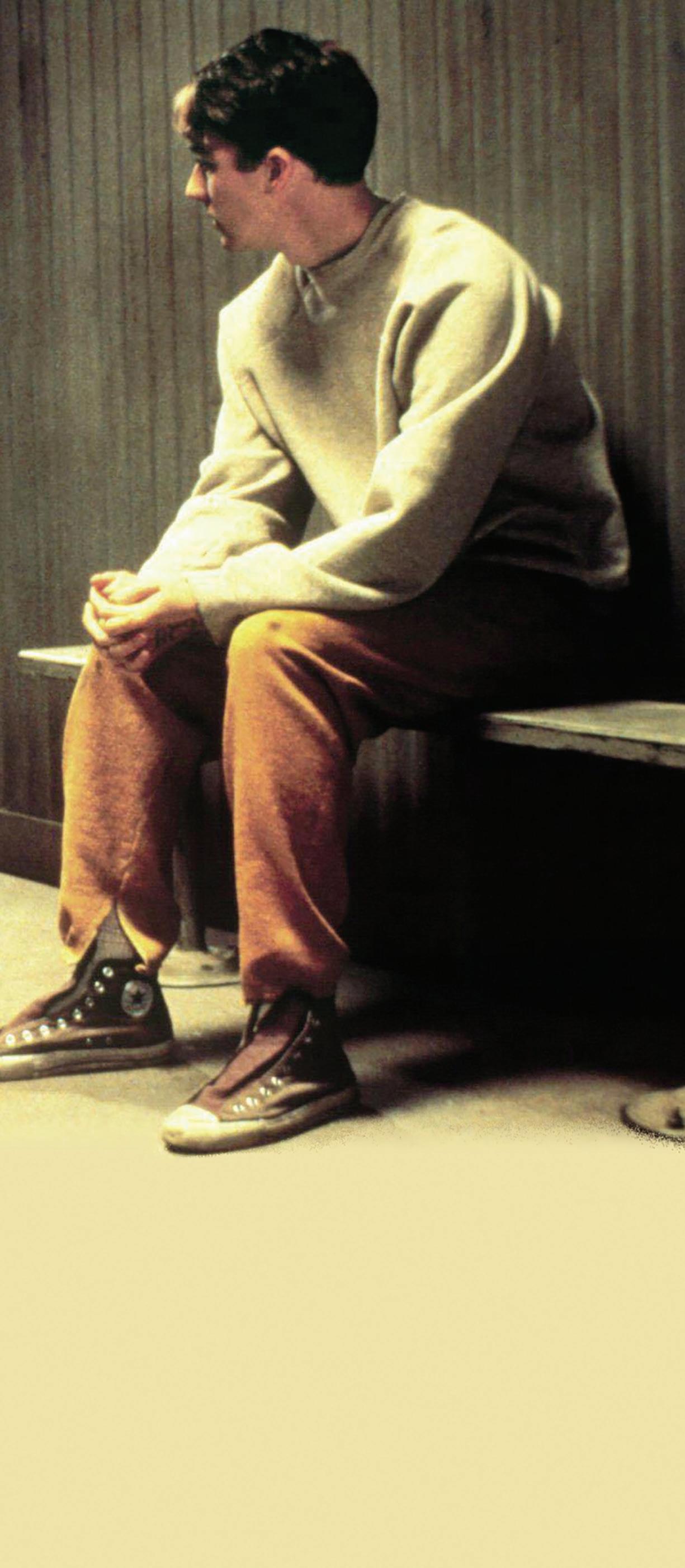
Perhaps showing my age, I finished reading the book, The Firm, on the eve of starting my articled clerkship. I saw the film soon afterwards. It didn’t help that my workplace specialised in tax law. I spent the first few months lost in conspiracy theories. Still, unlike Mitch (Tom Cruise), I never scored a house, a new car, had my student loans paid off, or scored a trip to the Cayman Islands. I might have swung to the dark side myself if I had Gene Hackman telling me what to do.
If you close your eyes and think of all the great performances (Hal Holbrook, Ed Harris, David Strathairn), one that stands out is Holly Hunter. A chain-smoking secretary, she becomes Mitch’s wing-woman as he tries to unpick the sorry mess he has found himself in.
To be frank, little—if any—of the action in this film happens in a courtroom. The lesson it provides though, is an enduring one: you can always win a case on a technicality. Winning is winning.
Bruce Springsteen’s haunting and melancholy "Streets of Philadelphia" won the 1993 Oscar for Best Original Song. The movie itself went on to become a classic. It was lauded for being the first Hollywood big-budget film to acknowledge HIV/ AIDS, homosexuality and homophobia. A lawyer (Tom Hanks) appears at work with a visible lesion. When fired by his law firm, he suspects the reason is because they know he has AIDS. He hires a homophobic small-time lawyer (Denzel Washington) who is reluctantly willing to take on a wrongful dismissal suit.
Roger Ebert considered the movie ground-breaking, likening it to Guess Who’s Coming to Dinner, the first film about an interracial romance. But, how often do you see Philadelphia available on re-runs? There was also a lawsuit brought by the family of Geoffrey Bowers which subsequently settled. Events in the film were very similar to the life of Bowers, an attorney who sued the law firm Baker and McKenzie for AIDS discrimination in one of the first such cases. Tom Hanks, when interviewed for the documentary, The Celluloid Closet, said that scenes between him and his lover, played by Antonio Banderas, were cut—including one of them in bed together. Despite the movie’s mixed legacy, Philadelphia was an important milestone.
Demi Moore, Kevin Bacon and Kiefer Sutherland. So, if by now you are not sure, this was a full-on Hollywood movie with megawatt star power.
Here, the courtroom scene is a court-martial. Two US marines have been charged with the murder of a fellow marine, Santiago. The defence team has an uphill battle. The term “code-red” suddenly takes centre stage. Finally, there is the big risk Tom Cruise must take when his legal strategy is at a complete deadend. He calls Colonel Jessup to the stand…
Okay, so courtroom “drama” is stretching it. But this is the movie that brought the ‘bend and snap’! Nothing was going to stop some members of the Bar News Committee from voting for it.
How to describe this giant of American cinema? Elle Wood (Reese Witherspoon) is a modern heroine. She
her way through, is independent, forms positive female relationships and of course, overcomes stereotypes against blondes. Naturally, by the end of the trial in her first court case ever, she is lead counsel and wins the day.
The ‘bend and snap’ scene, where Elle explains to her new friend, Paulette, how to get the attention of the UPS guy, has




“The Kid”, as the jurors call him, is a youth from the slums. His ethnicity is not specified but we know it is likely a factor. He is the defendant, charged with the murder of his father. The jury is composed entirely of white men. The deck is surely stacked against him. Enter Henry Fonda. The conflict occurs within one room. The jurors want to get on with it. The evidence is clear. Life awaits them outside the four walls. Come on already, let’s go. A vote is taken. There is only one person holding out. It is Juror No. 8 —Henry Fonda. The ensuing action is essentially the absorbing experience of watching how one man can turn a jury. The quietly spoken architect causes the jurors not just to test the so-called clear evidence, but their morals and values.
Jury duty is verboten for barristers, so this is the closest fly on the wall experience we can get.
Before featuring in those Shine Lawyers ads, Erin Brockovich was the eponymous heroine of the movie and even cameoed as a waitress. Directed by Steven Soderbergh, it was the vehicle which led to Julia Roberts’ best actress Academy Award. There is a court room drama at the centre of the movie. Erin’s diligent efforts find evidence that the groundwater of a small town in California is contaminated. There is a huge win involving a
settlement of $333 million, and a bonus for Erin of $2 million.
In the end though, it is the courage of the heroine, her cash-strapped status, her refusal to be ignored, and her insistence that she be given a job by her lawyer (played by Albert Finney) which leaves an indelible memory. In his breakout role, Aaron Eckhart as her boyfriend, George, is particularly charismatic. Some would say, the best thing in the film.

Sometimes you read books in school and wondered why the hell they made it onto the curriculum. James Joyce anyone? What is the point of all those long sentences? Then along comes a book that resonates with students. Even more rarely, that book becomes a great movie.
Harper Lee wrote a sensitive tale that deserves to be taught. The #BlackLivesMatter movement serves only to highlight the currency of the message. Gregory Peck, in one of the finest stories ever put to film, is beautifully cast as Atticus Finch. In 2003, the American Film Institute named Atticus Finch the greatest movie hero of the 20th century.
Atticus, a lawyer in small town Alabama, strongly believes that all people deserve fair treatment. He is appointed to defend Tom Robinson, a black man accused of raping a white woman, Mayella Ewell. He accepts the case, heightening tension in the town. His children experience racist taunts. Tom is found guilty, despite the persuasive arguments of Atticus. As Atticus exits the courtroom, the black spectators rise to show their respect for him.
There is more, of course, to the tale. Robert Duvall played “Boo” Radley, marking his film debut. This is a classic film. Dust off your old VHS tape and watch it.
The Castle scored double the number of votes of any other nominee. It is one of the greatest Australian films ever made. This courtroom drama is more than just ‘the vibe’. The legal question is vital: can the Government compulsorily acquire the Kerrigan’s Coolaroo house right next to the airport, for $70,000? If the Government is right, the family will be evicted from their home. The money offered could barely cover a small apartment.
What lies in the movie’s success? Is it the warmth of those quintessential Aussie battlers? Darryl Kerrigan’s poolroom? His neighbours or Dennis Denuto? Darryl is certainly the beating heart of the movie. But it is Lawrence Hammill (beautifully played by the late, great Bud Tingwell) who saves the day.
Lawrence has come to watch his son, a barrister, in court. He makes pleasant small talk with Darryl, who is awaiting the court’s decision after Dennis Denuto’s appalling advocacy. Lawrence is the breath of hope. He turns up at their home after the family has lost
the appeal. They are packing their bags, pending eviction. Lawrence reveals himself to be a Queen’s Counsel! He is interested in the Kerrigan’s case! This leads to a trip to the High Court in Canberra. It leads to section 51(xxxi) of the Constitution becoming part of the Aussie vernacular (well, almost).
The home, built on love and shared memories, forms part of impassioned advocacy. The end result is a court win, a life-long friendship between Lawrence and Darryl, as well as trips to Bonnie Doon (‘Ah, the serenity’).
If anyone thought any other movie was going to take top spot, “Tell ‘im, he’s dreamin'.”
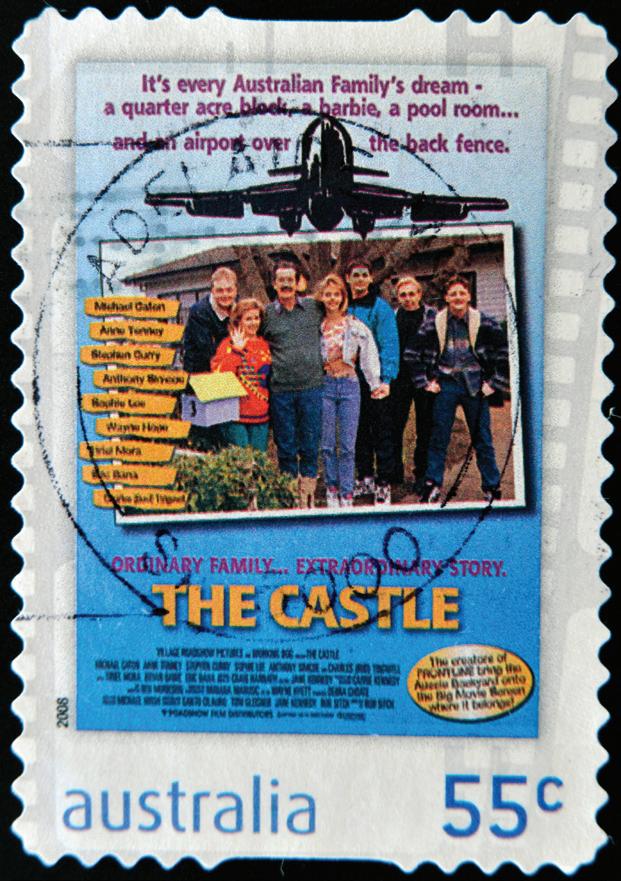
ERIK S. DOBER
Videolinks and internet conferencing tools have been around for years. The legal profession has been slow to adopt the technology. Until now. Now we have no choice. And it is likely here to stay.
Barristers can capitalise on their strengths as specialist advocates through effective use of the technology. This article sets out tips for how.
Your physical presentation in court matters. The same is true in a virtual hearing. But you have greater control over your appearance in a virtual courtroom than a physical one. There is opportunity to stand out. Here’s how:
» Dress as you would if attending court. It is a sign of respect. Some judges continue to robe for virtual hearings. Take their lead.
» Wear dark clothing. Patterns can have a distracting effect on video.

» Your camera should be placed at your eye level. Otherwise the view is likely to be unflattering.
» Ensure lighting is behind the camera and not behind you. Brighter light will improve the quality of the video.
» Your background should not be distracting. A bookshelf or your chambers in your background is fine if they are tidy. An alternative is to blur out your background or to impose a virtual background. These features are available in some technology platforms.
The intellectual preparation for a court hearing needs no explanation. You also need to prepare your technology.
» Test your audio and video in the chosen technology platform ahead of each hearing. Become familiar with turning your video on and off, muting your microphone and adjusting volume.
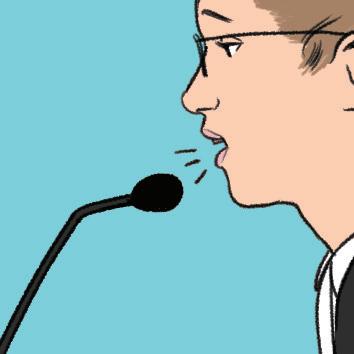
» Your audio needs to be clear so that people can understand you. Practise with a colleague so they can identify any potential problems. A common one is feedback where your microphone picks up the audio from the other participants and relays it to them. This is easily cured by wearing a subtle set of headphones.
» Have a strong internet connection. Video hearings drain bandwidth. If you have a poor internet connection, it is likely your video and audio will be spotted with
dropouts. This is a worst-case scenario for advocacy: that you cannot be heard at all. Bandwidth is shared with other users. If you are at home, make sure the kids are not streaming a movie at the same time you are conducting a hearing.
» Arrange to dial into the virtual hearing room in advance so that the parties can test the system before the presiding officer arrives.
The default in a virtual court hearing is to replicate the etiquette and rules of formality that apply in a physical courtroom. Here are some common issues:
» To stand or not to stand: Standing is generally preferred for advocacy. First, it conveys appropriate respect for the court; if the court officer asks you to stand, you must. Second, it is better for voice projection and therefore a powerful advocacy tool. Thirdly, it can also be a polite way of objecting or interrupting someone else. Why would you surrender this tool when you do not need to? However, there are pitfalls in an online setting. The most common is that the camera looks up a person’s nose when they are on their feet. Therefore, if you intend to stand whilst speaking, ensure you have set up your camera in a way that enables you to remain in view while seated and while standing.
» Eating and drinking: As with courtroom advocacy, food and drink—with the exception of a glass of water—should not be visible to the bench.
» Punctuality: Also, as with a courtroom, be in the hearing space before the judicial officer or arbitrator arrives. When in doubt, make contact with a court officer or associate beforehand to understand when you should dial in. You should only leave with permission or after the judicial officer or arbitrator has left. This is foremost a courtesy to the tribunal, but it also minimises any appearance of ex parte communications.


In recent times courts have introduced practice notes that address virtual hearings. These occasionally set out matters of etiquette. Check for practice notes ahead of each appearance.
Your existing advocacy skills should be employed during a virtual hearing. If anything, virtual hearings will emphasise styles of address. It will be more noticeable
than usual in a virtual hearing when a speaker is monotonous. Variety remains key. Variations in tone, pace and pitch will fall on grateful ears.
You may find it useful to have a slower pace and employ longer pauses than usual for virtual hearings. This will give you the opportunity to ensure the tribunal is following along and give them the opportunity to ask questions.
Discourtesy, interruption and aggression are each starker in a virtual hearing. Pay particular care if you are cross-examining witnesses.
Objecting during crossexamination can be difficult in a virtual hearing. The witness may have already answered before you manage to get the objection out. Accordingly, it may be the one exception where a fast, hard, loud “objection!” is important when the occasion demands.

Eye contact still matters. Know where your camera is and look at it (not at the screen). Place your notes close to your camera so you appear to be making eye contact whilst speaking.
A structured argument is ordinarily more compelling. In a virtual hearing, it is essential. At the outset, clearly articulate a roadmap for what you will discuss.
Your structure will be more obvious if you have provided a written outline ahead of time. Even if you may not ordinarily do so, consider providing a written outline of submissions ahead of most hearings. This should mean you are briefer when you are on your feet.
Use the new tools
Electronic presentation tools are not new. They are compelling—when they work. Virtual hearings can give you
far greater scope to employ electronic presentation tools. By using the ‘share my screen’ function that most of the platforms have, you can use any tool on your computer to enhance your presentation. Of course, you must obtain leave of the court before doing so.
Here are some useful ways you can employ the share screen function:
» Show a document in PDF or MS Word and speak to it
» Use in-built highlighting and typing features to draw attention to parts of the document in real-time
» Use annotation software—such as Epic Pen—to annotate anything at all on your computer screen: documents, websites, photographs, videos
» Use a PowerPoint, Prezi or other presentation. Using presentations has gone in and out of style. When used effectively, they can be highly persuasive.
Just as if you intended to use an electronic presentation tool in court, you need to discuss your plan with the court. Usually the associate will control access to the ‘share my screen’ function and you will need to give them advance notice if you want to use it. If you simply want to rely on
a document, provide it to the court (and, of course, your opponents) before the hearing; the associate can then manage its display. Of course, always make sure that you distinguish an aide memoire from evidence.
Following these tips will make you appear more confident in your virtual hearing. A confident advocate is a more compelling one. Do not cede that confidence. You would not attend court and say to your judge or the instructor that you are uncomfortable speaking publicly. The same is true of virtual hearings. Do not apologise in the hearing for your discomfort or inexperience with the technology. Just as in a physical court room, you will need to adapt when the unexpected happens. Show command of the situation.
Many of the tips above will be familiar. The principles of advocacy are the same. It is the application that differs. This means that virtual hearings are an opportunity for the Bar to demonstrate its specialist skills. Let it not go to waste.

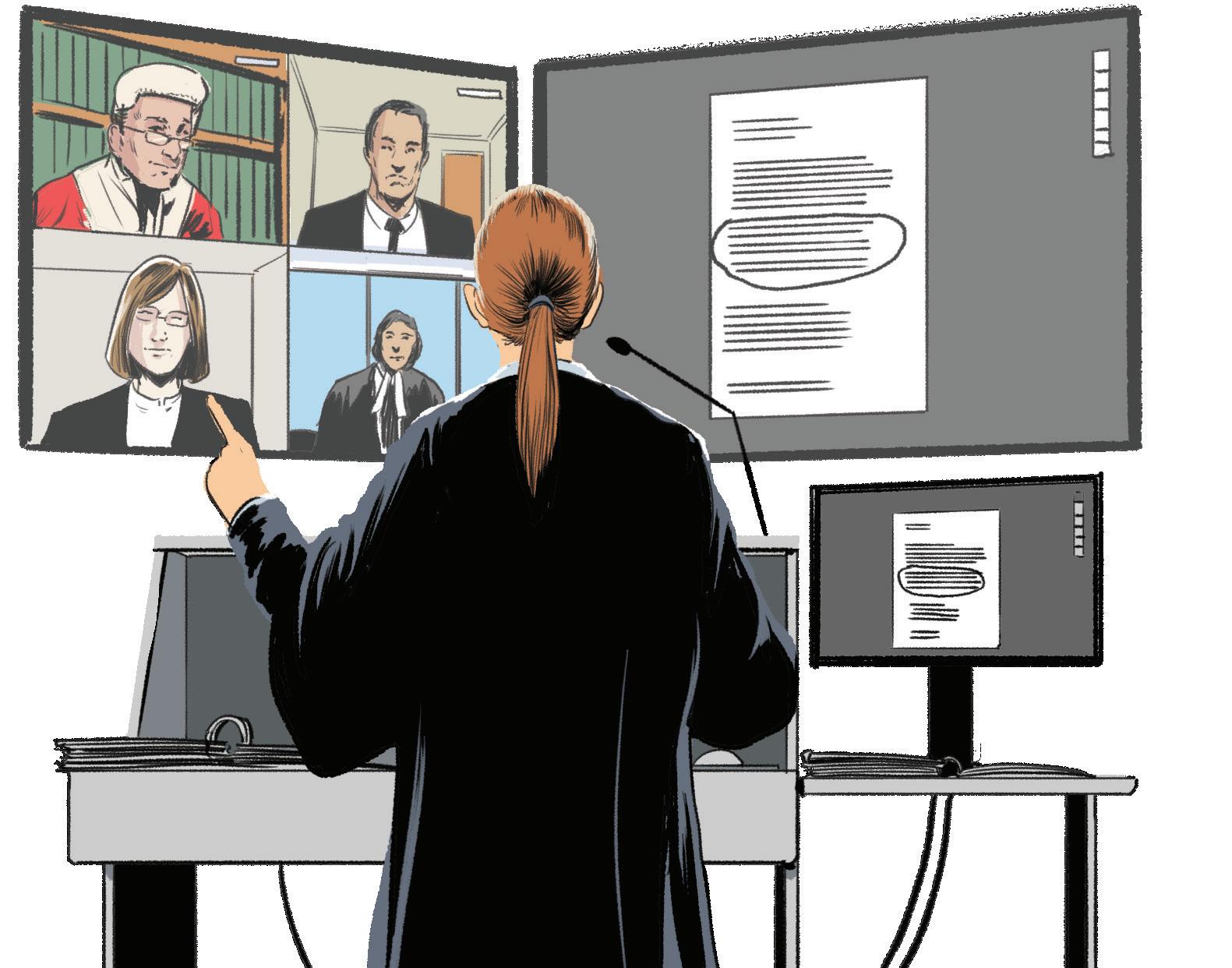


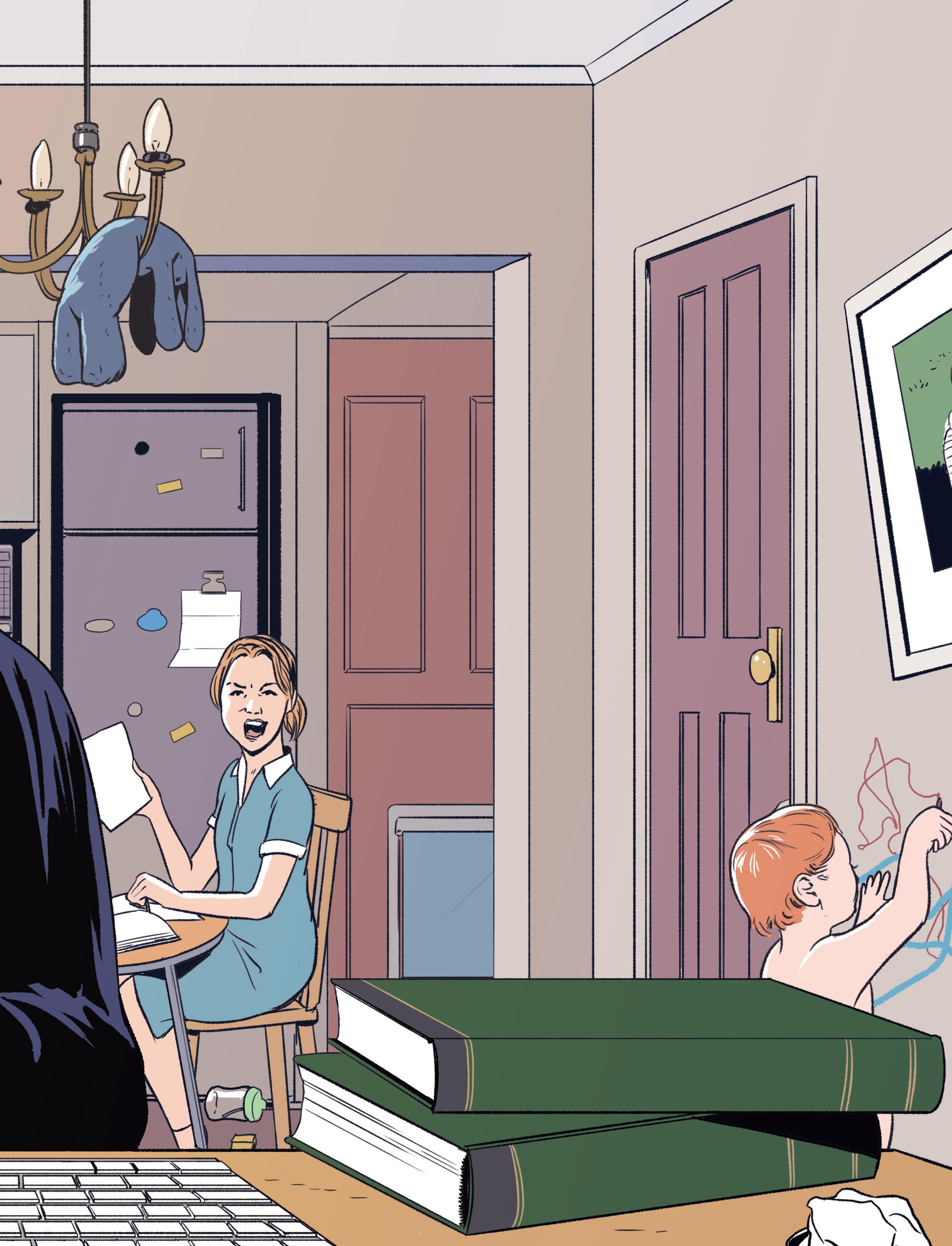
Our Victorian Bar in lockdown. Chaos, collaboration, determination, resilience, and fun. For our photo essay, read on!
Brenton Devanny – Following a Federal Court hearing this morning conducted without wearing shoes.

Ben Jellis –
“This is me ‘working from home’ in my home chambers.”

Campbell Thomson –
“The view from my desk.”
In April this year, a judge in Miami issued a broadside to attorneys who were dressing inappropriately on camera. His letter, posted on the Weston Bar Association website, referred scathingly to seeing lawyers in casual shirts and blouses. One male lawyer appeared shirtless. One female lawyer appeared still in bed, under the covers. Victorian barristers have also had to adjust to online hearing room etiquette, and to the challenges of working from home. Bar News put out the call for photographs of what this new life looks like. It appears everyone is fully clothed, which is a good start. The results are diverse and delightful. Thank you to everyone who contributed.
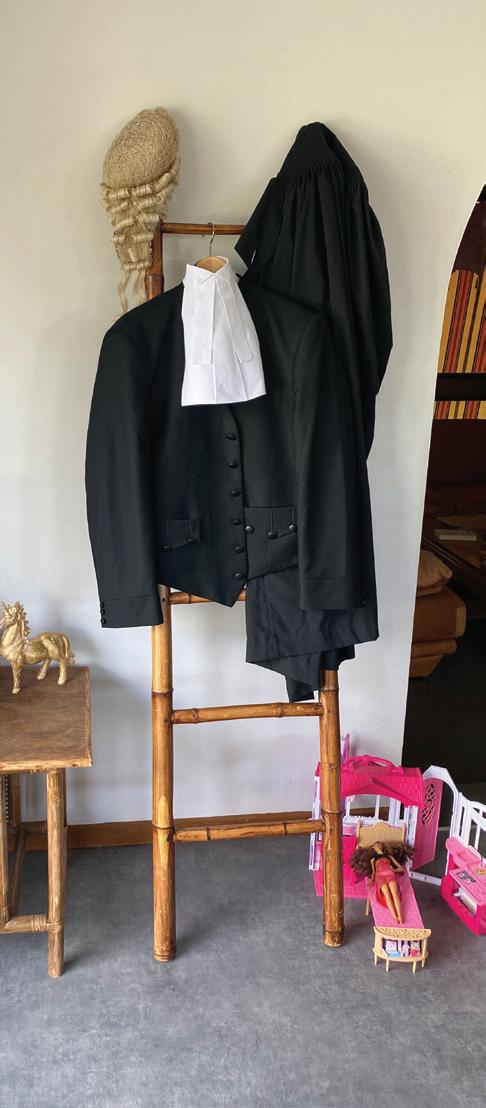

Michael Wise QC – Michael clearly enjoys all the gadgetry. The lighting and microphone are very ‘best practice’.


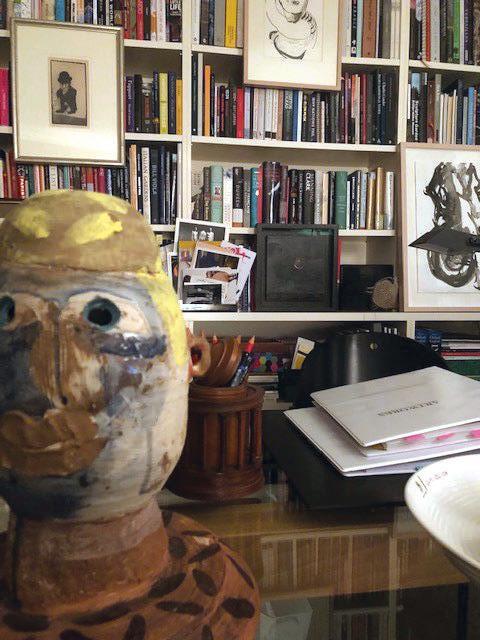
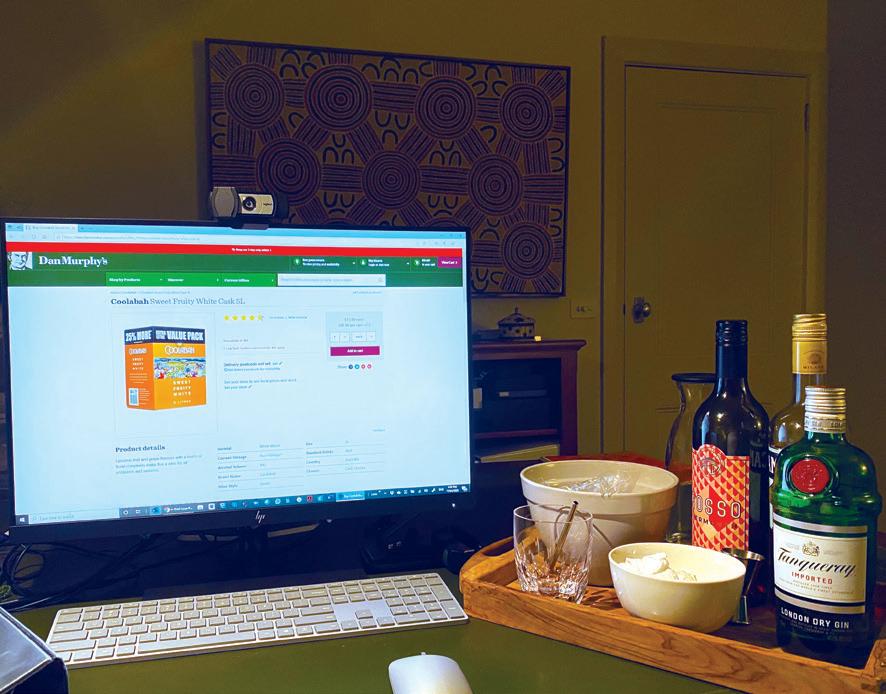

Ron Merkel QC leading Dr Laura Hilly – Ron Merkel addressing the Full Court of the Supreme Court of Tasmania in the matter of Cawthorn v Citta Hobart Pty Ltd & Anor. Laura reports that she and Ron appeared from “Court Room Level 22, Owen Dixon West”. Simeon Beckett from Sydney appeared on behalf of the Appellant. The Full Bench sat from either their home or chambers, with the Respondents appearing from Court Room 2 in Hobart. (With thanks to the Chief Justice of Tasmania for permission to publish.)


Jennifer Batrouney AM QC, with Moose and Minnie –“I have just had a judgment handed down via Webex from the Supreme Court in South Australia. The judge did not need to know about the slippers … (or Moose and Minnie).”
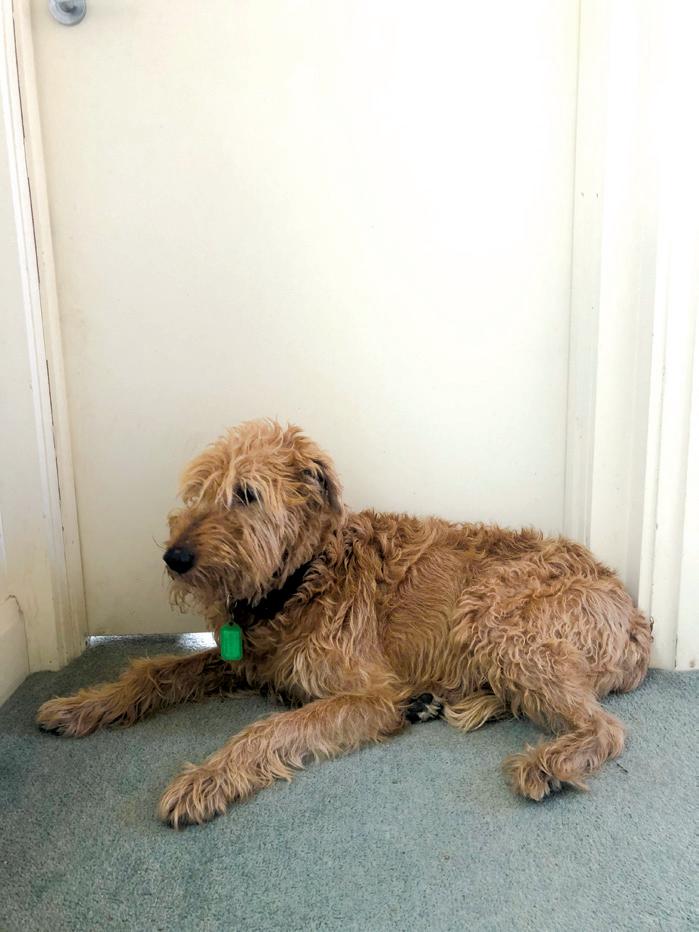

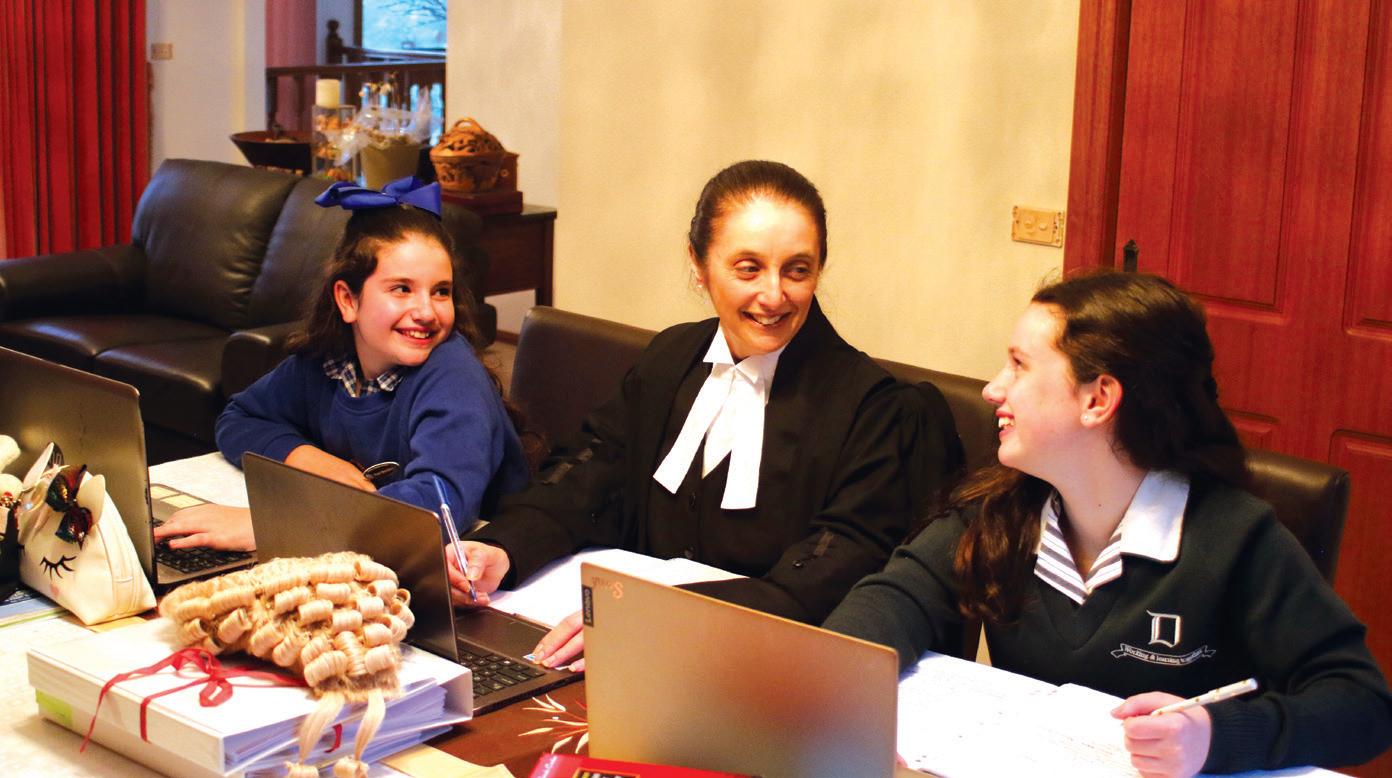
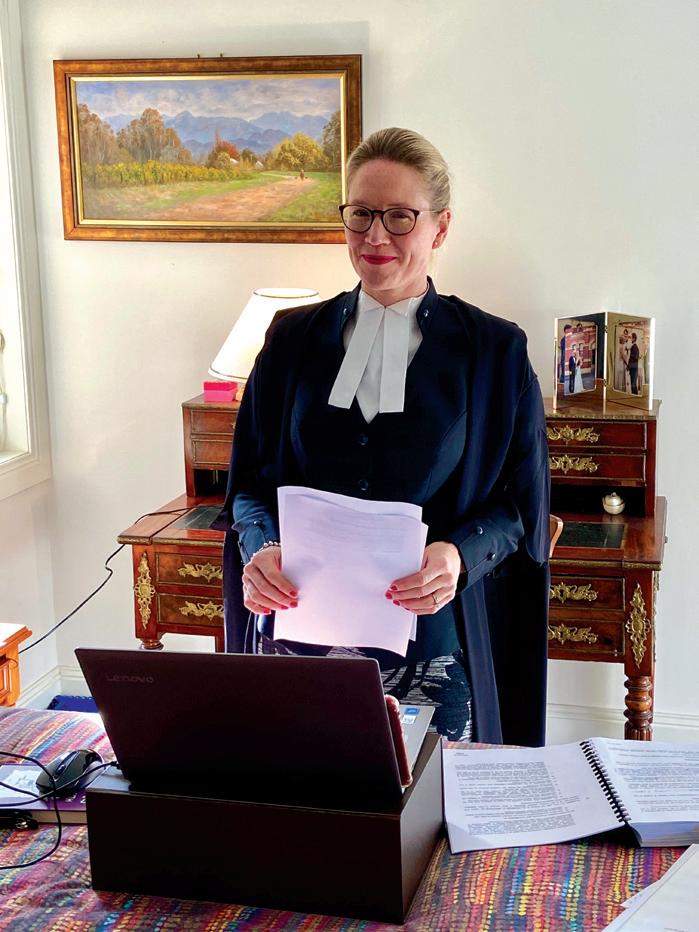
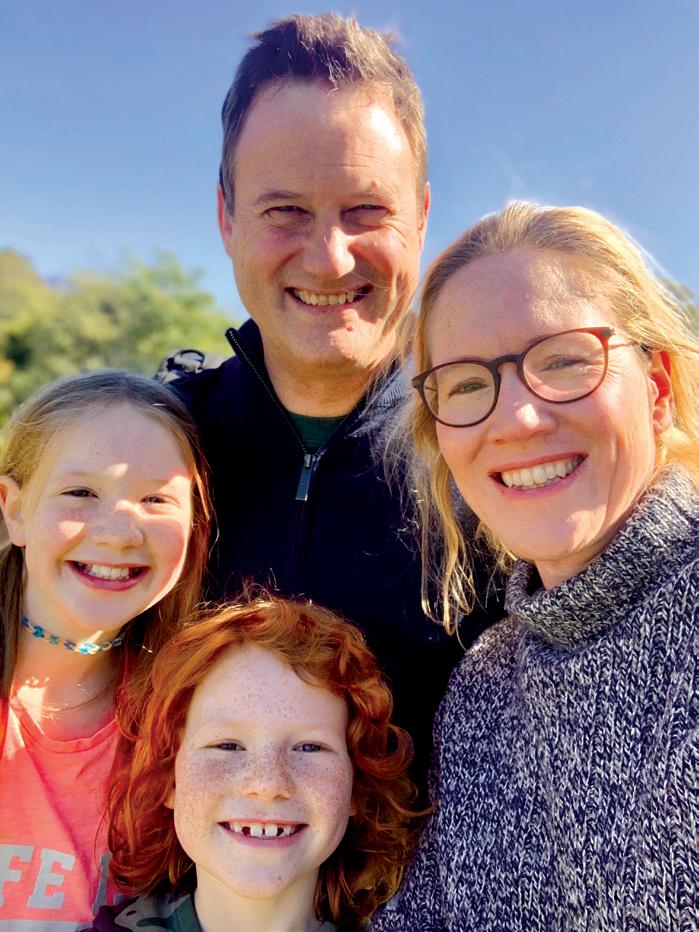




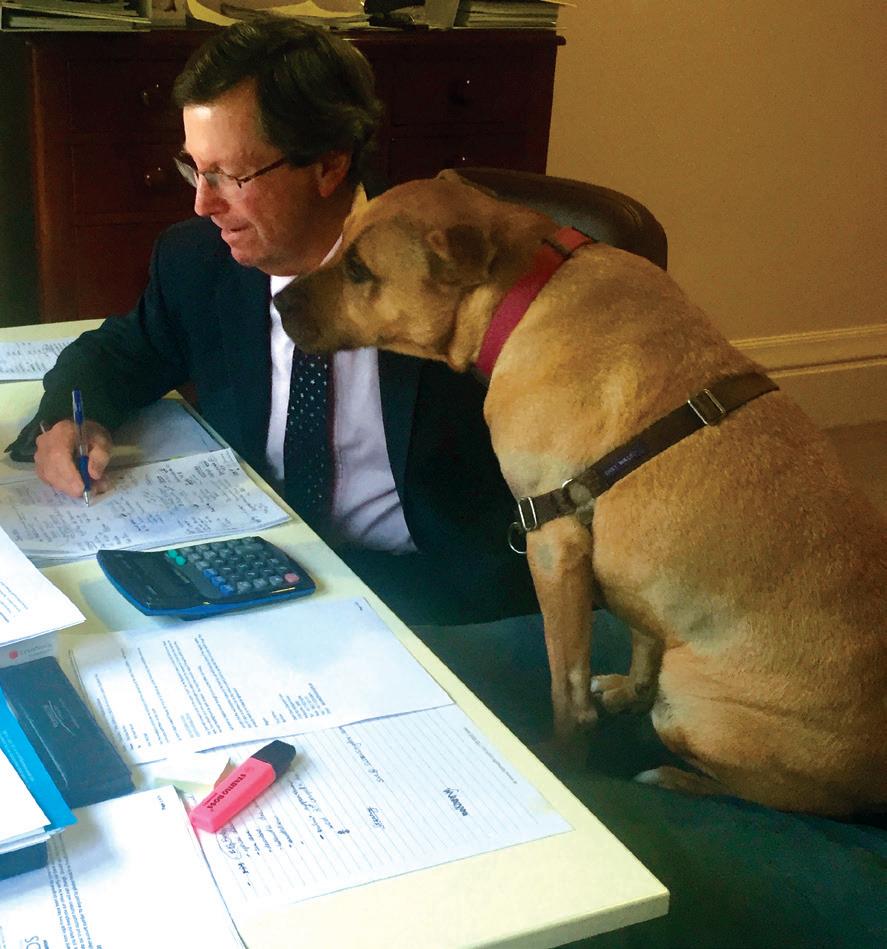


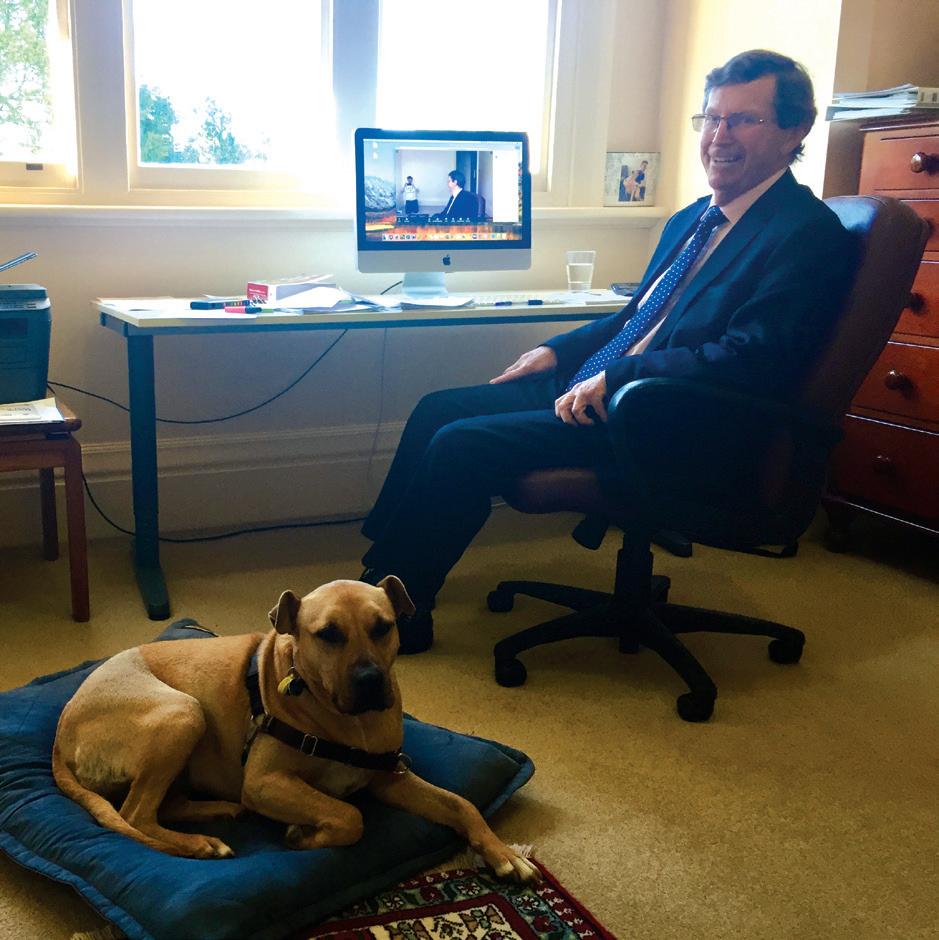
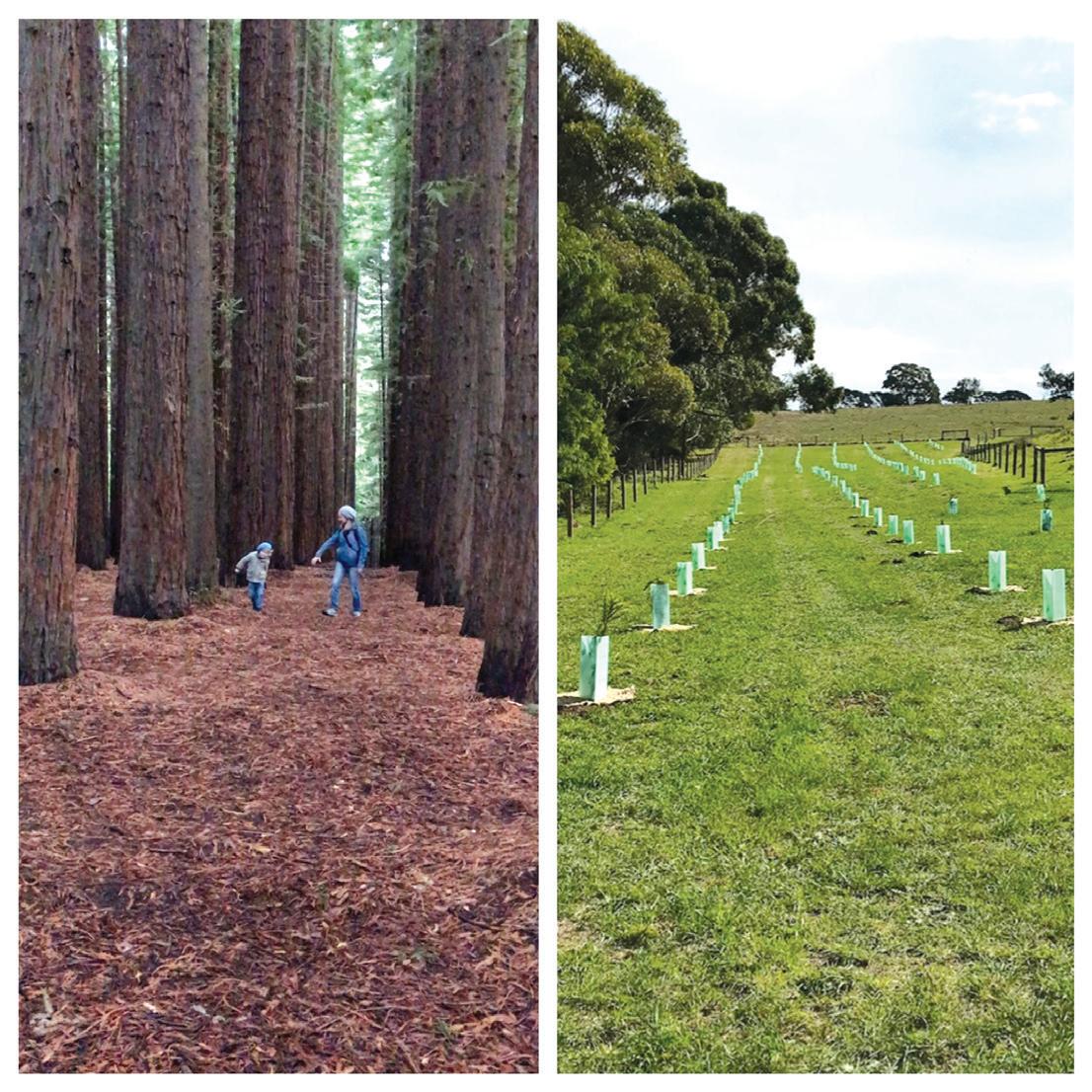
Chris Wren QC – “’The Inspiration for my Aspiration in my Isolation’—This has been my out-of-home-office distraction! Redwoods at Warburton planted in 1935 and their aspiring juniors planted in Flinders in COVID-19.”

Anna Svenson – “Working remotely from our farm in South Gippsland with my pet cow ‘Jersey Girl’.”
Michael Wood – “You can see my ‘PA’ named Abigail (known to her friends as Abby), a nine-year-old Staffordshire terrier who has been attending my Family Law mediations. Abby loves to join mediations so that she can make new ‘e-friends’ and ensure that morale is high for everyone. My only concern is that she will (perhaps understandably) ask for a share of my mediator’s fee, such is her popularity with counsel and clients alike.”

Daniel Nguyen – “My wife Kerry and I had fun staging some photos. These are with our recent additions Celine and George (both four months now).”
Natalie Campbell –“One-year-old Edith working from home.”

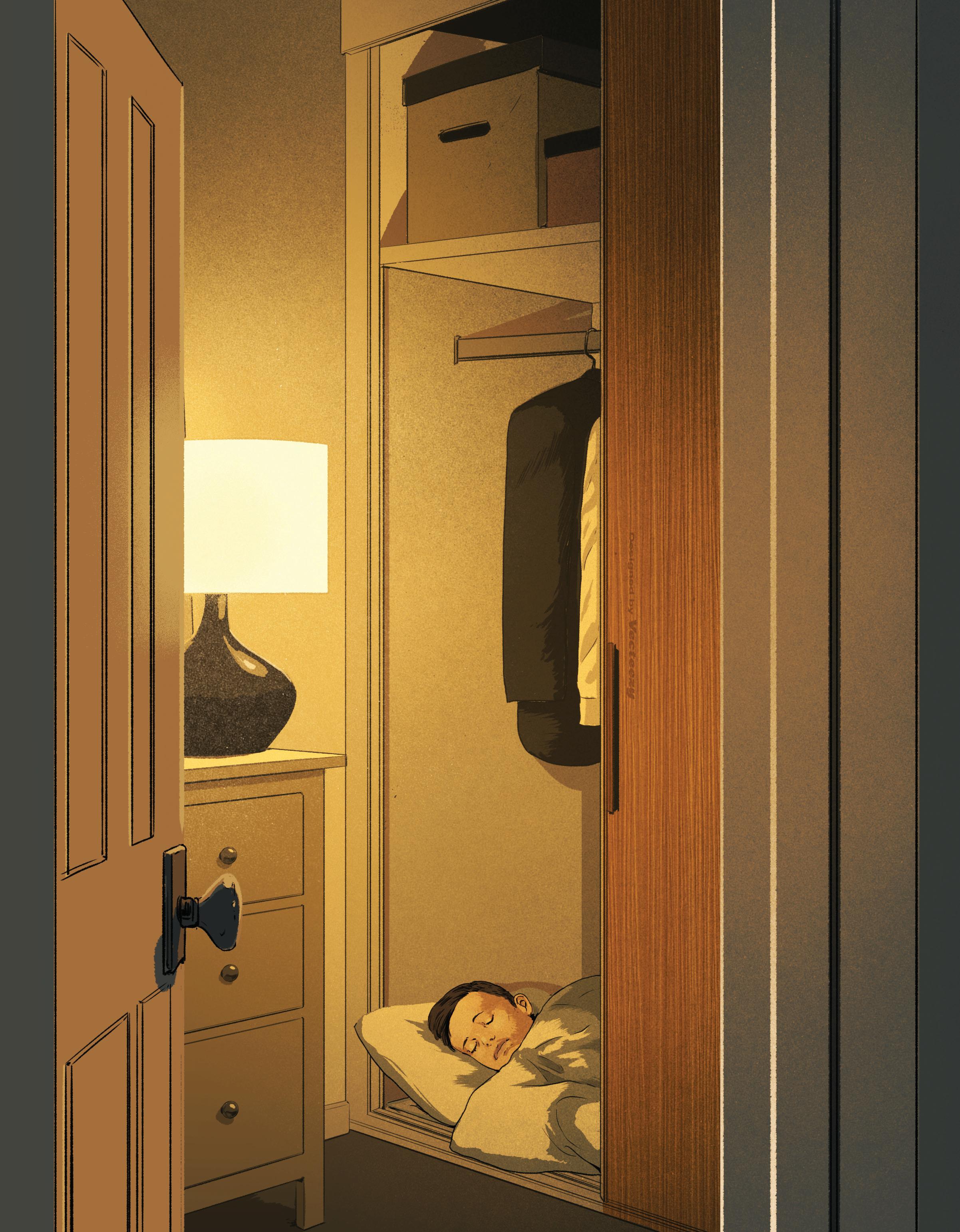
JOHN GURR
his is Fletcher; he’s been sleeping in my wardrobe!”
“Oh well,” the senior constable replied, smiling, “I guess he’s got to sleep somewhere.”
It was Friday, 10 April 2020, the third day in a row that the police had come to visit. The previous week, I had tested positive for COVID-19. The police were checking that our three boys were properly self-isolating. Somewhat anomalously, although our boys were required to isolate, my wife was not at least initially. Luisa had initially received a negative result for COVID-19, at the same time as I had tested positive. She was in the clear. Our boys, however, who had not been tested and had shown no symptoms, were required to remain in the house.
My COVID-19 experience had begun some three weeks earlier. I had come down with a persistent fever and chills. At first, I tried simply to work through it, fortified by increasing doses of Panadol. Eventually, however, the crushing fatigue forced me to raise the white flag. I sent emails to my instructors letting them know I would be out of action for a while and that some looming deadlines would not be hit. Their response (and from colleagues at the Bar) was both universal and humbling: health and family must come first. So, I slept. I was initially diagnosed remotely As I had not been overseas or otherwise exposed to a known case, COVID-19 was not suspected. I was advised not to present for testing. That changed, however, when a family friend, who had recently visited, received a positive diagnosis. Off we trooped to the Austin Hospital for testing.
The swab test is unpleasant, although mercifully quick. The test

stick reminds me of those long skinny sticks used to hold fairy floss at school carnivals. Open your mouth, stick out your tongue. Down it goes to the back of your throat for a quick scrape. Repeat in both nostrils for good measure.
I was lucky, in that I ‘passed’ and received a positive result on my first test. My wife was not so fortunate. As I was recovering, Luisa who had to date been fine also began to fall ill. Her symptoms were at the scarier end of the spectrum: fatigue, a dry cough and, most troubling, a claustrophobic shortness of breath, “Like someone sitting on my chest.” It was sufficiently bad at one point to warrant an overnight stay in hospital, with the requisite barrage of tests. Five separate times over two weeks, the fairy floss stick disappeared down Lu’s throat and up her nostrils. Five separate times, the swab came back negative. And yet, officially, the result was positive. By the end of it all, Lu had been at the Austin so often she was on first name terms with all of the staff on the COVID-19 ward.
I am convinced that, although unwell herself, Lu willed herself to remain symptom-free whilst I was sick, because we could not have afforded as a family to have both of us knocked out at the same time. It was only once I was on the mend that she gave herself permission to be sick. A real superwoman!

Lu and I have now fully recovered. Our boys were required to stay in isolation for two weeks after Lu was symptom-free. On 12 May 39 days after being locked in they were finally able to leave the house. During that time, they were brave, resilient and remarkably patient. Fletcher also had his sixth birthday in isolation. This year, however, his birthday party will be a little bit later than usual.

March
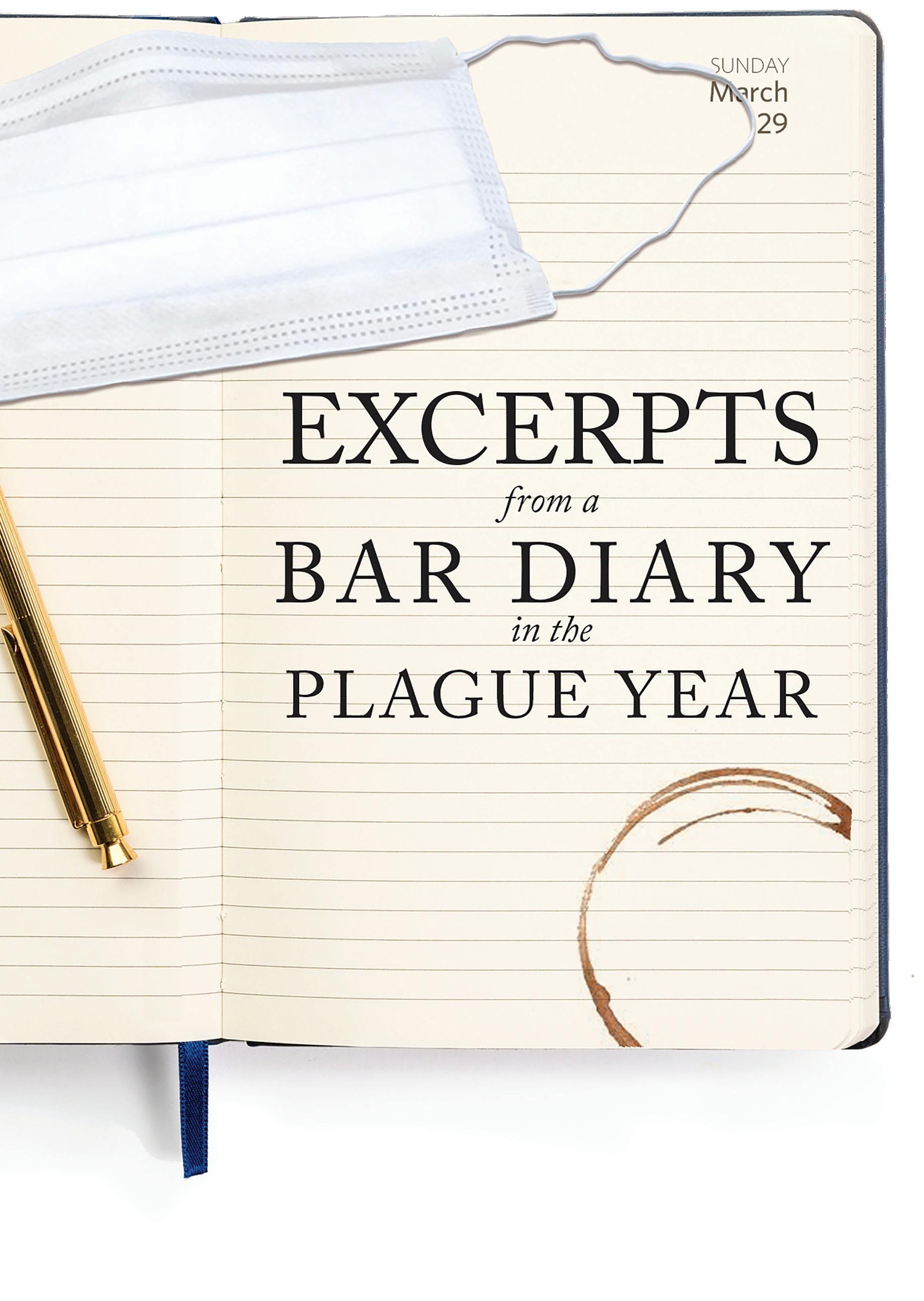
CAMPBELL THOMSON
29 0840 Cycle into chambers rather than taking the tram. 142 new cases of COVID-19 in Australia today. Overcast, traffic light. Stop at corner of Russell and La Trobe. Notice duckling huddling beside light pole. Look around. Cannot see its mother. Pick it up. Put it carefully in outside pouch of backpack. Intend to deposit nearer Yarra. Young woman approaches. Directs me around corner.

Near Little Lonsdale a disconsolate duck quacks next to woman from Parks Victoria, speaking into phone. Reunite duckling with mother, cycle on to chambers. Think apt metaphor for our times. We are not alone. Only feel like sitting ducks.
One day before Easter. April 9 First virtual plea in County Court. Associate sets up WebEx link, emails detailed instructions. Have used Zoom, have some idea of what to expect. Mate says appeared in Court of Appeal by WebEx and had to robe for the occasion so had to go to chambers. Found it difficult to get point across. Associate says judge will be robed and in court. We do not need to robe, can be anywhere with video link. Discard notion of hoodie & trackie dacks. Don pin stripe suit & most colourful bow tie. From Zoom experience, know location is critical. Set up laptop in bungalow, at same level as face (Mate’s tip: don’t have laptop camera zooming up nostrils). Behind me bright painting by Larrakia artist, Prince of Wales.
10
20 Join WebEx as instructed. Tipstaff on screen in court. Client beamed in from Barwon prison, co-accused from Metropolitan Remand Centre, in white & green T-shirts respectively. Haven’t seen each other since committal. They joke & skylark, pose for camera.
10
25 Crown prosecutor joins, in suit and tie & clearly in office at OPP. Counsel for co-accused enters jigsaw from chambers in robes.
10
30 Judge comes on bench. We all try to stand. Various cameras capture midriffs. Make virtual appearance. Associate takes prisoners’
particulars. Prosecutor would normally read out summary. It’s 16 pages. We all have it. Judge agrees to take it as read.
10
45 Judge invites me to speak. Emphasise difficulties in prison during pandemic: 23-hour-a-day lockdown, no visits, only urgent medical appointments, limits on phone calls and fear that if COVID-19 infects anyone, it will quickly spread. To speak to me by phone the previous day, client was frisked before & afterwards by prison officer without gloves or a mask. Social distancing in gaol next to impossible. Call client to give evidence about how & why he will rehabilitate himself despite recidivist past. On my feet, metaphorically,
April
14
0700 Radio National news: Tim Brooke-Taylor, Goodies comedian, dies aged 79 from COVID-19. Make partner tea and toast & return to bed. Check emails, Instagram, Facebook, Age headlines & New Yorker posts on phone. Partner & daughter say not safe to go to Vic Market.
0800 Vic Market. Park in empty car park. Go to regular stalls. Pay with card. Sanitise card. Giovanni, tomato go-to man, explains won’t let his elderly parents help out. Cleaners wander about with detergent sprays. Can’t hand over plastic or paper bags for reuse. Social distancing no issue: no-one here.
0935 Home. Cop criticism from daughter: bought nuts in
for 40 minutes. Halfway through, the video link with prisons drops out. We get some minutes’ down time until it resumes.
11
25 Mr X, counsel for co-accused, filed 13-page plea submission so if the video link breaks down, Judge will have what he needs to say. Mr X explains chaotic & violent childhood endured by his client.
12
50 Judge says Can I just stop you there, Mr X? Audio link has dropped out. Judge can see & hear Mr X. Mr X cannot hear Judge. Judge tries interrupting. Gives up. Mr X passionately explains how client’s father injected client with heroin at early age.
paper bags when she could fill containers at Source…
10
30 At desk in bungalow. Attempt appeal submissions. After two paras, watch Wallabies–All Blacks game from years ago when Wallabies won.
1300 Sandwich on back deck in sunshine. Partner asks when will prune creepers.
14
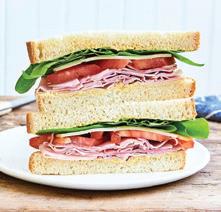
20 Ignore warnings re old guys & ladders, climb on roof & clear overhanging vegetation.
16
30 Bike-ride into city. Little traffic. Bodies in Carlton Gardens soak up autumn rays.
1805 Mitigate exercise with two Negronis.
13
05 Audio link resumes. Mr X realises this. Judge assures Mr X he will diligently read all tendered materials. Asks if anything of substance not in materials? Mr X summarises submission on appropriate sentence. Prosecutor takes five minutes in reply. Judge asks question. Prosecutor needs instructions. Texts instructor who’s elsewhere. Gets quick response.
13
20 Judge adjourns to date to be fixed for sentence. Hopes for week after Easter. Leaves bench. Stand & bow, expose midriff again, click “leave the meeting.” Stare at blank screen.
April 29 0900 Thank fates for trusty Rancilio Silvia espresso machine and grinder. Contemplate virtual travel through coffee beans from Peru, Java or Kenya.
0930 Prepare for two WebEx hearings. Decide on chinos plus suit jacket, shirt and stripy bow tie.

1030 Judge comes on bench after prosecutor, counsel for co-accused & I exchanged gossip, having joined meeting 10 minutes ago. Judge reads brief pre-trial ruling. Goes my way. Then revises another ruling. This cuts down the coming interlocutory appeal by half. Yippee…
Bored doctor son yearns for more drama in Alfred Emergency & texts link to latest Strokes album, New Abnormal
1910 Assist vegan daughter cook stir fried tofu and vegetables with red curry paste & coconut milk. Pretend rare rib eye steak.
2030 Debate TV viewing in living room: The Bridge, Great British Bake Off or Konchalovsky’s Asya’s Happiness? Watch Konchalovsky in bungalow.
22
40 To bed. Read three pages of Boswell’s Life of Johnson: when a man is tired of London, he is tired of life. Hope to be in London again some time this decade.
1130 Judge 2 comes on bench. Confirms presentence detention. Reads out immaculate reasons for lengthy sentences. Both prisoners upset. Judge and prosecutor leave so we can speak privately with clients. Counsel for co-accused agrees will be tough to overturn on appeal.
1300 Discuss prospects of appeal with instructor. Lament recent similar case with huge press coverage that must have impacted. Consider possible ground Judge did not properly take into account impact of COVID-19 on prison sentences.
1400 Bar News committee meeting by Zoom. Bar has decided can’t afford hard copy issue. Bummer. Discuss various digital formats. Run through prospective content. Fun catching up with pals, exchanging gossip.
April 30 1800 As Chambers Martini Maker, organised Zoom alternative. Cocktail shaker full of iced Negroni & bowl of olives next to laptop.
1805 Gabi comes on screen. We wonder if others will join, then ten more faces appear with champagne, various concoctions involving gin and juices, plus lime cordial for Fatmir mid-Ramadan. Toast Brind for 50 years at

Bar! Legend. Dion’s horse, Wings of Pastrami, runs its first Group 1 race on Saturday. Brind says he’ll take a plunge. Further toast for Sandip settling on new house. He whinges re defamation case about to
run live in Brisbane with no convenient flights. Keith says his pre-selection delayed by COVID-19 but reasonably confident. Secretaries leave our Zoom for greater virtual fun elsewhere.
1910 Big debate about loosening lockdown restrictions. All agree work will dry up. Brind gets call to dinner. All agree to repeat Zoom cocktails in two weeks. Waves & smiles all round.
May 8 0600 Alarm goes off but already awake, going over arguments. In tracksuit, make cup of tea. Draft opening remarks in long hand.
0700 Twenty-minute exercise routine. Cereal and orange juice. Shower and suit up with best shirt & bow tie combo.

0810 To bungalow. Organise materials around desk, plan for likely questions. Try to neutralise opposing submissions. Worry opening remarks gimmicky.
0945 Go online as instructed to contact court. Associate checks audio & video
OK, sends me to ‘waiting room’. Elderly client comes online from son’s house in Gippsland. My opponents—silk, junior and instructor—gather in big office at OPP. Justices Weinberg & Forrest link in from home offices in suits.
1015 President Maxwell in robes comes onto bench in Blue Court. Checks we can all see and hear each other. Invites me to speak. My opening remarks are a dialogue between two blokes in a pub to demonstrate trial would be abuse of process & should be stayed. Could flop badly but seems to work. Go through indictment to show problems with each charge. Extract principles from recent cases. List necessary jury directions to try to show absurdity of process. Justice Weinberg leans forward & asks helpful
leading question. His head fills screen. Justice Forrest remarks dryly, “That’s a line of argument for the closing address you hope you won’t have to make.” Finish, thinking could have been much worse.
1115 OPP silk argues trial in public interest, would be acceptably fair despite many years’ delay, missing witnesses, implausible allegations & prosecution witnesses that undermine their own case. Questions seem to indicate court not buying it.
1220 Silk concedes a specific error, still maintains trial should proceed. President thanks counsel, asks for comments on process, if technology adequate. Despite occasional frame freezes & brief audio drop outs, worked pretty well. Decision reserved. Reckon
am ahead on points but who knows.
1230 Throw off suit, throw self on couch. Sun shining outside. Have lunch on deck. Exhausted. So much energy exerted for such a short appearance.
1700 Gillies texts to see if on for Zoom drinks at 6pm with Boyce and Howden. Sure thing.
1800 Gillies on screen in suit from chambers with whisky in hand. His probate practice totally unaffected by plague. Boyce and Howden zoom in from home in T-shirts. My pink grapefruit daiquiri slides down nicely. Gossip exchange proceeds—who’s in, who’s out; what’s next…
1915 Gillies has to get home for dinner. Check Boyce OK for run next morning, wave goodbye.

FABIAN BRIMFIELD
Many of us are getting used to appearing in court by phone or video whilst safely ensconced at home or in chambers. I report back from the front line (or front-facing camera, as it were) after a few personal experiences.
Some weeks ago, I was briefed in a civil hearing in the County Court, to be conducted by Cisco WebEx. There were three solicitors, three counsel, the clients, and at times two expert witnesses. Each appeared by video, so on my screen there were up to ten little boxes with faces including those of the judge and his associate.
gesticulated wildly and pointed to her phone whenever she wanted me to look at a text she had sent me. That led to the comment from the bench: “Mr Brimfield, I think your instructor might be in pain…”. No judge, but I was.
Judges are not immune from technical maladies either. Spare a thought for Chief Justice Blow of the Tasmanian Supreme Court, who recently had to interrupt a Zoom hearing because someone was knocking at his front door.
“It can be tempting to adopt a nomde-festival. Just be sure to change it back to your real name before you use Zoom again for Court.”
The hearing, listed for a single day, turned into three days after an expert witness with poor internet connection was frequently disconnected. The judge eventually required the witness to give evidence in person.
I had told my instructor that if she needed to communicate with me, she could do so by using the instant message feature on the Cisco application. Instead, she
Lastly, a cautionary tip. Some of you may be using Zoom to host parties with your friends and accomplices on weekends or after hours: a perfectly reasonable and safe way to maintain contacts with others. It can be tempting, when engaging in such virtual gatherings, to adopt a nom-de-festival. Just be sure to change it back to your real name before you use Zoom again for court. Yours truly almost appeared as Anastasia Beaverhausen in the commercial court some days ago, only to change my name again just before the judge connected. Phew.
LUCY LINE
Igave birth to my firstborn child during the COVID-19 lockdown.
In the lead-up to the birth, COVID-19 was initially treated by my obstetrician as being not a big deal and a bit overhyped, and then, in a swift reversal as the virus spread to Australia, as a very big deal. It was a scary time. I had seen a YouTube video of a barber in China maintaining social distancing at work by performing a haircut using a razor attached to a broomstick—if I contracted the virus, would my scheduled C-section be performed by scalpel and broomstick? Whenever I attended the hospital for a pre-natal appointment and had my temperature taken upon entry, I anxiously awaited the result.
As the curve in Australia continued to ascend, increasingly stringent hospital policies made my pre-natal experience a little harder and more stressful than usual. As a precaution, my husband was prohibited from attending any of my obstetric appointments and scans, despite having no symptoms of the virus or risk factors. For a few long weeks, I was terrified he would develop a raised temperature and be forbidden from attending the birth.
Some of the anti-COVID measures I witnessed, no doubt implemented with good intentions, seemed farcical in practice. A receptionist at an ultrasound clinic sternly informed me, as I attended upon the reception desk to book an appointment, that I would need to ring her to book, as social distancing meant she was only allowed to book appointments over the phone. Sadly, my advocacy efforts on my own behalf, amounting to, “But I’m right here!”, failed to persuade
her to deviate from policy. Another time, at a late-stage ultrasound scan, I saw for the first time my child’s face in great detail. I was suddenly and unexpectedly overcome with the emotion of that moment. As I lay prone and wiped tears springing from my eyes with my fingers, the visibly alarmed obstetrician who was performing the scan blurted out, “Don’t touch your face!”
Paradoxically, COVID-19 brought us some meaningful benefits during this period. My husband, who usually works full-time in an office, started working from home in the weeks leading up to the birth. This meant that I felt very supported and we were able to enjoy some special time together in our last days as a family of two.
of prudence or malice. In any event, I experienced six hours of (technically unnecessary) labour. Surgery then commenced and I gave birth to a healthy boy.
In the five days I spent in hospital postpartum, I was not permitted to leave the ward floor, due to COVID. No-one was receiving visitors and a friend who tried to send me flowers was informed that the hospital was not accepting flower deliveries for patients. By day five, I was feeling newfound sympathy for, and solidarity with, cruise passengers stuck on COVID-stricken ships!

After our son and I returned home, my husband and I enjoyed the quiet and privacy the COVID lockdown brought, smothering our baby in kisses and doting over his every whimper and coo. This family time was so enjoyable that my husband declared that he hoped that lockdown lasts forever! It was a rare sentiment, I am sure.
My waters broke on a weekday morning five days before my scheduled C-section. At what used to be peak hour, the roads were all but empty as we drove towards the city hospital. Thanks to COVID, all danger of a movie-style birth in the car while stuck in gridlocked traffic was averted.
As I had spontaneously gone into labour, I had not fasted for surgery. When I breathlessly arrived at hospital, expecting “all systems go”, my obstetrician instead asked me to describe my breakfast menu, commented (gratuitously?) upon its significant size, and cheerfully announced to me, “Technically, we could commence surgery immediately, but my assistant obstetrician and I have had a conversation, and we agree that, because you’re a barrister, we will wait six hours.” It was not entirely clear whether this decision was born
We benefited from our friends’ lockdown-inspired cooking bonanzas, as they dropped their culinary creations at our doorstep. Flower deliveries and presents also arrived in a new lockdown style; Australia Post desisted from entering through our gate, instead electing to hurl parcels over our fence onto our deck; luckily baby items are all sturdily constructed. Floral deliveries took on the vibe of a teenage prank: a loud knock would be heard at the door and the florist would literally run away before it could be opened, leaving a (welcome) surprise for us to discover.
A couple of weeks after birth, I was back working from home, my newly flexibly working husband and I sharing child-care between our work commitments. Our son even featured in some Zoom meetings!
The COVID lockdown, a difficult time for many, will be, for my husband and me, forever coloured by the happiest and most meaningful event of our lives: the arrival of our son. We love you, William.
STORIES FROM ISOLATION
NATALIE HICKEY
There are only a handful of occasions when I have felt such shock and panic, combined with a sense that the future has lost all certainty.
The first time was when I was in Year 12. My school principal was shot through the rear window of his home. He was the victim of attempted murder. The news was a bolt out of the blue. It was on the front page of newspapers. We arrived at school to be told he was in a critical condition. His name was similar to a Family Court judge. People speculated it was a case of mistaken identity, or that a disgruntled former student was involved. We were frightened and worried. Our principal knew every student’s name and we cared a great deal for him. I also worried for myself. This was my last year of school. It was early in a year that had been thoroughly mapped out.

The next fortnight saw the Australian legal system in transition. I was due to start a trial. The judge instructed the parties not to hand up documents during the hearing; they were to be submitted by email one hour before the start time each day. Later in the week, the Chief Justice vacated all listings in the Federal Court. The trial was gone. I came home to tell my partner the news. He was watching World War Z on television. We watched Outbreak together over dinner.
Soon, working from home became the new normal for everyone. An instructor told me over the phone that when this was all over, we were either going to be ‘swamp rats’ or ‘smoking hot from all the incidental exercise’. She was the second instructor that week who told me she was still in her pyjamas. It was 11.45am.

The second time was on Friday, 13 March 2020. Events were being cancelled across the Bar. American actors Tom Hanks and Rita Wilson were hospitalised on the Gold Coast. Even the Australian Treasurer Peter Dutton had tested positive for COVID-19. The next day it was pandemonium at supermarkets and chemists. All the toilet paper had gone. A media report featured a woman who said, "there’s nothing left to buy at the shop except Gyoza. I’ve never eaten Gyoza". The terms ‘selfisolate’ and ‘social-distancing’ were ubiquitous on every news channel. That sense of shock, foreboding, of ricocheting from moment to moment, had returned.
I continued to over-shop at supermarkets. My parents had returned from the USA and were self-isolating. They needed me to shop for them. They were going through enormous amounts of orange juice and raspberries. The shelves were largely bare. A disembodied recorded voice told shoppers not to abuse staff at this difficult time. Could society be breaking down? I drove home one day with a boot of supplies I did not need. I felt quite rattled. My partner was working on a jigsaw on the dining room table. He looked up at me when I arrived with a calm air and relaxed smile.
Soon, I learned how to navigate online meetings via Zoom and Skype. Barely anyone wore make-up or

looked well dressed. It was such a contrast to our normal business wear. People worried about the mental health of colleagues. "She feels the pain of the world", shared one person with me.
As the months have passed, a sense of calm has returned. Our Stage 3 lockdown has become something less. The mood is one of re-emergence. Our grocery stores are fully stocked once more. We appreciate face-to-face contact. Restaurants are re-opening. I went for a walk and saw a hot-air balloon in the sky. The colour was a celebratory red. It was restorative. No one was ever charged for shooting my former school principal. He recovered from his injuries. Many years later, we caught up and had a chat. He had changed careers. Now, he was a marriage celebrant, presiding over the ceremony of a friend and colleague. Fortunately, his mind had been put to rest as to the identify of his attempted killer. A confession had been made to undercover police, although it could not be used in court. My school principal said he did not care and was grateful to know who it was. It meant members of his immediate family, all suspects at one time, were now exonerated. He told me that being shot had led to an epiphany for him. He changed his life as a result.

STORIES FROM ISOLATION
TEMPLE SAVILLE
Without a doubt COVID-19 has had an impact on every one of us. For some, more so than others. Some seven weeks on, I sit at my dining table, looking out my window observing the once busy Lonsdale Street and now see only a few cars. I wonder where we are at, and where we are going?
I confess that I found this situation quite difficult to begin with, the move to working from home, the uncertainty, the lack of control. However, time heals all wounds and things happen for a reason. Nowadays, I am content. I do not propose to write further about myself or my experiences in
this reflection. I want to briefly introduce you to the stories of Dr Lorna Breen and Kim Zambito, both courageous and worthy of serious thought and consideration.
Kim Zambito is a 29-year-old mortician from New York. She has been working throughout COVID-19 and observes that of recent times her work is different. Jonathan Blitzer of the New Yorker published an article on 22 April 2020 in which he describes Kim, her work and her feelings. It was usual for her to pick up two bodies per day before COVID-19, then it increased to six or seven being called in overnight. “All of a sudden, I’m only seeing people dying of pneumonia,” she said. The difficulties with locating bodies in what was described as “chaotic

“She was required to give up her days off; she would go home, eat dinner, walk the dog and then return to retrieve more bodies until midnight.”
refrigeration units” was noted and the electronic system for recording death certificates kept freezing from overuse. She was required to give up her days off; she would go home, eat dinner, walk the dog and then return to retrieve more bodies until midnight. By text message to Blitzer she described herself as “Feeling pretty depleted.”
Dr Lorna Breen died in April 2020 by suicide, her death was reported on various online news sources. She was 49 years old and the emergency room director at the New York–Presbyterian Hospital. She was working on the front line in the fight against COVID-19. Before her death, she had described to her father the “onslaught of patients who were dying before they could even be taken out of ambulances.” The New
York-Presbyterian hospital described her as “a hero who brought the highest ideals of medicine to the challenging front lines of the emergency department.” Dr Lorna Breen had not previously suffered from mental health issues but had been struck with and recovered from COVID-19. The Dr. Lorna Breen Heroes’ Fund has now been established to provide mental health support to healthcare providers.
Whoever you are, you too will have a story. Your story may be short, your story may be grand, or your story may be somewhere in the middle. Tell your story, hold your head high and tell it with pride. Make the time to listen to others, their stories are unique. These times and our experiences are something wilder than the imagination could conceive.


BY VERONICA HOLT
On 7 May 2020, 48 new readers signed the Bar Roll and commenced their practice, whilst the COVID-19 restrictions were on foot. They are the first readers to sign the Bar Roll virtually and start their Bar careers virtually. They are the first cohort to have experienced the readers’ course in a pandemic. When the course started on 5 March 2020, it started in the usual way: on level 1 of Owen Dixon East, where firm friendships were formed, WhatsApp Groups
were created, and reading and assessment material distributed. Within three weeks, the readers had transitioned to online learning. Here, we profile a few readers in this short, and by no means exhaustive, “readers’ digest”, about their experiences during the readers’ course. This piece reminds us that our readers are the future of the Victorian Bar. It important that we support them as much as we can going forward, whether it be through mentorship, devilling, bringing juniors into matters or facilitating solicitor introductions.
Tim Glass is in the hot seat on Who Wants to Be A Millionaire. $50,000 is on the line. The question: Who wrote the novel The Host? For some, this question might have signaled the end. But Tim knows the answer, thanks to his sister.
Tim knows that the author of The Host is the author of the celebrated (and despised) Twilight series. He can visualise the novel in his sister’s bookcase. Answer: Stephanie Meyer. Tim comes to the Bar having previously been a police prosecutor with Victoria Police, where he fell in love with appearance work. Over 18 months, whilst working full time, Tim enrolled, studied and completed his Bachelor of Laws degree at Victoria University online. Tim’s decision to come the Bar was in part due to his love of advocacy but also because he wanted to gain exposure
to work in other jurisdictions. As a police prosecutor, Tim worked predominantly in summary crime and wanted to work in higher courts and also in indictable crime and in defence work. Tim has significant experience prosecuting sexual offences, where he gained experience dealing with tendency and coincidence evidence. Tim is reading with Paul Lawrie and wants to cultivate a practice at the Bar principally in criminal and family law.
For Tim, studying the readers’ course online has been relatively straightforward, given that he did his law degree online. “It has been different to what I was expecting, but I have been engaged and have learnt a lot. There is autonomy of learning and there is flexibility which is important for me because I have an 11-month-old.” A highlight for Tim has been the Zoom Friday
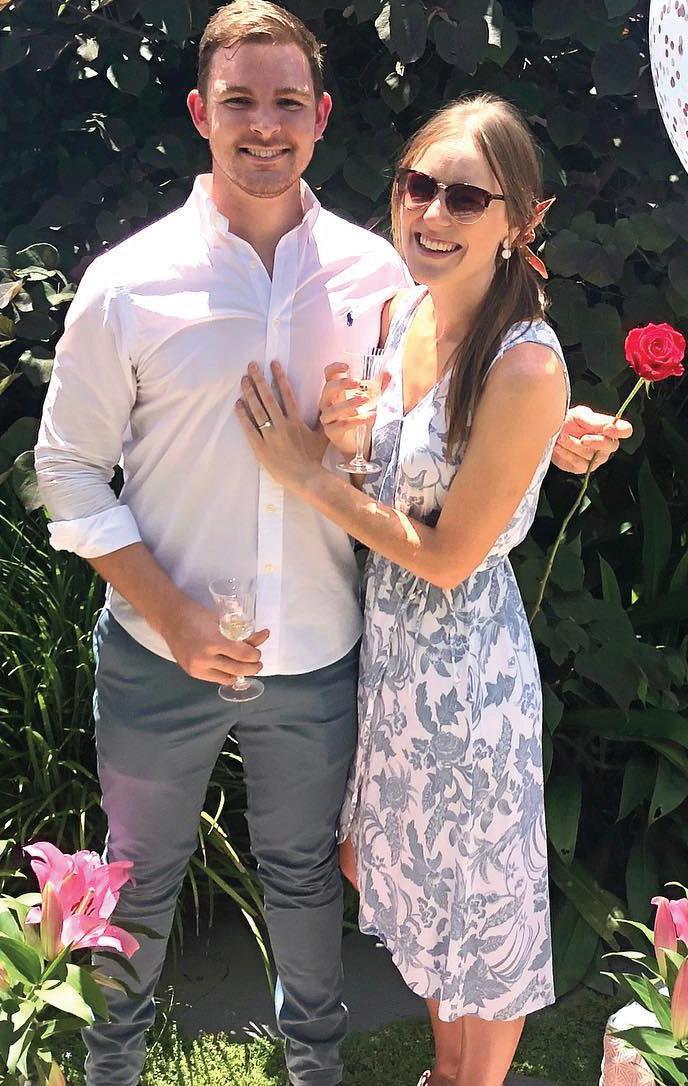
night drinks. “One of the readers has a paid Zoom account and on Friday nights, people tune in and out throughout the evening with a drink in hand for a chat. We’ve stayed connected and formed friendships this way.”
Tim is a serious Carlton supporter, loves cricket and watches American sport, including the NBA and NFL. He has missed watching sport during “iso” but Brooklyn 99 has provided some reprieve.

Tessa Duthie’s guilty pleasure (we all have them!) is The Bachelor. A fact that her fiancé, Richard Hampton, embraced when planning a The Bachelor themed wedding proposal in January this year. Flowers, ribbons, balloons, champagne and a speech to put previous contestants to shame found Tessa saying unequivocally “yes”.
Tessa comes to the Bar with almost five years’ experience as an employment lawyer at Gadens, where she was an associate in the employment advisory team. Tessa worked on a variety of employment-related matters, such as restraints of trade litigation, industrial disputes and unfair dismissals.
Tessa is reading with Marc Felman and intends to develop a predominantly employment and industrial relations based practice at the Bar. Tessa always wanted to come to the Bar, a view which was cemented when she went into practice and realised that “barristers do all the fun things”. For Tessa, the best part of being a lawyer was being in court: “All of my favourite days at Gadens were when I was in court, on my feet. I was really happy at Gadens; I learnt so much there. But it was time for a change and I always wanted to go to the Bar and it seemed like the right time for me.”
For Tessa, online learning through the Bar readers’ course has presented an invaluable
opportunity to gain exposure to online platforms and to develop online advocacy skills: “It’s been an important learning curve for me and I think it is important for readers to get familiar with the technology, because for the foreseeable future, this is how we will be conducting appearance work.” Tessa reflects that it has been incredibly
Uthra Ramachandran has 30 years’ experience as an Indian classical dancer. In 2019 she performed in Highlights of the Geetha Govinda and Parampara: The Making of Dance.
Uthra is no stranger to the turmoil of change. At 16, Uthra immigrated from Botswana and came to Melbourne, completing years 11 and 12 at The Mac. Robertson Girls’ High School. “I was a strange, exotic person, who had turned up from Africa and spoke a few languages, including Tamil, English and French,” recalls Uthra. “No one could place my accent. It was a combination of Afrikaner and British. Most people thought I was Canadian.”
Uthra went on to study a Bachelor of Laws and a Bachelor of Arts at the University of Melbourne. She started working at Middletons and was admitted in 2008. “I left shortly after I was admitted, because at that point I was already thinking about going to the Bar.” From Middletons, Uthra worked at the County Court of Victoria as an associate to his Honour Judge Howard (as he was then). This was the first time Uthra had been exposed to crime and she enjoyed the experience: “It opened my eyes to an area of law that I hadn’t experienced before and I found I really enjoyed it.” Uthra worked as an associate for a few years before taking up a position at the court as a researcher in both civil and crime whilst teaching at Monash. For Uthra, going to the Bar was always the ultimate goal. “It was just a matter of timing; but it was
easy to tune into lectures and that a significant volume of material has been covered throughout the course. Tessa also considers that online delivery offers a degree of flexibility and autonomy for readers.
Tessa has taken time during this “iso” period to do some of the things she did not have time to do before.
something that early on in my career I always wanted to do. Having had the opportunity to see barristers through my experience at Middletons and the court, I knew that’s where I wanted to be, but wanted to get more experience before going.” Uthra is reading with Sarah Keating and comes to the Bar as a generalist with experience in crime, commercial, tort and administrative law. Uthra is also interested in regulatory work and its intersection with administrative and criminal law.
The readers’ course has been an important stepping stone for Uthra and she is grateful that the course was not cancelled. It has had its challenges, she says, but overall?
In addition to running most days, as an avid The Bachelor fan, Tessa participates in former contestant Sam Wood’s daily live workouts from the comfort of her living room. Tessa has also rediscovered her grandfather’s hand-made crib board and taught her fiancé, Rich, the game she used to play with her grandfather as a child.
“It’s been great, we have flexibility and that’s important to me because I have children.”
In 2015, Uthra co-founded the Diverse Women’s Mentoring Association. Uthra is the current president of this organisation. Its purpose is to promote diversity of women in the professional services sector, including the legal profession, through networking, mentorship and leadership training. Uthra is also a board member of WIRE. WIRE is the only Victoria-wide, free generalist information, support and referral service for Victorian women and non-binary and gender-diverse people.
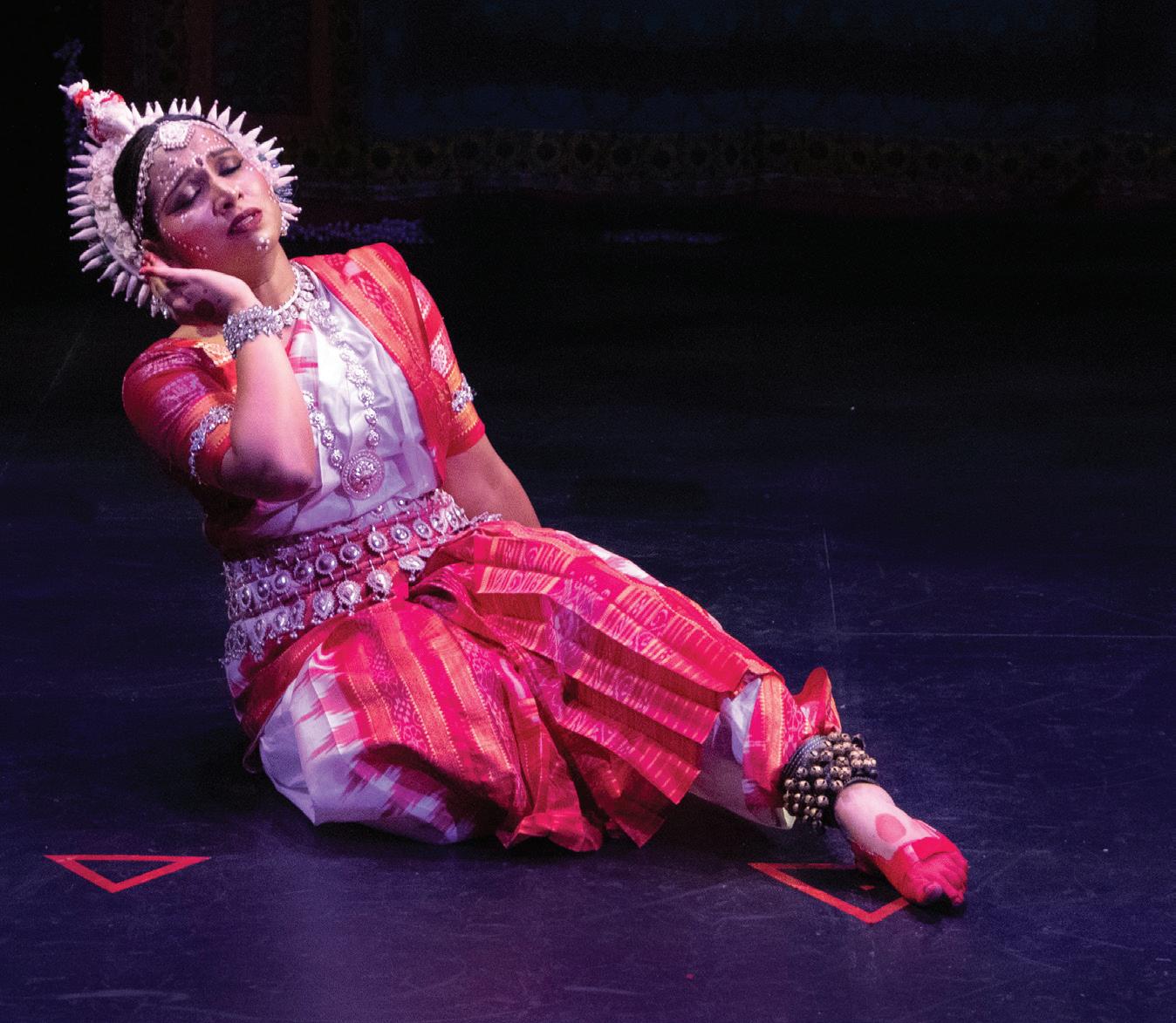
Priya Wakhlu is no stranger to juggling.
While working full time as an associate at HWL Ebsworth Lawyers, Priya was the convener for the 2019 annual Victorian Women Lawyers (VWL) Warren Moot and is a past VWL executive member. She was also a Rising Star finalist in the Big Law category for the 2019 Lawyers Weekly Women in Law Awards. It is no surprise that during her time in “iso”, Priya has taken on new challenges, including taking up running (which she now hates about “8 per cent less” than she did at the start of the stage 3 restrictions) and online yoga with an instructor based in India.
Priya comes to the Bar with almost six years’ experience at HWL Ebsworth Lawyers, where she worked principally in commercial litigation and defamation law. Priya’s work was largely trial-based and this exposure to trial work at the start of her career, led her to the Bar. “I did several moots at university, including reaching the finals of the
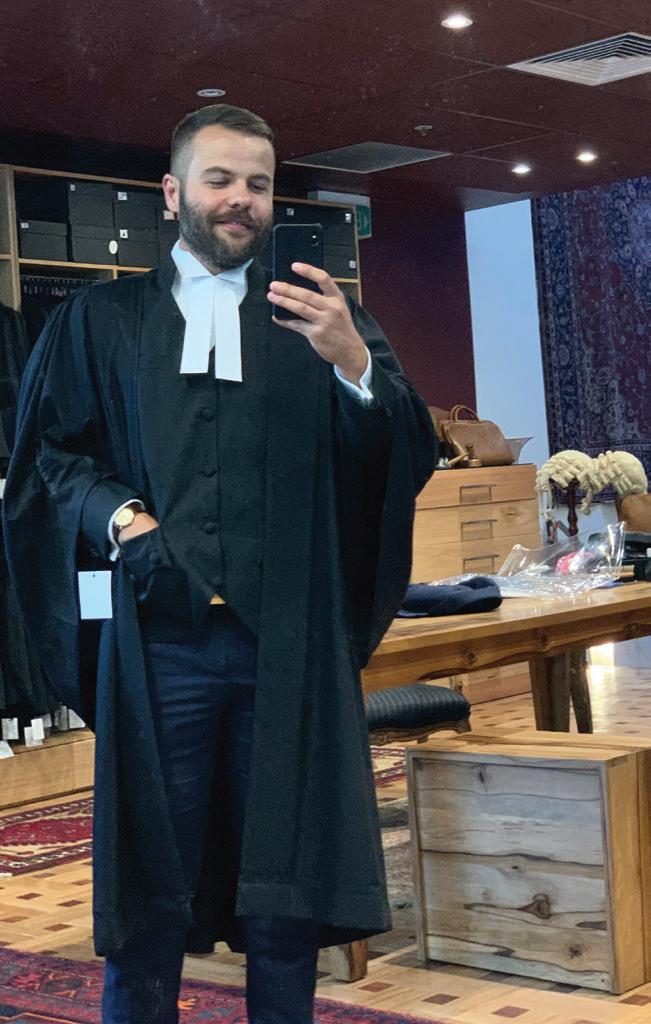
Willem C. Vis Moot, and the grand final of the Foreign Direct Investment International Arbitration Moot Competition, and I realised advocacy was something I was interested in. When I started working, I worked out quickly that barristers do all the fun work. For me, the Bar seemed like the natural career pathway.” Priya is reading with Patrick Noonan and hopes to develop a practice in commercial law and defamation law.
Priya has learnt a lot from the readers’ course, particularly in relation to oral advocacy. “We started with the Andrew Palmer QC week and, in the course of that week, I did a defence closing and also got the opportunity to cross-examine and lead evidence. There has also been a focus on online advocacy throughout the course and I have done a plea, a criminal moot and an injunction moot. These experiences have been invaluable, particularly given the transition to electronic appearances.”
Whilst Priya did not anticipate starting her career as a barrister from her dining room table, she is looking forward to signing the Bar Roll and getting started. “I am
excited to sign the roll and I am surrounded by good friends and family,” she says. Although, she is less enthusiastic about transitioning from her isolation uniform and back into corporate wear.

Not much in the March 2020 readers’ course was “normal”. We had our final assessment moots brought forward two months at around two hours’ notice just in case we went into lockdown, which ended up being the case. Suddenly all face-to-face sessions were cancelled and went online via pre-recorded videos or Zoom sessions. Even rites of passage such as the time-honoured trip to Ludlows took on a new cast. Here I am in March 2020, in an already empty shop, getting fitted for robes pre-lockdown. When the robes (and a wig) came back post-lockdown, Government restrictions on all non-essential travel meant they
had to be delivered to (my clerk) Tammy Young and kept safe until the restrictions were lifted. No photo with loved ones. No prancing about chambers in my new “drag.”
“ Even rites of passage such as the time-honoured trip to Ludlows took on a new cast. Here I am in March 2020, in an already empty shop, getting fitted for robes pre-lockdown.”
ADAM CHERNOK*
It’s been a little over a month since I’ve been home. My mate Westy died less than a month before that. Cycling into town for a party in Warrnambool on a Saturday night, he was hit by a ute. A few excruciating weeks visiting the ICU and then the funeral. After that, once the hangover cleared, I packed up the car and headed up to the South Coast alone. Lay off the turps a bit. Get my head straight. Camp each night. Surf as much as humanly possible. As it happened, I lucked onto a bit of swell that was hitting most parts just right. Westy was saying goodbye. I talked to him regularly on that trip. Bastard never answered back, of course. Not directly anyway. But there were moments where it did feel like I had a bit of luck on my side.
I finished up in Mallacoota for a few days. The waves that a couple’a local crew shared with me were some of the most memorable I’ve ever had. Not waves of any sort of consequence. Only three or four foot most of the time. Although there was one day when it really turned on. These were memorable waves because of the blokes that selflessly hooted me onto them. They had lost ’most everything in the fires. Then the virus took their livelihoods. And yet, they were welcoming and stoked and full of tall stories and local lore.
The soundbites of news I’d been getting were sounding progressively dire. Toilet tickets. Cruise ships. Lockdowns. Respirators. Mum’s been crook for years. And the old Rooster’s not far behind. So I pulled the ripcord on the trip early to head back to the big smoke and be near them. Could have done with another couple’a weeks at least. The trip was a necessary part of the grieving process for

me. Cut short. Since then, I can feel the itch to be back out there crawling around under my skin. Westy still hasn’t answered me.
Now I haven’t seen a eucalypt in weeks. Haven’t waxed a board. Haven’t woken up feeling creaky in a swag with my breath hanging in the air. No campfires for me. My skin’s not encrusted in a fine layer of salt. I haven’t sat, surrounded by jarosite and scrub and the blue, looking out to sea, waiting for a set. The insignificance I feel— caged in my home, effectively jobless, thinking about Westy, trapped in time—is very different to the feeling of insignificance I’m jonesing for so badly right now.
I got hold of one of those foam paddleboards clubbies use just before lockdown started. It barely floats me, is a lurid yellow and has a rubbery fin that makes the whole mess sway and buck when it catches a dribble of wind swell. I love the bloody thing. It’s probably the only thing keeping me from totally losing my shit.
It helps to suspend disbelief, of course. If you squint out the big smoke city that cradles it, it’s still a big sky down there on the water in the bay. I barely recognise that city skyline anyway, these days. I still make a point of doing a surf check, stand out on the stormwater drain at the end of the street and survey conditions for a bit. Ignore the fact I’m going to get in either way. Then a mad dash home to get the kook stick. “It’s pumping!” I shout to neighbours incarcerated in their front yards. “You going out, mate? Get amongst it!” I cop bemused smiles and headshakes— that nutter’s at it again.
The tarmac is a bush track fringed with melaleuca. The plane tree leaf litter underfoot is Gondwanan. The teddy bears put out in people’s windows morph into other
‘frothers’ [surf tragics] in the carpark. The Police Airwing chopper hovering over the beaches is a majestic wedgie scanning for a feed. Kerferd Road pier becomes a grand promontory. The rainbow lorikeets now visiting in great flocks are, well, they’re still cheeky lorikeets. But there’s heaps of them these days. And cockies. And sea birds. All of which I don’t reckon ever visited in the numbers they are now.
And then there they were. A pod of dolphins. Right fucken there. Right there in the bay on sunset, cruising. As ethereal as an apparition can be. But real. It’s as though they were saying, “She’ll be right. We can all be playful again soon. Everything’s gunna be okay.” The crescent arch of their dorsals as they dived. Their lazy ease. It brought a few amongst the gathering crowd to silent tears. But everyone there heard them. Everyone understood.
When that really big storm hit, the wind ripped across the bay like I haven’t felt in years. Huge surges thundered up the beach. It was up to the cobblestone retaining wall north of St Kilda. A couple of old blokes in dick togs and swim fins were having a body womp out there mid-arvo. Loving every minute of it. The storm had dumped piles of plastic shit all up and down the beach when I went out the next morning. That was a week ago, I think.
Months ago, I tried to get Westy out at Lorne Point when it was big
“I got hold of one of those foam paddleboards clubbies use just before lockdown started. It barely floats me, is a lurid yellow and has a rubbery fin that makes the whole mess sway and buck when it catches a dribble of wind swell.”
and solid and breaking all the way through. Westy’d just got himself a flash new wetsuit. Talked a big game. Then ended up going for a bash in the punishing shorie, just like the old blokes, while I paddled out. I got smashed. Westy had himself a grand old time.
I’ve been for a paddle pretty much every day since I got back. I’ve been watching the season slowly changing here too. The water’s not as cold as raw Southern Ocean swell, but it’ll do. I’m learning to read the currents better too; knowing when to give it gas and when I can just let the current do the work. I go out about 200m off the beach to the yellow posts marking the bathing/boating line and then paddle between them like a man possessed. I reckon I do a couple’a K a day, but I’ve got no idea, really. Could be just a few hundred metres. All I know is I paddle until my arms are cooked. Sometimes battling wind chop in the face the whole time. Other times it’s a mirror; looks like if you pricked the water with a pin, it’d defy gravity and geyser back into the sky. It always smells faintly of petroleum. Don’t get me wrong. I’m not going

to do the Molokai anytime soon. But by the time this is over, I reckon I’ll have the paddle strength of a Murray steamer.
I’ve lived by the bay most of my life. Aside from various defections north of the river, it’s always been close by. A stand in for the wild coast. An understudy. I read in the paper that what many of us are going through with this virus thing is a form of grief. Grief for the temporary loss of our normal lives. Grief over the loss of jobs. Or worse. Grief caused by uncertainty. Grief that the West Coast has been on the cook and I’ve missed it. Grief that the closest I’ve gotten to any juice is mindless scrolling and swiping. More grief? Fark! After Westy, I reckon I’m just about done with that. There’s a lot of good in all this. The natural world is sucking in a big relieved breath. My little community by the bay feels more connected than ever. And down the end of the road, there’s a mysto break that might just light up tomorrow.
* This article first appeared in White Horses. ‘Westy’ is a reference to James Westmore, remembered in the Back of the Lift section of this issue of Bar News.
FELICITY GERRY QC AND JENNIFER KEENE-McCANN
Transparent and knowable measures that err on the side of protecting human rights.
In theory, that is how the ‘rule of law’ governs, even in times of emergency.
In defining the ‘rule of law,’ the Hon Kevin Lindgren QC made this distinction: “The expression signifies not a legal rule, but more generally rule by ‘law’ as distinct from rule by power, free of legal constraint, whether by a democratically elected government, a tyrant or otherwise.”1 It is this rule by law that provides limits on the exercise of power. These limits are the basis for the protection of human rights.
Yet, in Victoria—as likely in most jurisdictions—the hectic push to flatten the curve has raised important questions about how and whether the state has considered the legal limits restraining it under the rule of law. We argue there is a lack of transparency in the operation of powers and it has largely been left to the legal profession and courts to clearly articulate such limits in order to protect Victorians’ rights to movement, health, and life—and that a ‘protection’ after-the-fact is hardly a protection at all.
The primary legislative instrument in Victoria relevant to public health emergencies is the Public Health and Wellbeing Act 2008 (Vic) (PHWA). It is under the PHWA that the State Minister for Health declared a “State of Emergency” and through which the Chief Health Officer

of Victoria (CHOV) was empowered to issue enforceable “Directions” and infringement regulations.2 The PHWA stipulates that the measures taken pursuant to it must abide by the principle of proportionality, which provides that decisions and actions should be proportionate to the risk, and should not be arbitrary.3
These stipulations largely reflect international limits on state powers to restrict enjoyment of human rights. Under international law, certain rights, such as the right to life, cannot be limited.4 However, for other rights, international human rights law accepts there will be exceptional circumstances in which those rights can be restricted. Under Article 4(1) of the ICCPR, these restrictions must be necessary, proportional, and non-discriminatory. ‘Necessity’ relates to the relationship between limitation of the right and addressing the emergency;5 ‘proportionality’ relates to duration and scope of the measures taken;6 non-discrimination relates both to how the measures are crafted and how they affect sections of society.7 The Charter of Human Rights and Responsibilities Act 2006 (Vic) (the Charter)8 provides similar ‘limits to limits’. If the limitation is not necessary, proportional, or non-discriminatory, those rights predominate.

There have been clear limitations on Victorians’ freedom of movement protected by article 12 of the ICCPR and section 12 of the Charter. The purpose of preventing COVID-19 transmission may be laudable but there was a lack of clarity on how limits to movement should operate, leaving significant discretion to the police tasked in Operation Sentinel.9 At the time of writing, Victoria Police have not released location data to determine how and where infringements have been given. Data in New South Wales indicates that marginalised communities are receiving the greatest policing during the pandemic with the highest number of infringements.10 This proportion of infringements did not correlate to rates of infection. Advocates suggest such a disconnect
is likely in Victoria as well.11 Is policing discriminatory? Without transparency, it is difficult to know. Kennedy provides an apt example of concern.12 Dwayne Kennedy—an Indigenous man, homeless, with significant vulnerabilities and whose sister died in custody in January— was arrested and issued with an infringement notice “for unlawfully being outside his place of residence during the COVID-19 outbreak”.13 Previously bailed and not required to attend court, Mr Kennedy was detained for two weeks. Significant intervention by lawyers was required to protect Mr Kennedy’s rights and secure his release.
In the UK, prosecution lawyers have reviewed finalised cases to the end of April. All cases under the
Coronavirus Act were found to have been incorrectly charged.14 No such review of policing has yet occurred in Victoria. Without transparency, governments are failing to assess whether policing is accurate and in fact Charter compliant. Against this background, rather than assess operations, worryingly, Victoria Police have pushed for expanded powers to continue post-pandemic.15
In limiting the freedom of movement for Victorians, there are limits on Victorians’ ability to assemble peacefully and protest, rights which are also protected under the Charter 16 An April car cavalcade protest against detention of asylum seekers in Victoria was issued more than $40,000 in fines for infringing Victoria’s ‘Stay at Home Directives’17 but a socially distanced protest at the Mantra Hotel on 16 May 2020 was allowed to proceed without fines. This is dangerously close to having to seek permission to protest which would be a derogation too far. The dangers for human rights defenders seeking to assemble have been graphically on display in Hong Kong, where lawyers have been arrested for not seeking permission to protest.18
Where protecting Victorians’ free movement places a negative obligation on the state, protecting Victorians’ right to health and life places a positive obligation to “take measures to prevent, treat and control epidemic and endemic diseases”.19 These measures are vital for protecting the rights of those detained by the state.
The right to health is reflected in Article 12.1 of the International Covenant on Economic, Social and Cultural Rights, 1966 and three more of the seven core human rights treaties signed by Australia.20 Comparative jurisdictions read a right to health into the right to life— notably a non-derogable right.21 A right to life is found in section 9 of the Charter and a right to health can be read into section 5.
The World Health Organization warned that prisoners and detainees are “more vulnerable” to COVID-19 than the general population22 and the UN High Commissioner for Human Rights has called on governments to take urgent action to protect the health and safety of people in detention.23
Despite public concern,24 Victoria’s pandemic response in the context of criminal detention has been to isolate and lockdown25 against a background
1 https://www.ruleoflaw.org.au/wpcontent/uploads/2012/10/LindgrenRule-of-Law-Its-State-of-Health-inAustralia-2012.pdf.
2 For greater detail, see the Quick Reference Guide for Victorian Lawyers produced by Raphael de Vietri and Felicity Gerry QC at https://www. lexisnexis.com.au/en/COVID19/ blogs-and-articles/a-quick-referenceguide-for-criminal-lawyers-in-victoriaduring-the-covid-19-pandemic.
3 Section 9 PHWA sets out the ‘principle of proportionality’.
4 International Covenant on Civil and Political Rights (ICCPR), art 4(2).
5 CCPR General Comment No. 29: Article 4: Derogations during a State of Emergency [3].
6 Ibid [4].
7 Ibid [8].
8 It is recognised that the Charter does not give rise to a cause of action in and of itself. However, a breach of the Charter can be litigated alongside an existing cause of action. Moreover, courts have some oversight of legislative measures through the interpretive rule in s 32(1). This rule provides that “so far as it is possible to do so consistently with their purpose, all statutory provisions must be interpreted in a way that is compatible with human rights”. See Momcilovic v R (2011) 245 CLR 1.
of existing concerns, particularly around the isolation of children. Of particular concern was the decision to regulate isolation through the Omnibus (Emergency Measures) Act 2020 (Vic) (Omnibus Act) which was enacted on 23 April 2020, the same day it was publicly released. Although guided by health experts, the Omnibus Act was subject to no advance public scrutiny, consultation or debate.26 Rather than controlled release of vulnerable prisoners to suitable accommodation and providing presumed rights to bail, the Omnibus Act provided increased powers, including judge-alone trials.
The importance of the state duty of care to prisoners was seen in Rowson.27 Mark Rowson sought orders to be released from Port Phillip prison on the basis of the risk of COVID-19 in light of his pre-existing health issues. Ginnane J restated the state
9 https://www.premier.vic.gov.au/policeout-in-force-to-keep-victorians-safethis-easter/.
10 https://www.thesaturdaypaper. com.au/news/health/2020/04/18/ compliance-fines-under-themicroscope/15871320009710.
11 http://www.policeaccountability.org.au/ policing/policing-the-pandemic/.
12 Re Kennedy [2020] VSC 187.
13 https://www.abc.net.au/news/202004-22/vulnerable-indigenousman-jailed-over-police-errorscoronavirus/12165342.
14 https://www.cps.gov.uk/cps/news/cpsannounces-review-findings-first-200cases-under-coronavirus-laws
15 https://www.theage.com.au/national/ victoria/police-push-for-expandedpso-powers-to-continue-postpandemic-20200520-p54uu2.html.
16 Under Section 16(1) and Section 15(2) respectively.
17 https://www.sbs.com.au/news/ melbourne-refugee-protesters-fined43-000-for-breaching-coronavirusrules.
18 https://www.theguardian.com/ world/2020/apr/18/police-in-hongkong-arrest-14-activists-amidautonomy-warnings
19 CESCR General Comment No. 14: The Right to the Highest Attainable Standard of Health (Art. 12) (44).
20 See also International Convention on the Elimination of All Forms of Racial
duty to take reasonable care for prisoners’ health28 and ordered an independent assessment to include the implementation of any recommendations. In a transparent corrections system, such an independent assessment would already exist.
In a society governed by the rule of law, there are legal limits to restricting human rights. Those legal limits are meant to be considered and respected by the State—the power of which those rights keep in check. Rather than considering and abiding by those limits, in a time of crisis when states should be vigilant to protect rights, Victoria has increased powers, resisted transparency and largely left it to legal action to check power and uphold the rule of law.
Discrimination, 1965 art 5(e)(iv); Convention on the Elimination of All Forms of Discrimination against Women, 1979 art 12; Convention on the Rights of the Child, 1989 art 24
21 See Case of Cyprus v Turkey, 25781/94, Judgment (Merits), ECtHR, 10/05/2001 [219]; Oyal v Turkey, 4864/05, Judgment (Merits and Just Satisfaction), ECtHR, 23/03/2010.
22 http://www.euro.who.int/__data/assets/ pdf_file/0019/434026/Preparednessprevention-and-control-of-COVID-19in-prisons and youth detention centres. pdf?ua=1
23 https://www.ohchr.org/EN/ NewsEvents/Pages/DisplayNews. aspx?NewsID=25745&LangID=E
24 https://www.greenslist.com.au/greensblog/jury-is-out-why-shifting-to-judgealone-trials-is-a-flawed-approach-tocriminal-justice
25 https://www.ombudsman.vic.gov.au/ our-impact/news/unlawful-and-wrongsolitary-confinement-and-isolation-ofyoung-people-in-victorian-prison-andyouth-justice-centres-ombudsman/
26 A discussion of the importance of scrutiny and the potential consequences of such an exercise of power will be addressed in a longer article.
27 Rowson v Department of Justice and Community Safety [2020] VSC 236 at [2] (Rowson).
28 Rowson [11].
SHANTA MARTIN
In times of public emergency, the state retains the duty to protect human rights, but what is the role of business? The impact of the activities of business enterprises during such times can be as significant as those of the state. Whether as employers, suppliers of goods or providers of services, business enterprises impact our daily lives in myriad ways. There are multiple instances of business operations
breaching human rights during these first few months of the pandemic, ranging from the machinations of companies involved in complex international supply chains, to the activities of small business operators.
By way of example, the operations of Melbourne abattoir, Cedar Meats, has been the source of one of the largest clusters of coronavirus infections in Victoria. The business was reportedly informed at an early stage that two workers had tested positive, but did not immediately
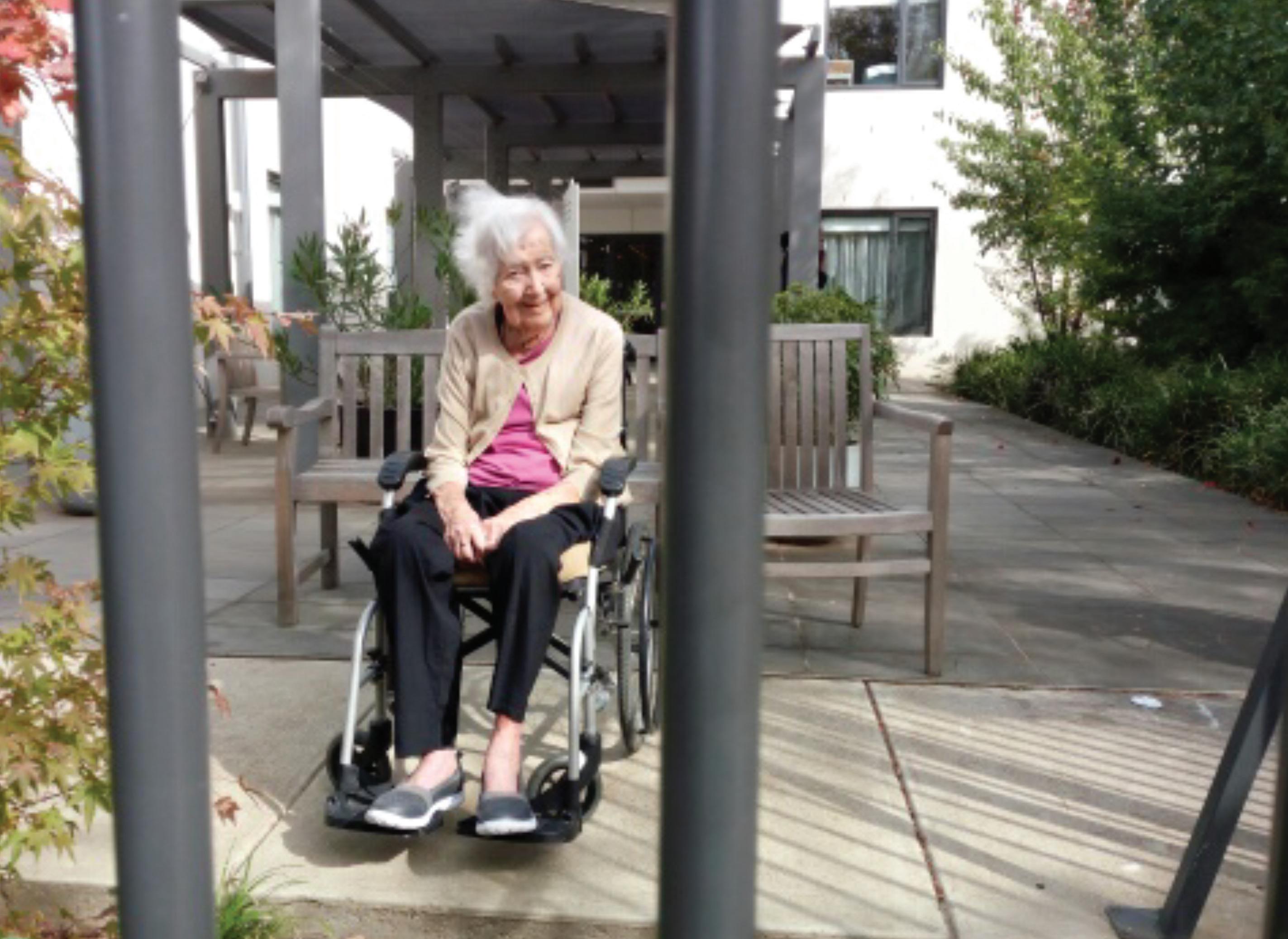
This is Berenice, a client’s mother. The photo was taken by Berenice’s daughter on Anzac Day, just a couple of days before Berenice turned 100 years old (Berenice is a WWII veteran and staunch pacifist!). For the last several years, she had enjoyed a daily visit from her daughter, who was usually Berenice’s only visitor. When the aged care facility instituted a complete lock down, Berenice was entirely isolated and for the first time in decades was not seeing her daughter at all. After sending some “lawyerly letters”, the facility finally allowed a brief visit on Anzac Day - but only outside through the bars of the facility.
“Perhaps now more than ever, governments need to reaffirm the responsibility of business entities to respect human rights”
inform its staff that they could stay away from work and did not provide face masks to those who continued to work.1 A worker from a non-English speaking background also reported being afraid the business would dismiss employees who chose not to work for fear for their health (which Cedar Meats denied). The response of the operators of Cedar Meats to the risks posed to its workers illustrates the heightened importance in a public emergency of business’s respect for the rights of employees to work and to safe and healthy working conditions.2
The impact of private operators on the enjoyment of other human rights during the pandemic is also apparent. For example, in the aged care sector, decisions of private operators have impacted the rights to health,3 liberty of movement,4 and freedom from arbitrary or unlawful interference with privacy, family and home.5 In Victoria, multiple private operators of aged care facilities have gone beyond government directions and placed elderly residents in complete lockdown, contrary to Care Facilities Directions issued pursuant to section 200 of the Public Health and Wellbeing Act 2008 (Vic) (PHWA). The Care Facilities Directions imposed some restrictions on visits by families to residents in order to reduce the risk of infection, but allowed continued daily visits. Those restrictions were time-limited and, in view of the vulnerability of elderly residents, arguably necessary and proportionate to the risk. However, some aged care facilities denied all visits despite there being no cases of COVID-19 and without instigating means by which relatives might visit residents in a safe and suitably distant fashion. Private aged care operators have also restricted the right to free movement of residents well beyond those allowed by law. The impact of the decisions of private operators on the human rights of residents and
families is clear; the limits have often been imposed without being timelimited or accompanied by sound and transparent analysis of the need for the restrictions, thereby potentially breaching the prohibition against arbitrary interference with the family; and the effect of complete isolation may have seriously compromised the mental and physical health of vulnerable seniors.
The Guiding Principles on Business and Human Rights, endorsed by the United Nations Human Rights Council in 2011,6 emphasise that states have a duty to protect human rights, while business enterprises have a responsibility to respect human rights, and both have responsibilities to facilitate access to remedy if rights are breached. Importantly, the UN Guiding Principles apply to all business enterprises, regardless of size, sector, location, ownership or structure, and the UN Guiding Principles apply equally in a public emergency.
While it is essential that businesses take steps to avoid infringing human rights during the pandemic, there is no doubt that states retain the obligation to protect individuals from undue interference with rights by private entities.7 In times of great uncertainty, such as conflict or public emergency, legislative and regulatory measures are often the state’s most effective means to protect people from human rights abuse by companies. The absence of mandatory measures can lead to uncertainty and a lack of adequate protections. In the aged care sector, for example, at present, neither the Victorian government nor the Federal government has imposed a requirement on private operators to demonstrate that the measures they impose are lawful, necessary and proportionate. Instead, government has preferred to issue non-mandatory guidance. Such a situation leaves residents and families with little power and a lack of means to compel respect for their human rights.
As business activities affect every facet of our lives, the actions of business enterprises can either bolster or undermine human rights. While some businesses will seek to ensure respect for human rights, others will not—whether inadvertently or deliberately. The absence of clear laws and regulations as to what conduct is permitted by business can easily lead to misconduct that has serious impacts on the human rights of individuals across all walks of life in Australia. During this pandemic, perhaps now more than ever, governments need to reaffirm the responsibility of business entities to respect human rights, including by ensuring effective laws to compel protection of those rights and to provide access to remedy if they are breached.
1. https://www.theguardian.com/ world/2020/may/08/cedar-meatsknew-of-two-covid-19-cases-forseveral-days-before-telling-staffthey-could-stay-home
2. International Covenant on Economic, Social and Cultural Rights, articles 6, 7, 11, 12.
3. Ibid, article 12.
4. International Covenant on Civil and Political Rights, article 12(1).
5. Ibid, article 17(1).
6. UN Human Rights Council, Human rights and transnational corporations and other business enterprises, July 2011, A/HRC/RES/17/4. See “Guiding Principles on Business and Human Rights: Implementing the United Nations ‘Protect, Respect and Remedy’ Framework” (2011), available at https://www.ohchr. org/Documents/Publications/ GuidingPrinciplesBusinessHR_EN.pdf.
7. See for example, Storck v Germany, (Application no 61603/00), 16 June 2005, in which the European Court of Human Rights interpreted Article 5(1) of the European Convention on Human Rights as imposing positive obligations on states to put in place measures providing effective protection of persons at risk, including reasonable steps to prevent a deprivation of liberty of which the authorities have or ought to have knowledge.
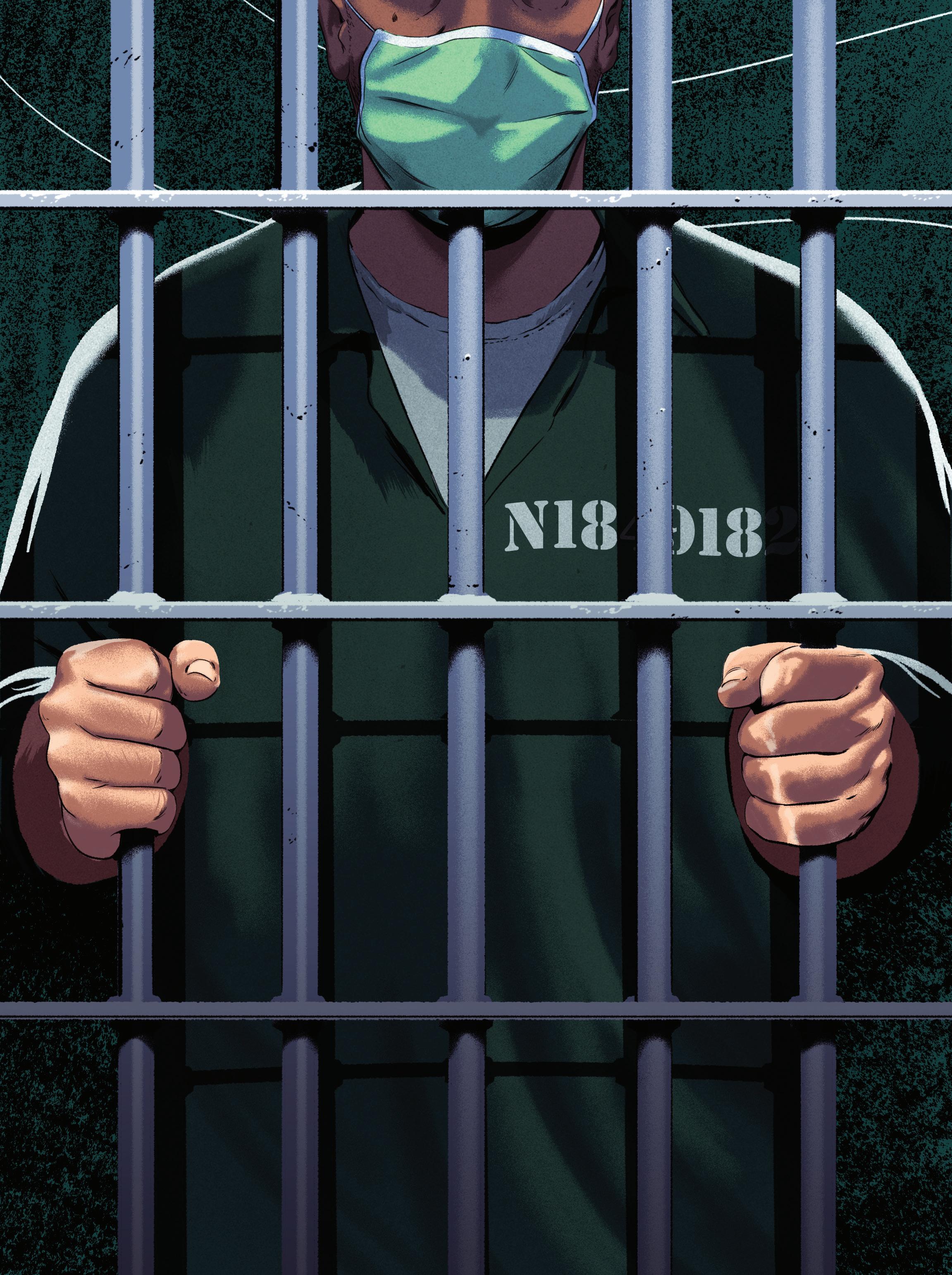
TRICHARD EDNEY
he global pandemic produced by COVID-19 has had pronounced and immediate impacts on the Victorian criminal justice system.
COVID-19 has been a factor in recent Supreme Court decisions to grant bail to accused on serious criminal charges1 Jury trials have been postponed for a considerable—and uncertain2—period3
Additionally, prisoners are enduring conditions of confinement that are more onerous than
would otherwise be the case and are unlikely to have physical contact with family and friends for the foreseeable future.
It is unclear when the Victorian criminal justice system will again be fully operational. But there remains a need for offenders to be sentenced for crimes in a COVID-19 environment. What follows is an attempt to comprehend what punishment might look like in this environment, especially for those who have committed offences that warrant a custodial sentence.
A cardinal principle under Australian sentencing law is that any punishment imposed upon an offender should be proportionate to the offence committed.4
Proportionality is basal to our system of criminal justice. Under modern criminal justice systems, ‘deprivation’—whether it be of freedom, time or money—is fundamental to penal sanctions and the measurement of ‘proportionality’.
Imprisonment stands at the apex of criminal sanctions. The ‘pains of imprisonment’5 are, in theory, confined to the deprivation of liberty and the necessary incursions into ‘freedom’ that inhere due to the nature of the prison setting.6
COVID-19 has caused a further and dramatic reduction in the freedom of prisoners in custody and the connection of prisoners to others in the outside world. In short, imprisonment has become more onerous.
Corrections Victoria (CV) responded quickly to the COVID-19 pandemic because of the grave consequences if an outbreak occurred within the prison system.7 That response was based on sound epidemiological science and conformed to an approach advocated by the World Health Organization for imprisoned populations, who are far more vulnerable to transmission of the COVID-19 virus.8
The prophylactic measures imposed by CV have meant the sequestering of prisoners, as far as possible, from physical contact with the outside world to prevent COVID-19 from being transmitted into the prison system. All physical contact between prisoners and their family members and friends
has ceased, following the suspension of personal visits on 21 March 2020. All prisoners who are remanded in custody are subject to an automatic 14-day quarantine period in lockdown.9 Partial lockdowns of the most populous Victorian prisons are in place. The ability of program providers to provide services to prisoners has also been severely compromised.
These ‘COVID-19’ prison conditions will likely be transformative of the experiences of prisoners and will make doing time harder. And even as restrictions and social distancing regulations reduce over time in the broader community, prisons are likely to be at the very end point of any such relaxation. So these restrictive regimes and this ‘harder’ time is likely to subsist for prisoners for a significant period.
Taking into account more onerous prison
What then should be the approach to sentencing offenders who have already served time, or are likely to serve time, under such onerous conditions, which are necessitated by a public health emergency and have nothing to do with a prisoner’s status or conduct in custody?
In the Court of Appeal decision of Brown (aka Davis) v The Queen [2020] VSCA 60, COVID-19 was raised as a matter to be taken into account in re-sentencing. Justices Priest and Weinberg described themselves as being “hesitant to express a general statement of principle regarding how this court (and others) should deal with this crisis as regards its effect upon relevant sentencing principles”. They did, however, accept “that the situation is causing additional stress and concern for prisoners and their families, as it is for every member of the community”. Their Honours ultimately concluded that “the extent to which that may be taken into account, if at all, will be a matter to
be resolved on the particular facts of any individual case.”10
One possible way to take into account onerous prison conditions is to ‘modify’ the proportionality principle on a temporary basis so the nexus between the punishment and the crime does take into account COVID-19 prison conditions. Onerous conditions of confinement have, in certain circumstances, already been recognised as a legitimate matter in determining the length of a prison sentence for an individual prisoner because of that prisoner’s particular characteristics.11 There is, therefore, some existing recognition of the ‘modification’ of the proportionality principle on the basis of prison conditions.12
Of course, COVID-19 prison conditions are different because they are necessarily indiscriminate and apply independently of any particular characteristic of a prisoner. Any mitigation because of COVID-19 prison conditions should therefore be of broad application.
The onerous prison conditions instituted by CV have been put in place to benefit prisoners and staff. But a wider utilitarian benefit also divests to the Victorian community. The bearing of such a cost by prisoners doing ‘harder time’ for the wider community is a matter that ought to be recognised in the sentencing calculus. To that extent, the operation of the proportionality principle should be adapted to account for the harsher prison conditions produced by COVID-19.
The benefit of this modified proportionality analysis is that it can be used as a legitimate and practical justification for the Victorian criminal justice system as it deals with COVID-19. It also provides a way to comprehend and justify the array of other mitigating factors that are likely to be prominent in pleas in mitigation during the pandemic. Some of those matters—which include delay,13 family hardship,14 age,15 poor physical health,16 mental illness,17 and the weight to be given to a guilty plea18

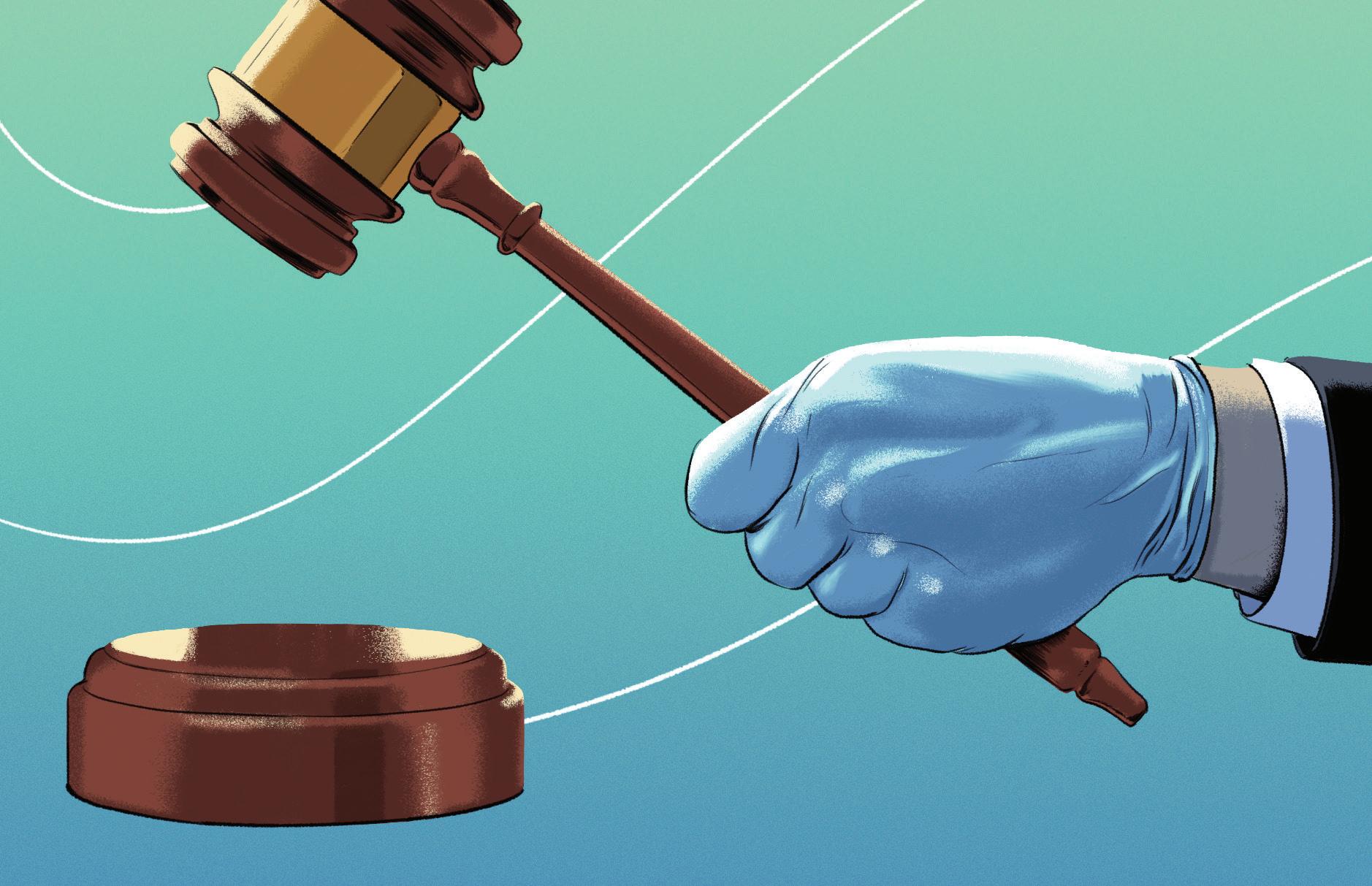
in an overburdened criminal justice system19—can also be understood as reducing the ‘punishment’ aspect of the proportionality calculus during the time of COVID-19.
Sentencing of offenders, like so many other spheres of life under COVID-19, is different, and the contours of punishment will morph and change as the Victorian criminal justice system attempts to not only be fully operational again, but also to punish offenders in a humane and just manner.
At the moment, prison conditions are harder because of a desire to ensure the containment of COVID-19 during a public health emergency. But there is a personal cost to all prisoners who serve time in those very difficult conditions. A COVID-19 ‘version’ of proportionality offers a justifiable means to ensure the legitimacy of imprisonment as a means of punishment in the time of COVID-19.20
1 Re Broes [2020] VSC 128; Re McCann [2020] VSC 138; Re Tong [2020] VSC 141; Re JK [2020] VSC 160; R v JB [2020] VSC 184; Re Nicholls [2020] VSC 189; Re Guinane [2020] VSC 208.
2 Re Broes [2020] VSC 128 at [37] (Lasry J).
3 Legislation has been passed to permit judge alone trials to occur in Victoria if the accused consents.
4 Veen v The Queen (1979) 143 CLR 458; Veen v The Queen (No 2) (1988); Hoare v The Queen (1989) 167 CLR 348; Boulton v The Queen (2014) 46 VR 308 at [64] & [67]. See also Sentencing Act 1991 s 5 (1) (a).
5 Gresham Sykes, The Society of Captives (1958).
6 See generally John Dilulio, Governing Prisons (1987).
7 Department of Justice & Community Safety, Novel Coronavirus (COVID-19): Information for Courts Regarding Corrections Victoria Operation (2020).
8 World Health Organization, Preparedness, Prevention and Control of COVID-19 in Prison and Other Places of Detention: Interim Guidance (2020).
9 Corrections Victoria, Deputy Commissioner’s Instructions, DC1.11A Protective Quarantine of New Reception Prisoners During the COVID-19 Pandemic (28 March 2020)
10 Brown (aka Davis) v The Queen [2020] VSCA 60 at [48].
11 R v Van Boxtel (2005) 11 VR 258.
12 R v Stevens [2009] VSCA 81 at [20]. See also R v Davies (1979) 69 Cr App R 319 at 322 (Lord Lane CJ); DPP (Vic) v Faure (2005) 12 VR 115; Milenkoviski v Western Australia (2014) 46 WAR 324 at [151][157].
13 R v Merrett (2007) 14 VR 392.
14 Markovic v The Queen (2010) 30 VR 589.
15 R v RLP (2009) 213 A Crim R 461.
16 R v Smith (1987) 44 SASR 587.
17 R v Verdins (2007) 16 VR 269.
18 Phillips v The Queen (2012) 37 VR 594.
19 DPP v Bourke [2020] VSC 130 at [32] (Jane Dixon J).
20 Individual prisoners—if they are of good behaviour—will also be automatically considered for ‘Emergency Management Days’ from CV because of the disruption and deprivation that COVID-19 has caused to prison regimes. Whether or not they are granted will be a matter for the Executive following the sentencing of the prisoner. In those circumstances, a sentencing court would not normally have regard to that possibility when imposing sentence.


Iflew back to Australia at the beginning of March, after 17 months as adviser to the President of the United States. I came back on a crowded plane, full of people wearing facemasks, to bunker down in my home town and wait for the end of the pandemic. On the day I left the White House, the President solemnly shook my hand and told me how much he would miss me. Readers who have been paying attention to recent White House Press Briefings may have noticed the deterioration in the President’s ‘messaging’ since I left. (I know, it was coming off a low base.)
It was satire, or at least the President’s failure to understand it, that brought all this about. Members will recall a piece I wrote for this publication in June 2017, praising Donald Trump after his first few months in office. It was the conclusion that eventually caught his eye:
After his first 100 days in Office, Donald Trump has proved himself to be the most adept and masterful, the most tremendous and wonderful President the United States has ever been lucky enough to have. No doubt history will record that he was the most capable and brilliant leader the world has ever seen.
In the weeks and months after its publication, my practice as a trial barrister continued as usual. Occasionally, colleagues who knew that I was the anonymous author would murmur their appreciation for the article, sometimes in a crowded County Court lift, sometimes in passing on the street, robes wafting behind us. Most people I spoke to were amused by it: some raised their eyebrows, some thought it was ‘tremendously funny’. (They were the ones who really got it.)
No one I spoke to, and I mean absolutely no-one at all, took it seriously.
Except Donald Trump. I have no idea how the article came to his attention (although he does have one
whole “gon” of the Pentagon scouring the world for any mention of his name), but he eventually read it, and he genuinely believed that I believed that he was the duck’s nuts.
On 9 August 2018, at about 3am, my phone buzzed on my bedside table. It was an international number, so naturally I put it on silent and went back to sleep. When I woke up that morning there were two voice messages, the first from Nick, who spoke with an American accent, and the second from Donald Trump himself. I actually spat my coffee out in shock, all over my toast.
He said he’d read my article, and he thought it was “so amazing” and “very, very right”, and he wanted me to work as his adviser. Surely this was a joke, perpetuated by one of my colleagues who was very good at doing voices? (Boyce, for instance, is pretty good at doing Court of Appeal judges, but I wasn’t aware his repertoire stretched to Trump.)
A couple of hours later, I spoke to Nick at the White House, offering me more money than I could ever make as a (mostly) competent criminal trial barrister. I insisted on a FaceTime call so that I could see him in the Oval Office, which is where he was. Surely this was a practical joke too elaborate even for Halphen or Burnside? They would have had to build a giant set.
Two weeks later, I was in that very place, with the President towering over me, squinting down at me, shaking my hand. Up close, he really is very orange. Tremendously orange. He said, with imposing gravitas, “Good to meet you Colin,” (he pronounced it Koh-lyn) “that was a good article you wrote.” He was very solemn. “It was very accurate.” Of course it was.
Washington DC is a lovely city, so I was looking forward to a great time there. It was an unexpected adventure, and I thought it was all quite amusing. I just had to keep a straight face, and not let on that my original article was dripping with scorn and irony, and this criminal
barrister from Melbourne Australia would get to hang with the President, and various world leaders, in the White House!
Every morning at 10.00 exactly, a black Lexus would arrive at my apartment to pick me up and take me to the back entrance of the White House. All the advisers would gather together in the waiting rooms outside the Oval Office (“the OO”, although we pronounced it “OOph!”, like a punch in the guts) and wait for the President to get out of bed. Sometimes we were waiting until the early afternoon.
I know a lot of those people knew that the piece I had written was heavy-handed satire. But they didn’t reveal that, at least not to the Trumpet. Job security was a misnomer in the White House, and anyone who had the courage to tell the truth usually got fired. Sometimes the President couldn’t handle the truth, unless he’d just made it up himself.
We spent a lot of time waiting for the President, on Instagram, and on our phones, reading the news, and keeping up to date with Twitter, which was critically important. Almost the first thing the President did, when he eventually blunderbussed his way past us, was to point at some random person and say “What did I just tweet?“ or “Did you see what I just tweeted?”, while chuckling to himself.
My purported role in the White House was to advise the President about everything, but I spent most of my time just agreeing with him, and explaining to the serious policy guys why his latest idea was so brilliant. Which was sometimes tricky, because he could contradict himself in the same sentence.
“What do you think Koh-lyn?” he would say.
Or: “Well, let’s ask the Mel-bawn guy what he thinks.”
I usually started with “The President is absolutely right”, no matter what incoherent absurdity he’d just come up with, peppered my next few sentences with some
‘plainlys’ and ‘obviouslys’, and then rounded it off with a ‘clearly’ or two. Once I said that he was resolute, and he looked puzzled and thought I was talking about his desk.
As advocacy goes, it was easy. I had been well-trained all those years ago by George Hampel in the readers’ course. Know your audience. I only had to persuade one person that I was serious, and that was the President; everyone else knew that what I (and he) was saying was rubbish. There was actual eye-rolling at times, but only when he wasn’t looking; the rest of the time there was

do that?”) would disappear like a Washington snowflake on his orange nose.
The first month was fun. I met Angela Merkel in the second week. I remember the way she looked at the President. She was literally trying to kill him with her eyes. There was a lot of that. Another common response was aghastness (if that’s a word), with world leaders literally losing control of their lower jaws. (I meant ‘literally’, like actually literally.)
By the time the second month came around, I was getting anxious, and it wasn’t so much fun anymore.
It was like an orchestra in there sometimes, everyone working together to get him off one train and onto another. Just mentioning Hillary would usually do the trick.
thinly disguised contempt for me. I only had to keep talking until the President got distracted by someone saying his name on “Fox and Friends” Usually this didn’t take long, because they talked about him a lot. And he loved it.
Everyone was in on it. Sometimes there were 20 people in the Oval Office, all apparently working together to nullify the President. I saw so many potential wars and economic catastrophes averted by a five-star general suddenly pointing out that there had been a change in a Fox News Personality’s (FNPs) hairstyle, or that there was a new Mercedes ad. It was like an orchestra in there sometimes, everyone working together to get him off one train and onto another. Just mentioning Hillary would usually do the trick.
But the best distraction was any negative publicity about Trump himself. He would completely lose his train of thought, and his masterstroke of buying up all of China’s manufacturing industry, or having breakfast every morning with Putin to “keep him happy”, or sending a team in to hypnotise North Korea (“Mass hypnosis, we can do that right? Our people can
Everyone was a bit skittish, because there was a lot of hiring and firing going on. I wanted to get fired too, but that would have involved revealing that I actually had independent thoughts, and if the President got a sniff that my original article was satire, and he’d been hoodwinked for months, well, I don’t know. He is a very powerful man, and his security guys have guns, and he should know all the nuclear codes (“Who’s got the codes? Mike, have you got the codes?”).
He often said things like “I know people.” And “I think about things. I’m a very smart guy.” He wasn’t. And “I know a lot of people.” And once he said “I could have been the best sniper in the Marines, I can see a long, long way. So, so far.” I was a bit scared. And I was trapped.
So was Jacob, the young German guy who’d posted a YouTube video on the climate change conspiracy in the United Nations and now had to feed Trump fake stats which the President promptly forgot, or couldn’t get right, making them even more fake, and a Mexican grandmother who had tweeted about how she loved his hair, and was now his Fashion/ Wall/Mexico/Immigration adviser.
“Where’s Consuela?” he would say. “Ask her what she thinks of Jillian Mele.” (FNP)
But although there were others, for some reason I was his go-to guy. So I went on supporting the President and his absurd and fanciful ideas. I felt really bad sometimes, like when I had to say that his idea to “bomb the shit out of Tehran” was obviously the only sensible thing to do. That was the moment when Mike Pence saved millions of lives by pointing out that Dana Perino (FNP), on the massive television on the wall, was laughing at something Sean Hannity (FNP) had said. We all had to be quiet while some factotum turned the sound up, and the President tried to work out if it was about him. Thankfully, what I’d just said was lost to history. All those people in that orchestra were really just trying to stop bad things from happening, as much as possible. There was just no space for good ideas in the OOph!
I missed Melbourne, and I missed being a barrister, standing up in court, having opponents openly scoff at my submissions, having judges dismiss them without batting an eye, and occasionally having people actually grapple with them, whether or not they had any substance. Instead, there I was in the White House, for 16 months and 23 days, slowly chipping away at America’s soul, and probably helping to destroy the planet.
I’m not proud of it. But I didn’t vote for him.
I’m sure readers can imagine my relief when Scotty from Marketing decided to call us all home, and I had the perfect excuse to get out of there. “Mr President, I have to go home. I don’t know if you’ve heard, but there’s a virus going ’round.”
“What? That Crooner (sic) thing? That’ll blow over by the weekend.”
I think he liked me, and I’m sure there was a little tear in his eye as he stood at the door and solemnly nodded his head, his tie flapping in the Washington breeze.
Robert T Burns
The life they had before has gone
And all that’s left is this final song. For three whole days they have fought Arguing for orders that they had sought. Now before a Judge sitting up there high Awaiting judgement they wonder why. Their marriage was so often stressed And to fix the problems they did their best. When did the distance and drifting start
Before that day they broke apart?
On that day one was quite relieved
The other thought they’d been deceived. Each was blind to the other’s needs
No communication, it sowed the seeds. The children want them to restart anew
When parents split, it’s what children do. Collateral damage from their parents past They have suffered long, and it will last. Their parents won’t know where they’ll live
Until the Judge says to whom to give. And now the Court will make the decision
About children and the property division. These days have been at enormous cost
And when they leave both will have lost. Days like this just never arise
With those prepared to compromise.

Oren Bigos SC
Help! Coronavirus, Bank balances in minus, Communicating only through devices, Help!
Our Bar has not escaped COVID-19, It’s affecting silks and juniors and everyone in between.
Assistance being offered to pay the chambers rent, Isolated, we regret the money that we’ve spent.
Help us stop the workflows going down, We can’t wait for things to turn around… Getting used to electronic briefs, but we prefer ours bound,
Will the ‘old normal’ return, please?
Getting used to appearing in virtual court rooms, Video hearings on Webex, Teams and also Zoom. Client conferences no longer feel the same, But there’s only an invisible microbe to blame.
Help us stop the workflows going down, We can’t wait for things to turn around… Getting used to electronic briefs, but we prefer ours bound,
Will the ‘old normal’ return, please?


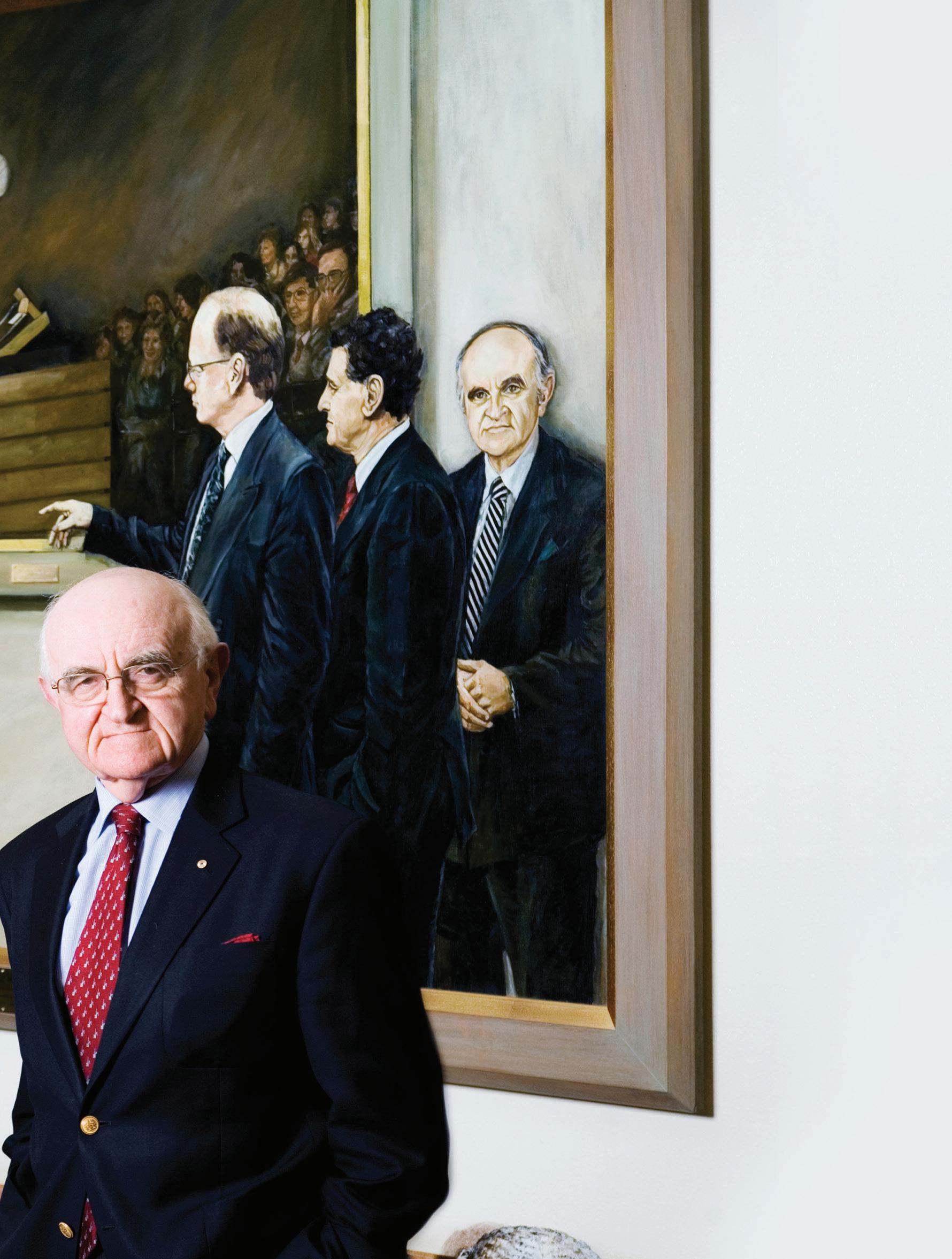
BY JACK HAMMOND QC
Alarge portrait hangs in the Clayton campus of the Monash Law School Library. It commemorates a famous (or perhaps infamous) law lecture delivered some 44 years ago, on 5 May 1976: a small group of Monash law students, aided and abetted by a former Monash Dean of Law, perpetrated a hoax which still raises smiles throughout the Australian legal profession.
Professor Granville Williams QC, PhD, LLD, FBA, Alternative Professor of English Law in the University of Cambridge, the alter ego of then law student Campbell McComas, addressed more than 450 students, law faculty staff and other lawyers crammed into Monash Rotunda lecture theatre R1.
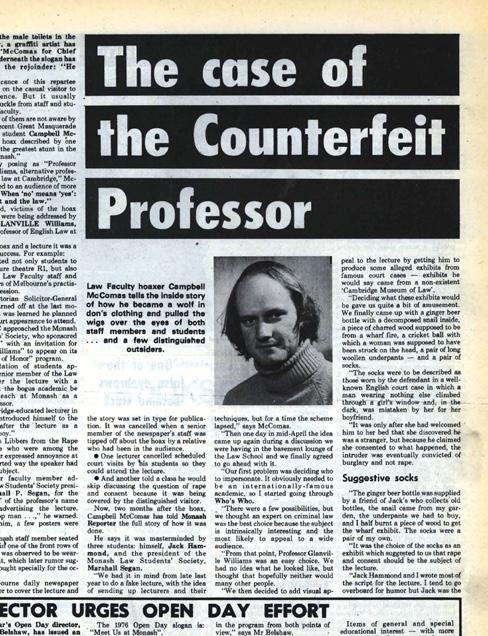
The lunchtime lecture had to be shifted at short notice from the planned much smaller lecture theatre L3 in the law school when it became clear that an almost unimaginable number of people, from both on and off campus, intended to attend.

That gave Campbell and Jack the idea of creating an English professor of law. He would be a guest lecturer at Monash and speak on a topic which should interest most students and staff.
The audience were led to believe, by campus notices and posters put up by the Monash Law Students’ Society, that they were to hear the real Professor Glanville Williams, a notable English criminal law academic and author.
In fact, a senior member of the law faculty had drawn to the attention of Marshall Segan, the then-president of the Monash Law Students’ Society, the spelling “error” in the promotional material. Some of the posters then were seen to have been “corrected”.
The hoax lecture had been conceived and written by two Monash law student friends, Campbell McComas and Jack Hammond.
They had noticed during law lectures that most students rapidly took voluminous notes, apparently without taking much time to think about what was being said. Students rarely sought to question the lecturers, for clarification or otherwise.
Of course, the students had no reason to doubt, did they, that what they were being told must be true? Even if they did not fully understand it, they accepted it because of their lecturers’ status and obvious expertise.
That gave Campbell and Jack the idea of creating an English professor of law. He would be a guest lecturer at Monash and speak on a topic
which should interest most students and staff.
But most importantly, the lecture had to be a plausible mixture of erudite material and fictional law and facts.
Naturally, it had to involve a compulsory law subject which students could not afford to miss.
They settled on criminal law.
The lecture was to include a critique of DPP v Morgan [1975] 2 WLR 913, a recently reported English criminal case which involved the mental element of the offence of rape. It was prescribed reading for law students.
Campbell, an accomplished amateur actor, was to be the visiting professor.
As the chosen field was criminal law, they were concerned that former Monash Dean of Law and its most senior criminal law lecturer, Professor Louis Waller, might know the real Professor Glanville Williams, and expose the hoax. They visited Professor Waller in his faculty room. They intended to tell him of their plan, to ask him what he thought of it, and if he approved, to ask him to keep it secret.
They started to do so. Before they could finish, he laughed uproariously and could not stop giggling. He willingly approved it and regaled them with stories of university students’ pranks and stunts which occurred in his time as a student.
Campbell and Jack seized the moment. They asked Professor Waller whether he would be prepared to introduce Professor Granville Williams to the audience.
He immediately agreed.
They then enlisted the President of the Monash Law Students’ Society and a few select fellow students to assist and prepare the ground for the lecture.
Campbell and Jack then wrote the lecture, with a provocative title which they thought would attract a wide audience: “When ‘No’ means ’Yes’: Rape, Consent and the Law”.
On the day, a longish-silverhaired, glued-on bushy eye-browed academic, wearing black horn-
rimmed spectacles, bow tie and a slightly out-of-date suit, Professor Granville Williams, stood beside Professor Louis Waller, ready to present his lecture.
Professor Waller had prepared a masterly piece of obfuscation. His introduction bears repeating:
Ladies and gentlemen, the president of the Law Students’ Society has asked me to introduce the speaker this afternoon. It’s an invitation I’m happy to accept. This is a unique occasion in the history of the Monash Law School.
I commend the Law Students’ Society for their great initiative. I don’t think it’s necessary for me to speak at length in introducing the speaker, and I shan’t do so. Time is limited, and what he has to say is, on this occasion, of much more significance than anything I could say.
Ladies and gentlemen: the speaker.
Campbell began his lecture.
At that point, he was supposed to hold aloft fictional exhibits from an invented Cambridge Museum of Law and explain their history.
They were:
» the bottle of Stone’s ginger beer (which still had part of a decomposed snail in it) from Donoghue v Stevenson;
» a piece of charred wood from the wharf in Wagon Mound No 1;
» the cricket ball from Bolton v Stone;
» the pair of large woollen underpants from Grant v Australian Knitting Mills; and
» a pair of socks, being the only clothing worn by an intruder in R v Collins.
However, in his rush to the lecture theatre, Campbell had left them in the law faculty room he used as his make-up and dressing room.
Ever the seasoned trouper, he called on one of the audience (his brother, Malcolm McComas) to fetch them. Meanwhile, he entertainingly ad-libbed his way out of trouble until the exhibits arrived and then resumed his written script.
The lecture was a huge success. Additional memorable unscripted
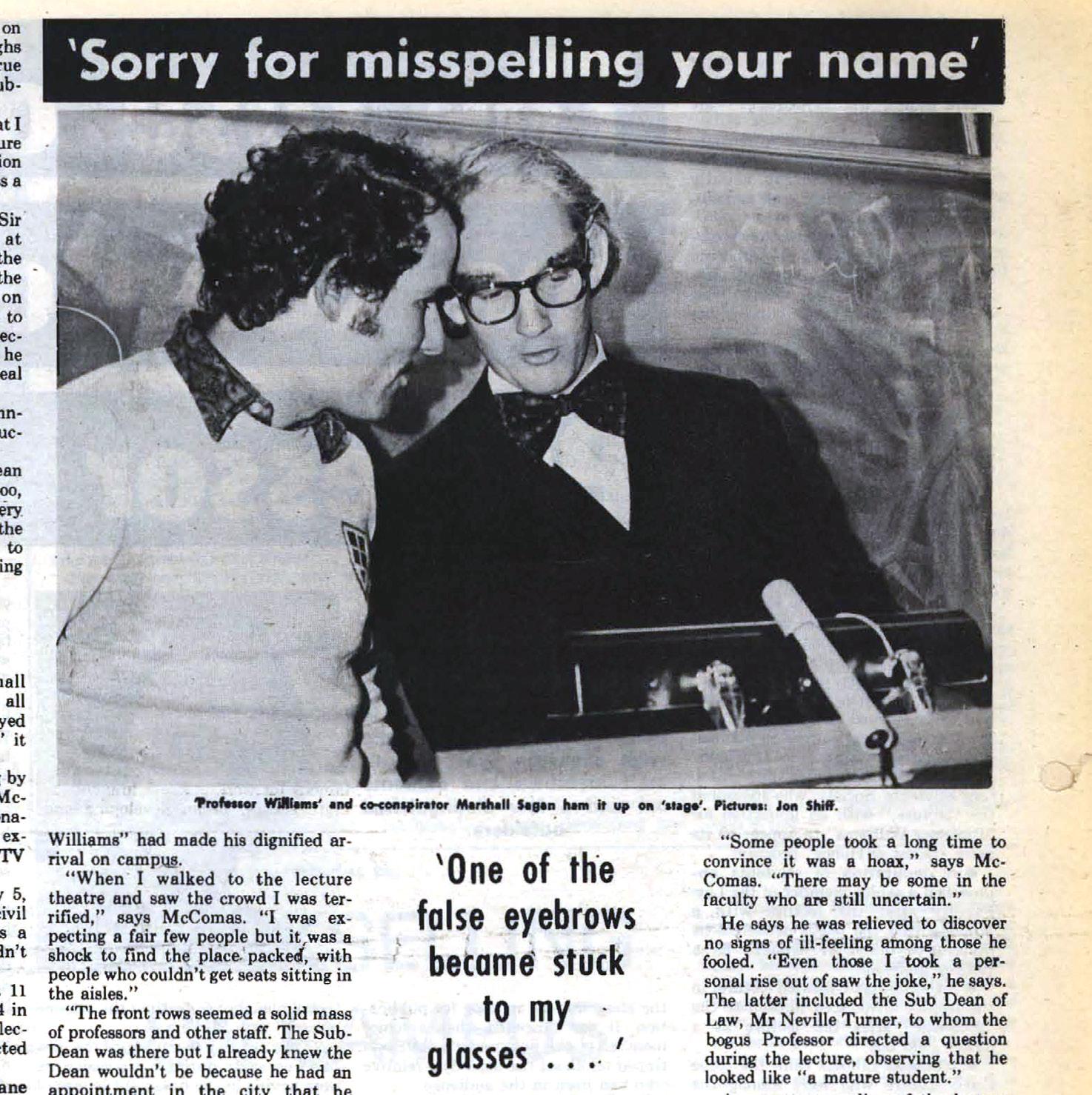
On
the day, a longish-silver-haired, glued-on bushy eye-browed academic, wearing black horn-rimmed spectacles, bow tie and a slightly out-of-date suit, Professor Granville Williams, stood beside Professor Louis Waller, ready to present his lecture.
moments had occurred, including Campbell’s response to an unexpected question from Arie Freiberg, a then Monash law tutor.
Steven Stern, a law student, recorded the event on a large reel-to-reel tape.
Jonathan Shiff, another law student, took a number of excellent photos.
Subsequently, the original tape recording was reproduced in cassette form. The cassette cover featured a photo of Campbell as Professor Granville Williams.
The cassettes were sold by the Law Students’ Society for $2.50 each, which enabled it to fund a photocopying machine for the use of students in the law library.
Later, the cassette recording was transferred to CDs.
Currently, re-mastered CDs are under consideration, to be sold with
the proceeds to a Monash University fund in memory of the late Professor Louis Waller.
The Professor Granville Williams story has passed into folklore, repeated by many who believe they were there.
And the portrait in the law library remains as a constant reminder that, in fact, it did occur—unless that and this is a hoax!
Where are the main perpetrators now?
Campbell McComas died on 8 January 2005.
Professor Louis Waller died on 8 October 2019.
Jack Hammond QC is very much alive and on the Victorian Bar List of Retired Counsel.
Marshall Segan is also alive and in business, not law.
Brian Walters
On 27 February 1933, Berlin’s immense Reichstag building was set on fire and destroyed. Only the shell remained. It was a shocking act of terrorism. Following the fire, the alleged perpetrators were tried before judges of Germany’s highest court: the Reichsgericht. Marinus van der Lubbe was convicted. However, his four co-accused—all officials of the Communist Party—were acquitted.
The acquittals outraged Adolf Hitler, and prompted him to establish a ‘People’s Court’ to deal with so-called ‘political’ crimes. Legally qualified judges sat with lay representatives (or ‘assessors’)—typically, Nazi Party officials. Adherence to legal procedure was token. Trials were brief, and often no evidence was heard. Typically, the accused were given only a few hours’ notice of the allegations against them. They were obliged to use court-appointed counsel, but generally had no opportunity to consult with them.
The court was used for show trials designed to make the German people ‘healthy’ by cleansing the ‘disease’ of treason. The accused were almost always convicted, and the usual penalty was death—the court imposed tens of thousands of death sentences.
Hitler had clear views about judges:
I desire only judges who have the requisite personality—but in that case they must be very generously reimbursed. I need men for judges who are deeply convinced that the law ought not to guarantee the interests of the individual against the state, that their duty is to see to it, above all, that Germany does not perish.
All those who sat on the court were appointed by Hitler personally. From August 1942, the president of the court was Judge Roland Freisler.
For distributing leaflets criticising the regime, students Hans and Sophie Scholl and Christoph Probst—part of a group calling itself ‘The White Rose’—were tried before the People’s Court four days after their arrest. When the Scholls’ parents Robert and Magdalena were denied entry, Magdalena said to the guard, “But I’m the mother of two of the accused.” The guard responded, “You should have brought them up better.” Robert Scholl forced his way into the courtroom and told the court that he was there to defend his children. He was seized and forcibly escorted
outside. The entire courtroom heard him shout, “One day there will be another kind of justice! One day they will go down in history!”
Sophie told Freisler:
Somebody, after all, had to make a start. What we wrote and said is also believed by many others. They just don’t dare express themselves as we did.
Freisler sentenced all three defendants to death. They walked to the guillotine a few hours later; Probst was executed before his family even knew he had been arrested.
After the failed attempt to assassinate Hitler and stage a coup d’etat on 20 July 1944, some 5000 persons were tried in the People’s Court. When the trials began in August 1944, the courtroom was decked out with swastikas. A bust of Hitler stared over the judges’ shoulders. Freisler opened the proceedings with a statement casting aside any pretence of judicial impartiality:
Today it is the task of the People’s Court of the German Reich to pass judgment on the most horrific charges ever brought in the history of the German people. Traitors have come amongst us. Led by the murderous scoundrel, Colonel Stauffenberg, a rabble of criminals, with the character of pigs, has, in the very hour of Germany’s need, tried to murder one of the greatest leaders in the history of the world.
To ensure humiliation, the defendants were denied ties, belts, braces, and false teeth. The great Field Marshal von Witzleben, without his dentures, mumbled as he held up his trousers in court.
The worth of the prisoners’ legal representation can be gauged from the following statement by Witzleben’s courtappointed counsel, Dr Weissmann, in his final address:
The court’s decision has, in effect, already been rendered when, in a miraculous act of deliverance, it protected the Führer for the sake of the German people. The deed of the accused stands, his guilt is manifest, and the perpetrator will go down with it.
Count Schulenburg, who had liaised between different branches of the conspiracy, gave a particularly stirring account of himself, despite Freisler’s almost apoplectic attempts to stop him. Freisler kept referring to him as ‘Scoundrel Schulenburg’ but at one stage forgot himself and said ‘Count Schulenburg’. The count corrected him, “Surely
you mean ‘Scoundrel Schulenburg’?” When asked whether he was ashamed of his actions, he answered, “I am proud that we sought to rid the world of one of the greatest murderers in history.” Later he said, “We resolved to take this deed upon ourselves in order to save Germany from indescribable misery. I realise that I shall be hanged for this, but I do not regret what I did and only hope that someone else will succeed in luckier circumstances.”
Lawyer Joseph Wirmer, long banned from practice for assisting victims of the regime, defended himself with great dexterity—always calmly accepting that he was about to die. At one point he said, “When I hang, I will not know fear. But you—” Freisler screamed at him, “Soon you will be roasting in hell!” Dr Wirmer bowed curtly and gave the immortal retort, “I’ll look forward to your Honour’s own imminent arrival.”
Hans-Bernd von Haeften, a lawyer and diplomat who had supported the coup, said he did not regard his actions as treason, describing Hitler in open court as “the incarnation of evil in world history”, at which point his trial was brought to an abrupt end.
Claus von Stauffenberg’s cousin, Cäsar von Hofacker, could expect no mercy, but he was coldly determined when he addressed the court. Freisler angled for an apology, “And do you not regret your part in this evil conspiracy?” Hofacker responded, “I regret that I was not chosen to carry out the assassination, because then it would not have failed. But I in no way regret that I attempted to save Germany from the destruction to which Hitler and his evil cohorts are leading us.” Freisler said, “Do not dare to use this court in this way! I will not have—” And Hofacker answered, “Be quiet now, Herr Freisler, because today it’s my neck that’s on the block. In a year it will be yours.”
In September 1944, Ulrich von Hassell—former German ambassador to Italy and an important member of the anti-Nazi resistance—was tried before the People’s Court. Despite the Nazis’ attempt to humiliate him by
Freisler screamed at him, “Soon you will be roasting in hell!” Dr Wirmer bowed curtly and gave the immortal retort, “I’ll look forward to your Honour’s own imminent arrival.”
refusing to let him to wear a belt or tie, allowing him only a rumpled suit, Hassell cut a stylish figure with his pocket handkerchief and his poised bearing. At one point in the trial, he calmly told a foaming Freisler, “Herr President, I have not lived 62 years to be told by you that I am a liar.”
Many organisations were required to send representatives to observe these proceedings. One of the witnesses to Hassell’s trial was 25-year-old junior officer, Helmut Schmidt. In 1946, Schmidt wrote to Hassell’s widow Ilse, whom he did not know, describing the trial. He expressed an enduring sense of shock at the proceedings. Schmidt described the trial as “a mockery of justice” and “a singular staged performance by Freisler combining Goebbelsesque intelligence and demagogic loquacity with the jargon of the rabble.” Hassell had hardly been able to finish a sentence without Freisler interrupting him in the most insulting manner. Finally Hassell remained silent, and let all the abuse and accusations flow off him like water off a duck’s back. Schmidt spoke of Hassell’s “exemplary conduct” as he faced Freisler, and concluded, “He was a truly noble man, and too noble for this world.” Schmidt would later become Chancellor of West Germany.
Not all those who faced the People’s Court were condemned. Eugen Gerstenmaier carried off his pretence of being a naïve minister of religion, unschooled in political matters. His reward was a lengthy prison sentence instead of death. Ewald Loeser, former deputy mayor of Leipzig, had been involved in the coup and would have been minister of finance in the new administration if the coup had succeeded. At his trial, he feigned amnesia. He was committed to a sanatorium, where he survived the war.
Fabian von Schlabrendorff, a lawyer, having been tortured for a long period, was brought before the People’s Court on 21 December 1944. There were five other cases that day. He was last in the list. At the conclusion of the session, no time was left to deal with his case. He was returned to prison.
Schlabrendorff was brought back to court on 3 February 1945. As his case was called, air raid sirens sounded. The court hastily sought shelter in the vaulted cellars of the building. The crump and clamour of a terrible bombardment followed, culminating in the deafening crash of a direct hit. As part of the ceiling collapsed, it burst into flames. A beam fell on Roland Freisler. He died with Schlabrendorff’s file in his hands.
When Schlabrendorff returned to court on 16 March 1945, the war was almost over. He was able to prove that he had been tortured—something that remained illegal, although widely practised, throughout the Nazi period. He was acquitted of all charges. The Gestapo simply arrested him again. He was informed that the decision of the court was obviously an error, and he would not be hanged, but shot instead. He was required to sign an acknowledgement that he had received this information. Many times Schlabrendorff came close to death, but he survived the war to become one of Germany’s most respected lawyers and judges.
The independence of our courts and judiciary is a fundamental safeguard for citizens in a democracy. The People’s Court provides a powerful demonstration of what can happen when that independence is removed.
Brian Walters AM QC is the author of TREASON: Claus von Stauffenberg and the Plot to Kill Hitler an interactive book for the iPad available from Apple Books.
In this Back of the lift section of the Victorian
Bar Roll No 1977
ften, but not always, a ceremonial sitting for the retirement of a justice of the Supreme Court of Victoria is an occasion marking more of an ending than a beginning. On the occasion of Justice Bell’s recent farewell from his 15 years of service as a justice of the Supreme Court of Victoria, there was a strong sense that after his retirement from the court, there would be much more to come.
John
The
The
Hartley Hansen AM QC
Michael Wright AM QC
David Curtain AM QC
Dr Suzanne McNicol AM QC
Dr Sam Ricketson AM
Danos OAM
The Hon Justice Susan Kenny AM
The Hon Justice Shane Marshall AM
The Hon Robert Redlich AM QC
Martin Bartfeld AM QC
Jennifer Batrouney AM QC
Carolyn Douglas OAM
OTHER APPOINTMENTS
On 12 March 2020, the Banco Court was full of friends, family, colleagues and several current and former judges, including his Honour’s close friend, Chief Justice Alstergren. We all came to celebrate his Honour’s long and distinguished legal career. The Solicitor-General for Victoria, Dr Kristen Walker QC, together with Simon Marks QC and Sam Pandya, representing the Victorian Bar and Law Institute of Victoria, respectively, each spoke.
Common themes amongst the various speeches were his Honour’s hard work ethic, creativity and curiosity: qualities that he brought to the comprehensive review undertaken of the Victorian Civil and Administrative Tribunal during his time sitting as president from 2008-2010. The significant contribution his Honour made to the development of the law in Victoria on the Charter of Human Rights and Responsibilities was also widely recognised by all of the speakers. His Honour’s decisions on the charter have been formative in establishing a charter jurisprudence in Victoria and will no doubt continue to be read for years to come.
His Honour’s speech offered a rare insight into what appears to have been a driving force in his legal career. His Honour is very clearly a man driven by public service and whose commitment to such service appears to come naturally, without reservation. His Honour thanked colleagues and highlighted the enduring support during his career of his family, especially his wife, Patricia Byrnes, a member of the Victorian Bar. A particularly touching aspect of his Honour’s address was directed to his 16 associates, whom he described as teaching him, not only learning from him.
Given his long-standing interest in legal education and distinguished career in public and human rights law, it may not come as a surprise that his Honour will now continue his public service as professor of law and director of the Castan Centre for Human Rights at Monash University. We thank him for his significant contribution as a justice of the Supreme Court of Victoria and wish him all the very best for the next stage in his career.
KYLIE EVANS
Bar Roll No 4032
Justice Lisa Nichols was appointed to the Supreme Court of Victoria on 22 October 2019.
Much has already been said about her Honour’s impressive curriculum vitae. The highlights are as follows. She undertook law studies at Monash University and won the Supreme Court Prize. She completed articles at Slater & Gordon and was a partner three years later. In 2007 she came to the Bar and took silk nine years and 364 days later. Just shy of two years later, she was appointed a judge of the Supreme Court. Her Honour’s progress through the law can only be described as meteoric. Apparently, NASA has been in touch, seeking advice on how to achieve such rapid acceleration.
At the Bar, Justice Nichols quickly became a leader in the areas of class actions, mass torts, consumer protection and environmental law. Her work was always conducted with compassion and the highest standards of respect and duty to the law and to her clients. Her intellectual honesty is without question. Her intellectual abilities are, frankly, intimidating. Her capacity for hard work is legendary. At times, her work habits have caused family, friends, and colleagues to use words not fit for the editorial standards of the Victorian Bar News. Yet, however much one might rue the long hours and sad midnight dinners from the à la carte menu of the 7-Eleven hot food unit (the writer recommends the sausage roll), the result of those long sessions at the desk reveals an essential truth: being gifted can take you far, but without hard work, success is both impossible and unsatisfying.
One is always a better lawyer after a bracing session working with (and now, appearing before) her Honour.
There is little at which Justice Nichols does not excel. She is a superb host and gifted cook (the writer has never left her house hungry or thirsty). Her loyalty to her friends is paramount. Her kindness to those in need is expressed through her generosity: to young juniors looking for work, a recommendation for a brief; to friends in need of company, an invitation to dinner, delicious food and wine and invigorating conversation; to clients and colleagues alike who need someone in their corner, fearless advocacy. However, she is not perfect. She once dropped a container of glitter eyeshadow on the floor of the MAC counter at Myer. She is allergic to spreadsheets. Occasionally, she is late to drinks.
Her Honour’s appointment to the Supreme Court of Victoria is a significant benefit to the court and the community, and to her family and friends who rejoice in this most deserving appointment.
KATE BURKE
Bar Roll No 3644
Judge Hassan was admitted to practice in 2001 at which time she was associate to Justice Warren (as she then was).
Judge Hassan signed the Bar Roll in 2003, joining Dever’s list, reading with Jane Dixon and embarking on a 15-year career at the Criminal Bar.
In case after case, for defence or the Crown, her Honour saw the real person amidst the law and developed a reputation for having an eye for detail and an ability to grapple with a number of conflicting legal principles.
In the Court of Appeal, her Honour appeared alone and with leaders, including Champion J, Kidd J, Judge Trapnell, Silbert SC, McArdle QC, Elston QC and Kissane SC.
In 2016, led by the DPP, her Honour appeared in a Crown appeal against sentence on charges of dangerous driving causing death. It was terrible driving. But the offender was a young man with autism, cognitive impairments and debilitating depression. The gravity of the offending was high but the moral culpability of the young man was low. To make matters worse, the case had settled late by which time the young man was no longer eligible for youth detention. It could not have been more complex. Her Honour was being prepared for a most difficult part of her new role.
Her Honour took readers Mable Leong and Jordan O’Toole, who said she was a terrific mentor—always interested in the work her readers were doing and, even beyond the reading period, always available as a sounding board.
Her Honour has also been a member of the Barristers Animal Welfare Association and the Bar’s Equality & Diversity and Pro-bono Committees, a readers’ course advocacy coach, a mentor for the Diverse Women’s Mentoring Association, and a volunteer at the Darebin Legal Service and Sudanese Australian Integrated Learning.
In 2018, her Honour gave the junior counsel speech at the Bar dinner. She quoted Socrates on oral advocacy: “He was against paper. It threatened the spoken word, which was more authentic and less open to distortion because of the presence of a critical interlocutor who would challenge and question any loose or sloppy utterances.”
Then, on what follows after advocacy, her Honour quoted Warren CJ, that reasons for sentence should be written more simply and briefly— in an accessible way that they might more readily be published and, more importantly, read.
May her Honour have joy in the appointment, and long, satisfying and distinguished service as a Judge of the County Court.
SIMON MOGLIA
Bar Roll No 3028
Judge Kevin Doyle’s legal career spanned more than 30 years before his appointment as a County Court judge. During this time, he developed a deep and wide knowledge of criminal law, appearing for both the prosecution and defence.
Upon admission to practice in 1987, his Honour’s first position was as a solicitor in the Dandenong office of what was then the Legal Aid Commission, where he was immediately exposed to advocacy in the criminal jurisdiction as a duty lawyer. This was the beginning of an enduring practice in crime: his Honour worked at the Victorian Aboriginal Legal Service, then for a year in London before returning to the Legal Aid Commission, first as a duty lawyer and then in the indictable crime unit.
He came to the Bar in 1995 and appeared in his first trial in Bairnsdale in 1999, representing one of four accused. Against the odds, all four were found not guilty.
In 2002, his Honour took leave of absence from the Bar and went to the North Australian Legal Aid Service in Darwin. On return, his trial practice was cemented: in demand to appear for the defence, and increasingly for the prosecution. He prosecuted in numerous country circuits and earned a reputation as a top operator: pragmatic, able to see both sides and capable of resolving issues. These qualities were appreciated by circuit judges and always complemented by great courtroom skills.
His Honour conducted many significant trials in the Supreme Court. In 2018, he was appointed a crown prosecutor. It was a welldeserved appointment, but lamented by chambers colleagues, who lost the great company and good humour of a valued colleague.
He had a reputation as a formidable prosecutor: impeccably fair, with a disarming affability that had great jury appeal. Indeed, in one of his last cases, a murder trial in 2019, a very
experienced silk warned the jury not to be influenced by the fact that Mr Doyle was a “very pleasant, nice, clever man” or that he seemed to have “made a good point”. His Honour’s practice was characterised by his deeply analytical approach to legal issues, thorough preparation, sound knowledge of the law and judgement of facts, as well as careful weighing of the opinions of juniors and instructors.
The Victorian community is fortunate to have his Honour join the County Court, bringing outstanding intellect, court room skills, compassion and commitment to the administration of justice.
JENNIFER CLARK
Fran Dalziel
Bar Roll No 3858
Judge Fran Dalziel studied classics before turning to law, completing both degrees with honours. Her first job in the law was as associate to the late Justice Peter Buchanan QC of the Court of Appeal. After two and a half years, she left to do articles at Kenna Croxford.
She was admitted in 2001 and worked as a solicitor in the WorkCover Division at TAC Law and later at Mills Oakley, where she practised in personal injuries. But the Bar was calling and in 2005, she answered the call, reading with Mark Taft, now a judge of the County Court.
As a student, her Honour had not been especially interested in criminal work, but her time as an associate had changed that. At the Bar, she began what has developed into a long and fruitful career in criminal law. She was involved in the prosecution of several complex and high-profile matters and was recognised as a fine advocate.
In 2012, she was appointed a crown prosecutor. In 2018, she took silk; the same year, she became a senior crown prosecutor, contributing greatly to the Court of Appeal practice and the trial practice.
In Crockett chambers and at the OPP, Judge Dalziel found collegiality
and forged deep friendships. Her colleagues and friends value her sharp intellect and generosity of spirit. She is admired and respected for her legal achievements and her support of other practitioners, especially juniors. She encourages and mentors other women, notably women working in crime.
Judge Dalziel’s love of animals is no secret. She was a member of the Bar’s animal welfare committee and is a great supporter of the OPP victim support dog program. Lucy, the OPP pooch, who is trained to provide comfort to vulnerable witnesses, lives with her Honour and was present at the judge’s official welcome to the County Court in early March.
At that time, the COVID-19 storm was brewing, but was registering barely a blip on the radar. Two weeks later, the World Health Organization had declared a global pandemic, Victoria’s premier had announced a state of emergency and the courts were suspending jury trials. This unprecedented arrival on the court didn’t slow her Honour. She jumped from the starting gates and has already been reported in some interesting high profile press. That she remained calm and focused in the crisis is no surprise to those who know her.
Judge Dalziel said at her welcome that she saw her appointment as a new way to serve the justice system and the community. We will all be well served with her Honour on the Bench. VBN
Her Honour Chief Magistrate Lisa Hannan
Her Honour Magistrate Hayley Bate
His Honour Magistrate Justin Foster
His Honour Magistrate
Michael Richards
Her Honour Magistrate
Elizabeth Langdon
Her Honour Magistrate Kristen Rose
Her Honour Magistrate
Victoria Campbell
His Honour Magistrate Andrew Halse
Her Honour Magistrate Helen Murphy

Bar Roll No 1280
Raymond (‘Ray’) Rosenberg passed away, aged 70, on 25 November 2019, after a battle with motor neurone disease.
He was born in 1949 in Launceston, Tasmania, where his family grew vegetables. His father was a dentist, serving in the medical corps during WWII. When Ray was nine, his father died, leaving Ray to head a household of five children.
Educated at Wesley College, Ray was a member of its senior rowing team. He then attended Monash University.
Admitted to practice in 1974, Ray did articles with Sackville Wilkes & Co, and later at Philips Fox. In August 1976, Ray signed the Bar Roll, reading with the late Ronald Castan QC, whom he greatly admired. He was on Duncan’s List and later List G with Glenda McNaught, returning to Duncan’s/Patterson’s after her departure.
During these early years, Ray shared chambers and impassioned discussions with Tony Neal, their longstanding friendship born of a protracted duel over the sale of sewing
machines at Dandenong Magistrates’ Court and a shared, tragic devotion to the Melbourne Football Club. Ray tutored at LaTrobe University and provided legal assistance to at-risk youth on probation, inspired by social worker Lily, whom he first met at a dance. (They married in 1977 and had three children.)
Tall, intense, direct, with a gruff manner that belied his personal warmth, Ray had a general commercial practice, including in the areas of banking and finance, trusts and insolvency. He appeared unled, and led by silks including Allan Myers QC and Cliff Pannam QC. He could be fierce, challenging instructors and clients alike, meticulously drafting evidence over weeks, if necessary. He was a generous mentor to his three readers, Sandra Horovitz, Simone Jacobson and Einar Oxnevad.
His chambers, inherited from Sir Daryl Dawson, were on level 12 Owen Dixon East, alongside Joseph Carney, Michael Colbran QC and Rowan Downing QC. Widely regarded as a formidable opponent, Ray was not
as sufficiently persuaded of his own ability as he should have been. When there were no trials or pressing paperwork, he loved windsurfing in Port Phillip Bay, striving for personal best. He also found time to sit on the East Melbourne Synagogue board, making significant changes to its constitution.
Retiring from the Bar in 2016 as the ravages of MND took hold, Ray Rosenberg retained his sharp mind and curiosity to the end. Those close to Ray hope he will be remembered for the man of integrity, robust advocate and kindly mentor that he was.
SIMONE JACOBSON

Bar Roll No 793
Peter Murley passed away on 29 October 2019 at the age of 84 years.
Peter was admitted to practice in 1966 and came to the Bar the same year, where he read with the Hon Sir Ninian Stephen, then Ivor Greenwood QC. He established a thriving practice in bankruptcy and crime, later focusing on criminal trials in the County and Supreme Courts.
Peter overcame great adversity in his early years. As a child, he spent eight years at the infectious diseases hospital in Fairfield. He was admitted with tuberculosis, then contracted polio and spent some time in an iron lung. His mother visited him in
hospital once a week, but because of the risk of infection, his brother was only able to see him from outside on the hospital lawn. Peter’s daughter Raelene wonders whether this early isolation helped him develop the sharp facility he had for reading faces and body language that served him so well throughout his years in practice.
He was discharged from hospital at the age of 11, though he had to continue wearing callipers. He attended school for a year and a half before leaving to find work, which including selling newspapers at the races, and later as a dental mechanic.
Peter was supporting his wife and two children in the 1960s when he returned to school to complete his leaving and matriculation certificates. He subsequently commenced a law degree at the University of Melbourne, where his classmates included Brendan Murphy, Philip Dunn and Con Heliotis. A bookmaker friend let him use his apartment as a quiet space to study.
Brendan Murphy describes Peter as the most generous person you could ever meet. In first year law, due to ill health, Brendan failed British History of Law. This caused him to lose his Commonwealth Government scholarship and required him to repeat the whole of first year. He was unsure whether he could afford to continue with his law studies. One evening, he found fellow student, Peter Murley, at his door step. Peter handed over a blank cheque and told Brendan to fill in the required amount for his uni fees for the coming year. Although Brendan told Peter he couldn’t take the cheque, the fact that the offer was made is testament to the type of person that Peter was.
Peter mentored nine readers: the Hon Justice Phillip Priest, Michael Gregurek, Stephen Marantelli, Ian Bowditch (deceased), Brian Scheid (deceased), Paul Holdenson QC, John Goussis, Anthony Phillips and Simon Lee. He was also an unofficial mentor to many others. ’Murls’ was
I first met Peter Murley at the Stony Creek races in 1974. He drove me back to Melbourne at the end of the day, and we ate a late dinner at Vlado’s (Michael Gregurek’s father’s restaurant). It was the beginning of a lifelong friendship. We often met at the races, and Peter was most partial to having a bet. In those days, the crowds were large, and there was wealth to be redistributed! On occasion we shared meals after the races and before the trots.
Years later, Peter was very pleased when I got into law school and regularly gave me much-needed encouragement. For most of the four years that I studied law, Peter required me to phone him every Friday morning in his chambers in order to cross-examine me on whatever legal topic I was studying at the time. This was largely to ensure that I did not miss classes to go to the races! Peter Murley literally got me out of the betting ring and to the Bar table.
We appeared together on several occasions. I once led Peter in a case before the Queensland Court of Appeal (R v Punj (2002) 132 A Crim R 595). The appeal was booked in for three days, but after arguing the first three grounds of appeal, we were ‘stopped’ by the Court and the appeal was allowed. Rather than return to Melbourne that night, we went to the greyhound races at Albion Park, and pretended that it was the 1970s all over again.
At a dinner one night many years ago, Sir Ninian Stephen and Lady Stephen both spoke to me at length about Peter and what a good-hearted person he was. I could not agree more.
I attribute my achievements at the Bar to having Peter Murley as my Master, mentor and friend.
very proud of all his readers and took great pleasure in watching their achievements.
Peter was renowned for his fierce advocacy style. Overwhelmingly, however, he is remembered by his colleagues as a big-hearted man who was generous to a fault. As Wayne Henwood (who shared chambers with him for 10 years) commented, “You couldn’t help but like him.”
Peter remained in demand as an advocate for five decades, including successfully defending a murder trial in recent years, even as his physical health declined. He also had the pleasure of appearing with his daughter Raelene on one occasion. She recalls him being completely in charge on his feet, speaking without notes and with a command of the evidence. He moved to the list of retired counsel only a few months before he died, although many of his colleagues have commented that, at least in his own mind, “Murls never retired.”
THE HON JUSTICE PHILLIP PRIEST & PAUL HOLDENSON QC
Bar Roll No 1406
Chris died unexpectedly on 11 October 2019. He had turned 65 three months earlier, having retired from the Bar in 2016.
Chris was educated at Scotch College and studied law at the University of Melbourne. He will be remembered as a very scholarly man with an intuitively dry wit and as a scrupulously fair opponent in court. Throughout Chris’s 10 years at Scotch, his father was a senior English teacher at the college. This saw Chris develop a life-long interest in and devotion to literature. Literary allusions would arise fluidly in Chris’s conversation. On one notable occasion, it had to be explained to Chris that not everybody could name King Lear’s three daughters.
Chris had a wide practice at the Bar, with an emphasis on plaintiff common law work. I remember him as a generous mentor with high
standards. For some time, he was part of a happy quadrant in Latham Chambers that included Phillip Goldberg and David Fanning, both now long-serving magistrates. Chris’s annual trips to the country were his
relaxation always in the same car, which he bought new and kept for 39 years. Chris was on Dever’s List throughout his career at the Bar. The staff there will remember him fondly.
RICHARD LAWSON

Patricia Mary O’Hara, one of the pioneer women of the Victorian Bar, was born in Tralee, County Kerry, on the west coast of Ireland, in March 1931. She was the second of seven children of Thomas O’Hara, a veterinary surgeon, and his wife Mary.
Patsy, as she was always called, arrived in Australia in 1955 with the intention of spending some time here before returning to Ireland. Instead, after working in an office in Melbourne for a few months, she enrolled to study for a law degree at the University of Melbourne. At a time when most first-year students at the Melbourne Law School had come straight from school, Patsy, then in her mid-20s, appeared as a woman of great sophistication and charm, as indeed she was.
It is not clear what attracted Patsy to
the study of law in Melbourne but, in the context of the Victorian Bar’s historical connections with Ireland, it may not be out of place to note that her birthplace, Tralee, was on the old Munster circuit as the assize town for County Kerry. There is also some reason to suppose that Patsy was, for a time, a student at Trinity College, Dublin.
Patsy graduated in 1962, served her year’s articles and was admitted to practice in March 1963.
After admission, she worked as a solicitor with Ridgeway Pearce & Co. The firm had a large divorce practice— the term then used—and frequently briefed Molly Kingston (the seventh woman to sign the Bar Roll) who was a former partner of the firm. Patsy practised in that field too but aimed to have a broad practice and was known as a well-rounded lawyer, with an interest in equity as well as the
then-traditional probate and divorce dichotomy.
In 1967, Patsy married William (Bill) Tucker, a very respected and muchliked senior solicitor in the office of the Deputy Commonwealth Crown Solicitor in Melbourne. They were a devoted and loving couple. Colleagues noted that they would quite often walk to work together from their house in South Yarra.
In February 1976, Patsy signed the Roll and began her career at the Bar. She read with the author—the sixth of his 10 readers, and the only woman.
Patricia Mary O’Hara’s signature is the 1214th to appear on a Bar Roll established 76 years earlier but, of the names that appear before hers, only 25 are those of women. Times were however changing although, as it seemed then, very slowly; in the previous year only three women signed the Roll and, in the year before that, only one. When Patsy began her reading, no more than about 10 women were in active practice as barristers.
From 1976, the pace of change increased and the number of women at the Bar in Victoria began to grow substantially, as Her Excellency the Hon Linda Dessau AC QC pointed out in her 1981 Bar News article “A Necessarily Short History of Women at the Bar”. Patsy O’Hara went on to develop a thriving practice from Four Courts Chambers. She undertook a variety of work including—as was her aim, but notably for those times— commercial work, equity matters and some crime, in addition to a broad range of family law cases.
It was no surprise that Patsy was successful at the Bar. She had an acute and insightful intellect and a very independent spirit. It was also remarked, rightly, that she was not to be trifled with. As well, she is remembered for her charm and wit and the beautiful brogue that never left her.
Patsy retired from practice in 1994 and continued to enjoy with Bill their many common interests, including art and their garden. She retained connections with the Bar, attending
readers’ dinners over the years and always bringing a breadth of interests, wit, and fun to the occasion.
Today, as the proportion of barristers who are women approaches one third of the Bar’s membership, and the proportion of those under 10 years in practice at the Bar is substantially greater, Patsy Mary O’Hara Tucker will be remembered as one of its pioneer women—one who contributed much to building the bridge between the past and a less unequal present.
THE HON MICHAEL BLACK AC QC

Bar Roll No 1254
John was called to the Bar in 1976 and read with the late Judge Hanlon. He began sharing chambers with Ray Elston (later QC and senior crown prosecutor), who became a life-long friend. He initially had a wide and eclectic practice, but ultimately specialised in magistrates’ court motor vehicle property damage cases a forum in which he excelled, perfecting exceptional skills, particularly in cross-examination. Soon he had developed a huge practice. John’s reputation in the courtroom saw him in consistent demand from a wide variety of solicitors. He had the ability to assess the prospects of success of his cases, while adhering to the highest professional standards.
He was ethical to a fault a standard he demanded not only of himself, but of his opponents as well.
John was humble and self-effacing out of court. This, together with a wicked sense of humour, enabled him to develop and maintain deep friendships with his colleagues, which endured beyond his retirement from the Bar in 2005.
But there was much more to John than his career at the Bar.
John began his brilliant athletics career as a schoolboy at St Kevin’s College. He then competed with Melbourne University Athletics Club and Essendon-EMH (now Athletics Essendon). He served as president of the latter club and in 2017, was awarded life membership.
John was a four-time Australian champion, with three consecutive victories over 800m (1977-79). In 1978, he won the 400m/800m double, a feat not achieved by any other athlete in the history of the Australian Championships. He represented Australia at the 1978 Commonwealth Games in Edmonton, Canada, winning a bronze medal in the 4x400m relay, finishing seventh in the 800m and reaching the quarter-finals of the 400m. He was selected for the 1980 Moscow Olympics as captain of the athletics team, but he chose to respect the prime minister’s personal request of him (in writing) to boycott the Games. His best 800m time of 1:45.7 is the 13th fastest of all time by an Australian.
John gave back to the sport he loved by coaching and leading his club, the Victorian Athletic Association (1997-2002) and the Victorian division of Commonwealth Games Australia. In 2014, he was awarded the Medal of the Order of Australia for his services to athletics as an administrator.
John died peacefully on 20 October 2019, after being unwell for a number of years. He is survived by his wife Janine and two daughters, Caroline and Stephanie, of whom he was particularly proud.
HUGH BURCHILL AND MARK PURVIS
Bar Roll No 2638
John Wadsley died on 1 February 2020, aged 76 years.
John was raised in Middle Park and attended South Melbourne Technical School. After leaving school, he became a herd tester in Gippsland, and later joined the Victoria Police, rising to the rank of sergeant in the Fraud Squad.
He later studied law at Melbourne University and upon graduating, was articled to Mr Noel Waters of Waters Lawyers, solicitors of Cranbourne. He was admitted to practice in 1989, and in 1991 John came to the Bar and read with Russell N J Young. He practised in the areas of criminal law and family law.
John spent a considerable amount of time devoted to several community legal services. John resigned from the Bar for a period and worked for the Victorian Legal Aid Commission in Bairnsdale. He later returned to the Victorian Bar, from which he eventually retired in 2015. John then commenced a small solicitors’ practice in Frankston.
John enjoyed bushwalking and was particularly interested in Wilsons Promontory where he spent many happy times. John was a decent human being who was liked by most people.
John is survived by his son, John, and his daughter, Melissa.
RNJ YOUNG
Bar Roll No 2025
Michael was a good friend of mine. I met him whilst studying law at Monash University in the early 1980s. He graduated at the end of 1982 and was admitted to practice in 1983. He did his articles with a firm in South Melbourne and worked there for a time.
He was thinking of going overseas in 1984–85 but had a few months before he was to leave. At the time, I was working at a legal service in
Footscray and he joined me there for several months. His commitment to assisting often vulnerable members of the community was outstanding.
Eventually, he did go overseas for a time, including returning to his country of birth, the Czech Republic, and travelling elsewhere in Europe and to Israel.
On returning to Australia, Michael came to the Bar and read with David Perkins. He had a varied practice in the areas of criminal law (where I was able to brief him), family law, commercial law and workers’ compensation cases. He undertook all his work at the Bar in a friendly, diligent and professional manner. He achieved considerable success in his time at the Bar.
Later he was engaged in migration work, assisting people with their applications for residency and related matters. His efforts and his diligence in these applications, especially in relation to people from Sri Lanka, was obvious in the number of people from that background who attended his funeral at the Lyndhurst Jewish Cemetery on Sunday 23 February 2020. Michael spent considerable time in Manila in recent years but often returned to Melbourne to catch up with family and friends and to appear in refugee/migration cases in the federal courts (the work was often done pro bono).
I maintained contact with Michael via what I referred to as ‘The Gang’, an informal dining group of legal eagles. Michael’s generosity was evident throughout his life.
More recently, Michael married Dativa and had a child, Jessica, over whom he was a doting and proud parent.
We didn’t know that Michael was unwell. Indeed, he only learnt late in the piece that he had cancer in an advanced state. It was a shock to hear that he died in Manila on 18 February 2020.
A great friend and barrister will be sorely missed.
ROBERT
THYSSEN

Bar Roll No 666
John Seymour Monahan (‘Ginge’) died on 20 February 2020, aged 86.
Son of former Supreme Court Justice Sir Robert Monahan, John’s future at the Bar was guaranteed. Living in Glenferrie Road, Kew with his two brothers and sister, John was educated at Xavier College where he boarded for the last three years of secondary school.
John was revered by his siblings, to whom he was a mentor, protector and father figure. His younger brother, Brian, recalls: “whenever I was wound up in a predicament at school, John was my first port of call as he would invariably know just what to say or what course of action to take. This carried over well into our adult lives and I certainly wasn’t the only one regularly seeking John’s counsel—of which he was always more than happy to give.”
John then commenced a Bachelor of Laws at the University of Melbourne and was a resident at Newman College during that time. Part-way through that course, he was offered the role of associate to Sir Richard Kirby CJ of the Court of
Conciliation and Arbitration. This involved a move to Sydney and finishing his degree through the articled clerks’ course.
John’s first job in Melbourne as a solicitor was with Maurie Brophy. He then read with the Honourable Sir Ninian Stephen QC and signed the Bar Roll in June 1962.
John was one of the first members of the Hyland List which was formed in 1960. Fellow list members at that time included silks Jim Merralls, Howard Fox, Pat Dalton, and Jack Keenan and also Brian Bourke.
John’s practice was predominantly in personal injuries, representing mostly injured plaintiffs. In his early days, he also practised in crime. A brief to appear before the VRC Committee or any racing tribunal was a highlight for him. He was a great circuiteer in the courtroom and socially. His work extended as far as PNG and Nauru, being the first Australian admitted to practice there. John was a passionate man who took a genuine interest in the plight of every one of his clients.
John mentored four readers: Joe Lenczner, Gabrielle Morgan, Peter Duffy and myself.
Joe read with John in 1975 and was his first reader. The main highlights of Joe’s time with John were an introduction to horse racing, telephone betting in a booming voice, and John’s greatest passion the Melbourne Football Club, which Joe still describes as the Melbourne Club.
I commenced reading with John in 1989. He was a close family friend having met my parents in Newman days.
Reading with John was a marvellous experience, being at the little desk in his very spacious chambers on the ninth floor of Owen Dixon East, with his devoted secretary Barb on the manual typewriter in the entrance to chambers.
My time with John went far beyond the time allowed, staying a further four-years-or-so, enjoying his generosity and good humor.
Ultimately, I had to get chambers of my own as John’s booming voice placing bets on his phone account was often confusing to the injured workers with whom I was conferring. The Supreme Court jury in Geelong in the early 1980s who overhead John on the public phone after he had been allowed a short break by the presiding Justice, had a similar bemused response. His Honour also wished John good luck with his investment.
I was opposed to my former Master once, shortly before he retired. Judge Coish found for the plaintiff.
John may have retired from the Bar in July 2008, but he was a regular attendee at the Essoign Club for lunch where he caught up with the current legal gossip and any other racing and footy news at the time. His numerous—and convoluted—stories of betting disasters and close-misses were legendary.
John was a life member of the VRC and Moonee Valley Racing Club. He raced weekly, missing the track only to watch his beloved Dees. Notably, John never missed the May Warnambool Carnival and was a familiar face walking up the big hill with thousands of others to watch the jumps, carrying a can of liquid refreshment in one hand.
John was also a life member of the MCC and probably the most devout fan of the Melbourne Football Club in living memory. He attended every game possible and frequently went to training. He was always seen bedecked totally in the ‘red and the blue’ at ‘The G’, often carrying a trident. For many years, he ran the Red Legs Social Club hosting post-game celebrations or mostly, commiserations.
John died in Noosa in February where he was holidaying before going to a 50th birthday in Brisbane. He had been to Sydney a couple of times earlier in the year to see his sister. He was booked to fly to Sydney and the Gold Coast to watch the Dees later in the year, and of course his Warrnambool accommodation had been arranged. In the words of his
son Peter, “Not sure Dad would have gone very well in isolation, doesn’t quite fit in with his approach.”
Although John was 86 when he died, his death was a shock. He was a doer and a goer, a generous, warmhearted and loving man who had always been a very close friend, but particularly in later years after my parents died.
As the packed church at is beloved Sacred Heart in Sandringham read in the massbook before John left the Church to strains of “It’s a Grand Old Flag”:
“He was kind, he was nonjudgmental of class or position, he had a strong sense of justice, he was great at a debate, he was generous to a fault, he was a passionate supporter of anyone who needed his help, he was a punter, he was almost universally loved, and he almost universally loved.”
John is survived by his sons Robert, John and Peter, and daughter Jane.
John is sadly missed.
JUDGE KATHERINE BOURKE

Bar Roll No 583
Robert Todd was educated at Guilford Grammar and then Geelong Grammar; he graduated from Melbourne University in 1954 with an honours degree in law. He then went to Wadham College at Oxford University, where he graduated with a Bachelor of Civil Law. He was called to the Bar in the UK by the Honourable Society of the Middle Temple.
In 1957, he returned to Australia and joined the Victorian Bar, where he read with Sir John Young QC. He practised as a barrister from 1958 until 1971. While there, Robert appeared as junior counsel to the Victorian Solicitor General in applications for special leave to the
Privy Council.
Robert served as a member of the Victorian Bar Council from 1964 to 1968 and as legal secretary to the Medico-Legal Society in Victoria from 1965 to 1972. In 1971 he was appointed to the Taxation Board of Review.
In 1978, Robert was appointed to the newly created Administrative Appeals Tribunal, which was then constituted by Justice Gerard Brennan AC KBE and just one other member, Allan Hall AM. This was the dawn of a new relationship between government and Australians as Australian administrative law came to life.
In 1989, whilst still serving as a deputy president of the Commonwealth AAT, Robert was
appointed as the president of the newly created ACT AAT, a position that he held until his retirement from both tribunals in January 1993. In 1994, in recognition of his services to the development of administrative law in Australia, Robert was made a Member of the Order of Australia.
After his retirement, Robert served as president of the Legal Aid Commission (ACT), and president of the Australian Institute of Administrative Law, an association that he founded with Allan Hall in 1989.
Robert enjoyed his time with both his readers (among them Allan Archibald QC) and his associates from his years at the AAT, many of whom he maintained contact with until he passed away on 9 December 2019. One of them, Philip Coppel QC, now practising at the London Bar, wrote this:
I came to him in January 1985 as a raw graduate, with an unexceptional academic record, and as a somewhat raw individual. He put up with that, gave me an opportunity and, in the process, at once showed me great kindness, wisdom and humanity. He had a fine legal mind. But most of all, his court manner was as good as I have ever encountered in my 34 years since. Judgments were, he would remind me, to be written for the losing side; to reflect the fact that he had listened to what that side had to say and that he understood what it was that they were saying. It is an unusual achievement… By the conclusion of my associateship Robert had fashioned me into a proper lawyer: the disjointed thoughts had been connected; he had shown me the technique; he had shown me the point of it all. And, at a personal level, I left a happier person than I had arrived. He had set me on my way.
Robert Todd was my father. He cared enormously for his wife Helen, and for each of three daughters and his granddaughter. He taught us to read Shakespeare, pursue education no matter what or where, and to care about fairness.
FIONA TODD

Richard Edward Cook
Bar Roll No 1316
Richard Cook died suddenly of a heart attack on 19 December 2019, having just survived a five-year battle with prostate cancer, which was in remission and thought to have been almost cured in a new treatment trial.
As a young man, Richard was educated at Auburn Primary School, then Geelong Grammar School, where he flourished. He was house prefect, senior librarian, and winner of junior and senior government scholarships. He was involved with many school societies, including a star turn as William the Conqueror in the school production of “1066 and All That”. He was on the PNG school trip to the Martyrs’ School at Popondetta with HRH Prince Charles, with whom he struck up a correspondence in recent years.
After travel overseas, Richard completed his law degree at ANU. He left an indelible mark on Burgmann College, having been elected the first Burgmann Residents’ Association (BRA) president. He was responsible for naming the college’s two residential wings Barassi and Homer
and for the college feast of St Beryl, after kidnapping comedians Peter Cook (no relation) and Dudley Moore, who spent an enjoyable afternoon at Burgmann drinking libations on the altar of friendship before appearing in Canberra that evening. Thus St Beryl’s Day (she being one of the leaping nuns of Norwich) is still celebrated each year at Burgmann. He was in a tontine with a number of Burgmann residents, including Peter Garrett. He completed a Master of Laws at the University of Melbourne. Richard worked first in London at Radcliffe & Co. He was articled at Russell Kennedy & Cook where his father was a partner. His grandfather had also been a lawyer. He was admitted to practice on 1 April 1974, signing the Bar Roll on 10 March 1977 and read with Douglas Graham QC and Allan Archibald QC. He had three readers: Paul Bravender-Coyle, Mark Purvis and Michele Nancarrow, all of whom remember him fondly.
Richard was energetic, enthusiastic and eccentric at the Bar as in everything else. His organisational skills did not always
match his enthusiasm, and life at the Bar suited him far better than the strictures of a law firm. His original practice was in Masters Court Chambers but it blossomed into many areas with an emphasis on wills and estate work. He was hard-working and conscientious and was prepared to take on and run any matter. He had many loyal supporters. Never a shy opponent, he was not afraid to run a case rather than settle.
Richard authored Jacobs County Court Practice (6th Edition) then, when the Law Book Company decided not to continue publishing it, he privately published The Annotated Rules of Court 1996–2019, (‘The Cook Book’) as well as a brief textbook, Upsetting Wills, and many journal articles. The Cook Book had the rules of the County, Supreme and Magistrates’ Courts all in one volume. It had the advantage of being pithy and, unlike other practice books, able to be easily taken to court. It was, in an admittedly small field, a best-seller.
Outside of the law, his range of interests was quite extraordinary. He helped many people in difficult situations, including arranging for the education at Geelong Grammar of children whose parents could not afford to pay, and writing and publishing both his own and others’ historical articles and books. For a short time, he owned and ran Webbers Bookshop, until the realities of retail caught up with him. He had a capacity for friendship and loyalty and, when not running a case, lunch. An inveterate letter writer, his last letter was published by The Australian on 20 December 2019.
He brought his energy and enthusiasm to many causes but perhaps his greatest was Brunswick Street College. Richard conceived and established the college in 2000 as a residence and community for students coming from the country to university in Melbourne. He was the first warden and, over the 20 years since its inception, he had grown
it to accommodate 26 students in six houses around Fitzroy. Richard believed in the power of sharing a meal, and students continue to meet every weeknight for dinner in Brunswick Street (COVID-19 notwithstanding) with staff to mentor and tutor them. The college continues under the guidance of a council, established by Richard in 2019.
A devoted husband, parent and grandparent, he is survived by his wife, Juliet, and his children Alice, Jeremy, Elizabeth, William and Annabel.
BILL GILLIES

Bar Roll No 4684
Jimmy Westmore was 34 years old when he passed away in late February 2020 as a result of an accident near Warrnambool. He is survived by a big-hearted, generous and welcoming extended family and friendship group, as well as a tight-knit crew of criminal defence advocates.
Jimmy was educated at Trinity Grammar School. He then studied Arts and Law at the University of Melbourne. His scholastic achievements were numerous.
Jimmy was admitted to practice in 2011. He completed his articles
with that venerable firm Galbally & O’Bryan before working as a solicitor in their Dandenong office. He left an indelible impression on his colleagues there and later continued to work with the firm as counsel.
Jimmy was called to the Bar in May 2014. He read with his Honour Judge Trevor Wraight. His senior mentor was Neil Clelland QC.
Jimmy’s abilities as a barrister were surpassed only by his dedication and preparation of work, which bordered on the obsessive—that obsession being drawn from the wellspring of his competitive nature. He is remembered by colleagues on the defence side of the Bar table as a brother-in-arms, by opponents as a formidable adversary and by the judiciary as an exceptional practitioner.
In his time at the Bar, Jimmy won numerous trials and touched the lives of countless clients: individuals up against the might of the state, navigating utterly foreign territory. More often than not, Jimmy guided them through the quagmire to acquittal.
Jimmy was a true Renaissance man with an encyclopaedic knowledge of art, literature and music. He was an axe man, playing feedback-heavy guitar with the band Buried Horses. He was a sartorialist. He was a master chef and gourmand. He was a smooth operator, both in and out of the courtroom. Above all, Jimmy was a bon vivant—to the point of hedonism—if ever there was one.
He was also an accomplished sportsman, playing cricket and footy in his earlier years, becoming a skilful golfer and, more recently, racing cyclist.
Those that were close to him knew him to be generous of spirit, possessed of a constantly firing intellect and with something of a mercurial nature that was usually endearing. As his beloved Neil Young sang, “It’s better to burn out than it is to rust / The King is gone but he’s not forgotten. ” His infectious lust for life will be deeply missed by the criminal defence Bar.
ADAM V CHERNOK
Bar Roll No 1891
Former member of the Victorian Bar, Eugene Trahair, passed away on 22 February 2020, at the age of 72.
Eugene was educated at Xavier College and studied law at Melbourne University. He was admitted to practice in 1973 and came to the Bar in 1984. He read with the late Jeffrey Moore QC. His fellow readers included the Hon Simon Molesworth QC, his Honour Duncan Allen QC and the Hon Peter Costello.
Eugene left the Bar in 1987 to set up practice as a solicitor at Camberwell Junction.
Vale Eugene Trahair
Bar Roll Nos 681 & 1104
Judge Davey was articled to Gillott Moore & O’Hearn in 1961, signed the Bar Roll in 1963, read with Charles Francis QC, took silk in 1992 and practised at the Bar in property damage, building law, commercial law and crime. His readers were Susan Crennan QC, Judge Meryl Sexton, John de Wijn QC, Robert Lancy, Stephen Wartski and Sean McLaughlin.
Judge Davey was appointed a judge of the County Court in 1994, chairman of the Domestic Building Tribunal from 1996 to 2001, and thereafter vice president at VCAT (Civil Division) until he retired.
In the 2000–2001 VCAT annual report, the then president, Murray Kellam QC, said of Fred:
Judge Davey’s input into the creation and establishment of VCAT cannot be overstated. In addition to the leadership he provided to the Civil Division, his knowledge of building matters and computer technology were of great importance in the renovation of 55 King Street and in the establishment of the VCAT Registry.
In a prescient move in 1965–1966, Judge Davey studied as a research student at the London School of Economics in criminal law and company law. Such came in handy in the late ’80s when he was an independent director at Quintex, run by the now notorious Christopher Skase. Fred resigned on a point of principle regarding the accounts and not long afterwards, in January 1991, the company infamously went into receivership with debts of $1.89 billion.
Fred was lovingly described at his funeral by his son, Justin, as a man of integrity, compassion and grit, all mixed with a lighthearted nature.
Fred was a serious student, LLB(Hons) and BCom, and an excellent sportsman, receiving Blues for weightlifting and rugby.
While at university, he apparently gifted a chocolate cake to fellow Trinity College friends Jack Strahan, Jack Long and Alan Cornell in the college study; shortly thereafter it exploded—everywhere and on everyone (no Blue for pyrotechnics!!)
Fred was an accomplished gymnast with immense strength and skill. He could scuttle up walls in college and hang there, thereafter frightening persons by landing behind them as they looked for the errant person who had knocked at the door. Justin remembers his father walking around Central Park, Malvern, on his hands, to the great delight of all assembled children.
Unfortunately, due to ill health, Fred retired as a judge in 2007.
Judge Davey died on 1 March 2020 aged 81, and is survived by his wife Jane, daughter Natalie and son Justin. Tragically he was pre-deceased by his daughter Danielle.
Retired judge, Tim Wood QC, recently described Fred as a “gentleman and dear colleague”— Hear, Hear!
Vale Fred.
JUDGE MICHAEL MCINERNEY
Bar Roll No 622
Peter John O’Callaghan was born in Horsham on 8 September 1931. His father Jerome was born in Eniskeen, Ireland, and left Ireland at the age of 14 with an older brother, arriving in Australia in 1916. He eventually settled in Horsham and married Eileen Nolan, a local Horsham girl. They had four children. Peter was the third, having an older sister and brother and a younger sister.
Peter was schooled, until he was 14, at local Catholic schools in Horsham. When Peter left school, he became a motor mechanic and worked for 10 years in his father’s business, which was conducted from the backyard of the family house. By his own account, for which there is some corroboration, Peter was an outstanding cricketer and footballer. That is to say, he played in a representative cricket team for his district and played full forward for Horsham in the Wimmera League.
In 1953, a local doctor, Mark O’Brien, told Peter he should go back to school because he had more talent than to be a mechanic in a country town. Peter undertook an adult matriculation course by correspondence at Taylors College in 1954. He obtained excellent results, won a scholarship and enrolled in law at the University of Melbourne. He lived for some time at Newman College and then in the Shakespeare Hotel in North Melbourne, where he had some part-time work. In 1958, during the final year of his university course, he worked full-time as a law clerk in the firm of Brendan McGuiness & Co.
At university, Peter met Jennifer Hartnett. They married on 21 December 1957. Peter and Jennifer had six sons, Stephen (a chemical engineer), David (an obstetrician), Christopher (a physician), Paul (a veterinarian), Robert (an accountant and banker) and Marcus (a lawyer
who now works in the finance industry). Peter had more than 20 grandchildren. Peter’s beloved wife died 19 years before Peter. After Jennifer’s death, Peter lived alone.
In 1960, Peter was admitted to practice and, in 1961, he signed the Bar Roll. He read with Kevin Anderson, later a judge of the Supreme Court of Victoria. Peter did not take any readers, but he was a mentor to many throughout his long career as a barrister. In 1974, Peter took silk and remained in active practice until a few years before his death. He had a distinguished practice in almost every field of law. He appeared in many criminal trials and in the civil field he undertook licensing, town planning, commercial, taxation, defamation, personal injuries, constitutional and trade practice work at the highest level.
Peter was active in circuit work in Ballarat, Warrnambool, Hamilton and Horsham. He appeared in many royal commissions and boards of inquiry for parties or as counsel assisting. He participated as counsel or as arbitrator in many large arbitrations. He acted as an independent expert in many commercial and building disputes.
Peter was a director of Barristers Chambers Ltd from 19 October 1982 to 22 May 1992. He was appointed to the special accommodation committee of the Victorian Bar on 16 June 1981 to investigate ways in which accommodation could be provided to the Bar. Peter remained chairman of the committee until May 1992. He was the driving force behind the planning, financing and building of Owen Dixon Chambers West, which provides a large part of the accommodation for the Victorian Bar.
The committee met at 7.45 every Wednesday morning for at least four years during the planning and building of Owen Dixon Chambers West and on many other occasions, as required.
Peter was always a sportsman. Until the last few years he played golf weekly, at least. He also served
as a sports administrator. From 1987 to 1992, Peter was a Victorian Football League, and afterwards, Australian Football League, Appeals Board member. From 1993 to 1997, he was chairman of the Australian Football League Appeals Board and he was an Australian Football League Disciplinary Committee member in 1993 and 1994. He became Chairman of the Australian Football League Appeals Tribunal Board in 1998 when it was established and remained the Chairman of that board for many years.
In 1996, Peter was asked to accept an appointment as the independent commissioner to inquire into and advise the Catholic Archbishop of Melbourne regarding allegations of sexual misconduct within the archdiocese of Melbourne by persons with authority in the church. This was a job no one would wish to do, but Peter accepted this community responsibility and undertook the work continuously for more than 20 years. In doing so, he served, with compassion, those who have suffered as a result of sexual misconduct in the Catholic church. Peter was subject to entirely unfounded and unfair criticism for the work he undertook as the independent commissioner. This criticism was very hurtful to him.
Peter was a fine advocate, renowned for his court craft and wit. He is remembered as a decent, compassionate, wise and just man in and out of court. He was a great raconteur. He had a deep knowledge of music, literature and film. He was the epitome of a good man. He did not speak ill of anyone and took criticism with a shrug of his shoulders. Peter relished life in all its ages, from boyhood to old age. He enriched the life of everyone he met. He was a truly good man whose decency and discretion remain a model for all.
Peter was delighted and proud when the Bar established the Peter O’Callaghan QC Gallery in 2014. ALLAN MYERS AC QC
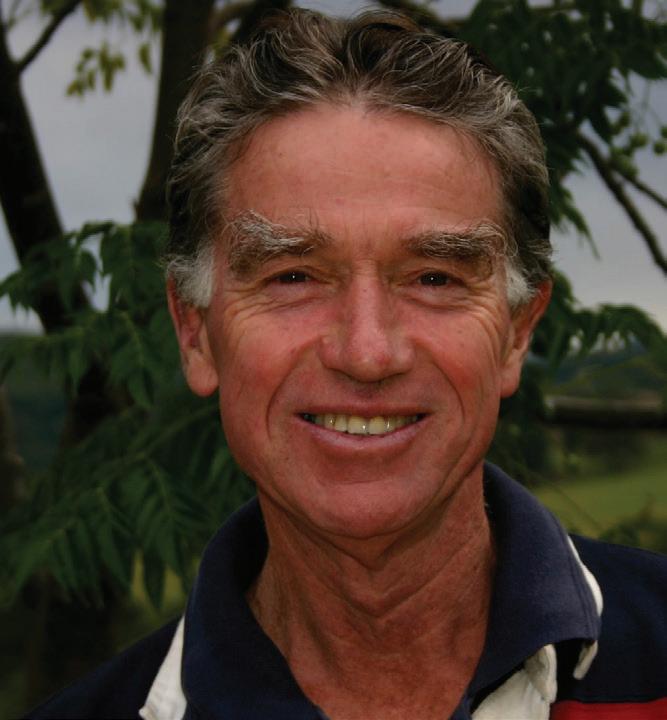
Bar Roll No 874
His Honour was born in Melbourne in 1941. His father, Bryan, a highly regarded orthopaedic surgeon, was one reason, it seems, for his professional interest in personal injuries litigation. His Honour was educated at Scotch College, then studied law at Melbourne University while resident in Trinity College. During these years, following a long family tradition, he represented all three institutions at rowing, including the Scotch first eight (1958, 1959) and winning Intercollegiate (1962) and Intervarsity (1963) when he stroked the victorious MUBC eight in a boat named Keon-Cohen. He also coached Trinity and MUBC crews; played football for Scotch; pursued what became a lifelong passion for golf; was a strong swimmer and lifesaver at Point Leo; and subsequently became a qualified scuba diver, visiting the Great Barrier Reef with his family: wife Sue, daughter Cathy (deceased 2013), and sons George, Ben and Edward.
His Honour graduated LLB in 1964 and was articled to Hector Bathurst at Rodder, Ballard and Vroland, on a salary of £10 per week. He was admitted to practice in March 1966, then worked with Frank Monotti & Co, solicitors, in Dandenong. He transferred to the Bar, read in
chambers with Glen Waldron, later Chief Judge Waldron of the County Court, and signed the Bar Roll in April 1969.
At the Bar, he developed a large personal injuries practice, particularly on the Mildura and Ballarat circuits during the late 1970s and early 1980s. A country practitioner described him as “outstanding, most industrious and extremely efficient.” It seems he pursued a firm policy that cases were best settled.
He was appointed to the County Court by a Labor government in August 1988, where he adjudicated in both civil and criminal jurisdictions. He was well regarded as a hardworking, enthusiastic and firm judge: a tough sentencer but fair. He demonstrated courage and integrity, willing to speak out against improper practices, whether in business or government circles. Practitioners and clients waiting to start proceedings particularly appreciated his practice of calling the next case late in the day, rather than adjourning the court, thus avoiding further cost and delays.
In December 1994, aged just 53, he was diagnosed with cardiomyopathy. Thereafter he managed this often fatal illness reasonably well—albeit on a strict regime of medication and no alcohol—but was unable to sit in lengthy trials.
Rejecting the prospect of retiring on a pension, and with the active support of Chief Judge Glen Waldron and Judge David Jones, he designed and vigorously implemented a new system to improve the listing and management of civil cases in his court. He reviewed and reorganised a chaotic backlog of about 10,000 cases, some up to 10 years old. To pursue the ‘Civil Initiative,’ and ably assisted by his associate, Myles Walker, his Honour sat, often five-days-aweek, from July 1995–1998, listing 10-cases-an-hour for callover and directions. Strict court control was introduced, pursuant to new rules with a strong emphasis on mediation and case conferences. This enhanced
form of judicial supervision led to much-needed improvements in case scheduling and management of the court’s civil workload. These outstanding achievements were featured in the Financial Review, in 1995 and 1996, and attracted interstate judicial attention.
His Honour retired from the court in August 2001 and thereafter focused on his expanding family, managing his farm (also his residence) at Upper Beaconsfield, and playing golf.
He was, for many years, a member at Royal Melbourne and Barwon Heads golf clubs. He played regularly, including on several golf trips overseas. He hit the ball out of sight, did not enjoy losing, made many friends, organised events, and sought election (unsuccessfully) as captain of Royal Melbourne.
He also travelled overseas with his wife Sue, favouring exotic destinations— the Maldives, Easter Island, the Galapagos, Antarctica, Borneo, and Kazakhstan—always, Sue records, “in search of the natural world.”
On 26 January 2018, his Honour was named a Member of the Order of Australia (AM) for services to the law and to the Victorian judiciary, and for voluntary work with several health and community organisations. He was a founding member and president of the Cardiomyopathy Association of Australia; vice-president of the Asthma Foundation for a decade; and a Kew city councillor, 1985–1989.
His Honour died at the family house at Point Lonsdale on 9 March 2020, aged 78 years, utilising Victoria’s assisted dying legislation. Following a lengthy, very painful struggle with motor neurone disease—a debilitating condition for which there is no known cause, nor cure—his departure was both courageous and dignified, while involving extensive consideration for his family and friends.
He will be greatly missed by his extended family, many professional and golfing friends, and colleagues.
DR B A KEON-COHEN AM QC

Bar Roll No 494
The Victorian Bar mourns the passing, on 8 May 2020, of one of its most esteemed members. Barry Watson Beach was a man who strode the legal landscape of this state from the 1950s until judicial retirement on 14 February 2003, with a purpose and a power that swept all before him into victory or justice, and commonly both.
Barry Beach never saw barriers— in life or the law. He sidestepped or jumped them with alacrity. No task was too hard for his mind or his body, possessing an unnerving capacity to see the critical point and the justice in it.
Born on 16 February 1931, he was a member of a post-war working generation to whom opportunity abounded in a rapidly expanding society. Beach seized every opportunity that came his way. He was given little, and he created opportunity by sheer hard work and a prodigious memory and intellect. This was his lifelong hallmark.
The intellect of the young Beach was recognised early—in the grant of various scholarships to enable his passage into the halls of Geelong College, which opportunity was otherwise not open to the Beach family. At The College, he was both
a gifted student and sportsman. He rowed in the Crew. In doing so, he attacked the Barwon, just like the Bar and the law itself in later decades: “grab the oar, row as hard as you can, get in front, hold on for your life and stay there”, he once said to me. Stay he did. He was a leader in the true sense and led without fear or favour.
The Geelong College at that time turned out some of the finest justices of the Supreme Court of Victoria of that era or any era: Justices Crockett, Fullagar, Beach and McDonald. It was in the McDonald family firm, Wighton & McDonald, Geelong, that the young Beach worked as a clerk, and also studied in the articled clerks’ course, by mail and at night. The cost of university was beyond his family’s reach.
On 2 March 1953, he was admitted to practice, and the young Beach, some three weeks later signed the Bar Roll at the tender age of 22. Within 15 years, Beach was in silk and in hot demand. Whether as a stuff gownsman or in silk, Beach held a remarkable relationship with his clerk, Percy Dever. They argued in good spirit and he always held his ground against the force of Percy. He took six readers: Jeremy Darvall, his Honour Barry Dove, his Honour John Dee, David Ross QC, the Hon David Ashley QC and George McGrath QC.
Beach QC was perhaps the youngest ever common law silk and certainly by age.
Whether as junior or in silk, in demonstration of his lifelong quality, he was the master of calculating the percentages and risks in any case and by his discerning mind, conducted all cases accordingly. His precise language as counsel made his submissions a model of clarity. His bearing when he opened the double doors of court and entered, with his perfectly straight back and his wig fitting squarely, left no one in any doubt of the command he possessed in any court or tribunal. Unsurprisingly, all the hardest and best briefs of the day were delivered to Beach QC: the collapse of the Westgate, the collapse of a worker,
even a perceived collapse in the Victorian Police force.
Beach QC’s commission during 1975–1976, in what became known as the Beach Inquiry, was to scrutinise the conduct of the Victoria Police, and it was to be executed “with as little delay as possible” by the command of the Executive Council. The Government of the day had the right person to do so. He sat for 227 days, took evidence from 240 witnesses and received 766 exhibits during 18 months with two additions to his initial terms of reference. He was assisted by Villeneuve-Smith and Coldrey. The Beach Inquiry held no power to deal with witnesses in, for what Beach QC described as, “contempt, insolence and sheer rudeness.” This posed no barrier. Beach QC was dealt a tough hand and through his sheer will and determination, by the force of himself, he produced to Sir Henry Winneke a landmark report, which was delivered under some of the most searing social and political pressures of the time. His family stood firmly with him in one of his toughest and roughest briefs. He delivered his report without delay, with trademark precision (151 pages), containing 17 recommendations. It powerfully enabled the Government to take steps which were long overdue. Cometh the hour, cometh the man.
The judicial career of Mr Justice Beach, unsurprisingly, commenced in 1978. His Honour delivered to the community of the Bench, the Bar, the Executive, the Parliament and society at large exactly that which was promised: judicial initiative well placed. Judicial power was repeatedly delivered in the economical dispatch of justice. It was rooted in an understanding of the everyday person as well as big business and it was delivered with a strong knowledge of the various eddies in the common law, and in any field of the law. This is the bailiwick of the Supreme Court Justice in Victoria. It was his. It produced an efficiency in the work of the court at all levels, Nisi Prius or the Full Court. In the Practice Court, his Honour,
single-handedly and for many years, shaped the by-ways and the practices of counsel, and the profession, and the practices of the community at large. If your point was not clear in 10 minutes, either you were, or your point was, without merit. His Honour’s piercing eyes focused on all you were required to submit until the justice of the matter was revealed. When that time was known, we all knew. No bad thing. To have the confidence of his Honour in your submission was a merit like no other.
His Honour was a much-respected judicial brother to all the judiciary. He had an open door, in the same way as had been shown to the younger Beach. Quick to humour, with a mischievous and happy smile, and a seeming ease in the art of the judgment, whether ex tempore or reserved, his Honour was a model for a generation who were sufficiently fortunate to witness his high skill.
Barry Beach was immensely proud of his family. He was supported in every way, until her last day, by his loved and loving wife Del in the most remarkable of ways. Del Beach was all any barrister or judge could hope for in a life partner. Beach knew it. A photograph of her rested above Beach’s right shoulder in chambers and was a constant reminder both to Beach, and everyone who entered, of her significance in his life. For him to see his two sons, David and Jonathan, our fellow members, stride as he once strode, then each stride again in silk and then ascend to high judicial office, were moments of inestimable and justifiable pride and joy to him as a father and one of the great leaders in the law of his generation.
Vale Barry Beach. You gave your all, always.
S J MOLONEY
Michael Joseph Louis Dowling QC
Bar Roll No 707
Michael Joseph Louis Dowling was educated first
by the Carmelite nuns at the Good Shepherd Convent in Albert Park and then at Mount Carmel College in Middle Park. He completed his schooling at Parade College in East Melbourne and enrolled in the articled clerks’ course through which, whilst working part-time, he qualified for admission to practice. After a short time working as a solicitor, he came to the Bar, signing the Roll in 1963 and reading with Leo Lazarus, later Judge Lazarus QC.
Michael was to become an excellent barrister. Like most of us, he started in the magistrates’ courts and worked his way up to the higher courts.
His practice was in common law, and industrial and commercial law, and included various inquiries, such as that into the Ash Wednesday fires.
He later appeared for the Shire of Mortlake before Sir Norman O’Bryan and a jury, defeating the plaintiffs’ claim that the fire that started at Ballingeich had been caused by sparks emitted by the shire’s road roller.
For two years in the early 1980s, Michael appeared with Stephen Charles and Chris Jessup in the BLF deregistration proceedings, travelling around Australia to put evidence of the union’s misbehaviour in many major building disputes before the judges. Michael’s considerable skills in industrial relations law also extended to the challenging field of discrimination and employment law. In the early 1990s, these skills were recognised beyond Victoria’s borders when he advised the head office of a major Australian trading bank in relation to a difficult discrimination matter. With Michael’s help, the matter was settled, and the bank was able to avoid the embarrassment of another front-page story.
Michael had three readers: Alan Stockdale, subsequently treasurer of Victoria; Roger Shipton, subsequently the federal member for Higgins; and Matthew Strathmore.
Michael took silk in 1979, and he should have become a judge. In August 2000, he was appointed as an assistant registrar at the Court of Appeal and then, within a year, as a Master of the Supreme Court, supervising the administration of civil appeals. He retired in 2007.
Michael was a doyen of the 10th floor of Owen Dixon Chambers; his friends included ED ‘Woods’ Lloyd, Jack Winneke, Alastair Nicholson, Neil McPhee, Hartog Berkeley, Stuart Campbell, Tim Wood, Robert Monteith and many others, including the authors. He served on the Bar Council from 1972 to 1977, and from 1982 to 1987. He also served on more than 20 committees over three decades, including the Industrial Law Practice Committee, the Board of Examiners and the Council of Legal Education.
Michael is remembered fondly by many for his exuberant generosity, his excellent advice to young and old alike, his humour and his unquestioned loyalty.
As well as being a first-rate barrister, Michael was a fine pianist; he began learning the piano at the age of five, achieved his A.Mus.A. when only 15, and later his L.Mus.A. He was a rarity among barristers in having his own Steinway Grand in his house.
He was an outgoing and popular bon vivant, to whom the good things in life were always important. He was also a great family man. He and his wife Valmai were married for 56 years; they had three children and five grandchildren. Michael changed the path of his niece Elizabeth by influencing her to pursue a legal career. And his musical skills will live on for many, particularly his neighbours in Mornington who still, in passing their house, call out to Valmai how much they miss his playing. It is not for nothing that he was known on at least one country circuit as the Joe “Fingers” Carr of the Victorian Bar.
THE HON STEPHEN CHARLES AO QC AND THE HON MICHAEL BLACK AC QC
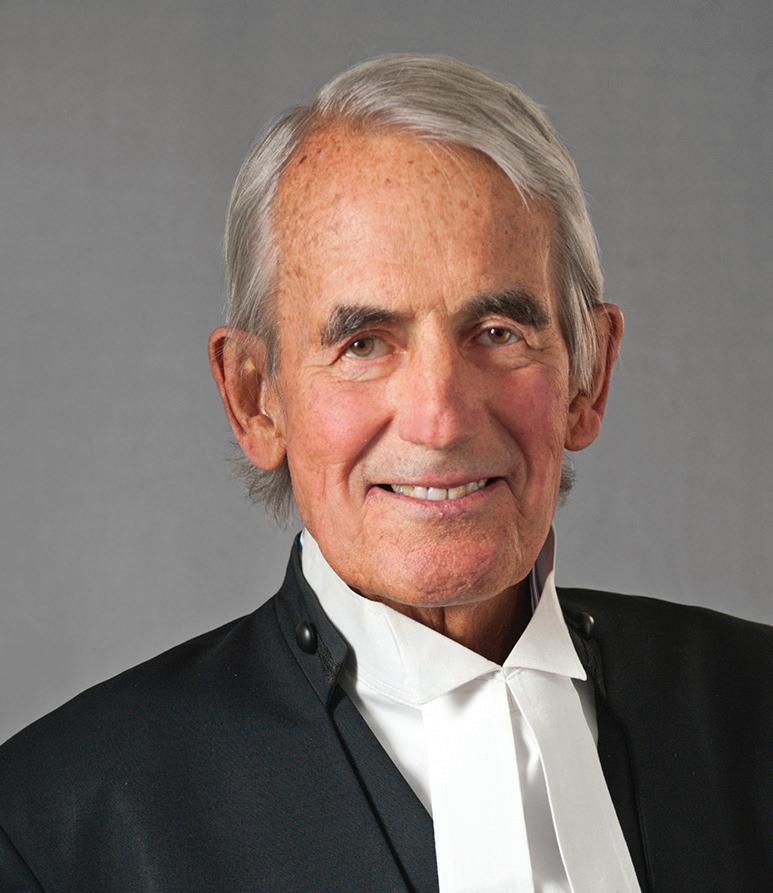
Bar Roll No 795
Richard (Dick) Stanley signed the Bar Roll in 1966. He did not bother practising as a solicitor as he was always destined to be an advocate. He read with Jim Gobbo (who later served as a Justice of the Supreme Court and, ultimately, Governor) and Kevin Foley was appointed as his clerk.
His forensic skills were on show from the off. In June 1968, he appeared at the Ballarat Magistrates’ Court for a client who had returned a breathalyser reading of 0.110. Seemingly unimpressed with Dick’s skills, the editor of the Ballarat Courier penned the following headline: “Technicality beats breathalyser charge”.
In March 1978, I became the second of Dick’s eight readers, occupying a small room in Owen Dixon Chambers. I had met Dick two years earlier when I was a junior solicitor in Ballarat. He was already the counsel of choice for plaintiff firms at the regular Supreme Court sittings in that town. His arrival on circuit was akin to that of the Beatles at the Southern Cross Hotel. The whole office was agog, especially the female secretaries and lawyers. This dashing, handsome, champion amateur footballer (he played for many seasons for the Old Xaverians and was selected for the VAFA state team on three occasions) cast a swathe through clients and staff. And he was fearless in
court—how could we ever lose a case?
I was soon brought down to earth when, after a hectic day in court instructing in a desperate trial, Dick ordered me to accompany him on a run around Lake Wendouree. It was a typical brisk July afternoon in Ballarat. When it started to snow quite heavily, I tried to seek shelter but he pushed me on, saying we still had time for a kick of the footy when we got back to City Oval. Dick always kept his footy boots in the back of the BMW—just in case he was needed. His great friend Jack Bowen had them gold-plated for his 50th birthday.
As a mentor, Dick was extraordinarily inclusive, as all his readers would attest: regular lunches at Campari, running from the Mercantile Rowing sheds, tennis at Kooyong (he always had to win a set) and compulsory kicks of the footy at country ovals. Being his reader, and then, on many occasions his junior, meant that I came to appreciate his brilliance as an advocate. He has been described as the pre-eminent jury advocate of his time. When his record in large and ground-breaking cases is examined, such praise is patently justified—certainly on the balance of probabilities and in my opinion beyond reasonable doubt.
Dick was involved in numerous landmark cases. As a junior, he formed a close bond with Jeff Sher QC and appeared in many prominent trials and appeals, both civil and criminal. In 1983 he took silk and almost immediately developed a common law practice without peer. He regularly obtained massive jury awards of damages for badly injured plaintiffs. One record verdict was overtaken by another. On one occasion, he received a standing ovation at the Essoign—an honour usually reserved for the owners of a Melbourne Cup winning racehorse.
Characteristic of Dick’s work as a barrister was his preparation and the orderly manner in which he conducted a trial. Although he revelled in the court room joust, he was never rude to his opponent or the judge, and he
never worried about the edges of a case. He didn’t panic after the crossexamination of his client and he always saw the big picture. He was never afraid of going to verdict. He was a formidable cross-examiner with an outstanding knowledge of science and medicine, which he regularly deployed with great effect. He was the best reexaminer I have seen. In his silk gown, he struck an imposing figure. As one client remarked, “We can’t possibly lose—we’ve got Darth Vadar.”
Dick also had that rare ability of being able to argue both sides of the case, as demonstrated by his appearances in the cases of Coloca and Thompson. These cases were heard together. On behalf of Mr Coloca, Dick argued that it was patent that his client was entitled to claim exemplary damages against the employer who had exposed him to asbestos. Then, immediately afterwards, on behalf of James Hardie, he contended that there was no authority whatsoever for such a proposition and that O’Bryan J should strike out that part of the claim. What versatility!
Amongst his many forensic triumphs, two stand out. The first was Rabenalt v CSR and Midalco in May 1988—a case made famous by the Midnight Oil song “Blue Sky Mine”. This was the first time an asbestos producer had been before a jury in a claim seeking both general and exemplary damages. The case had everything: opposing counsel appointed to the Supreme Court before the trial ended; counsel (fully robed and wigged) appearing for a witness ending up cross-examined by Dick, who was interested to know why the managing director of CSR could not afford the plane fare to Melbourne. The result was a massive verdict of $675,000 for both general and exemplary damages, which Dick held on appeal. The case paved the way for fatally injured plaintiffs to recover damages from asbestos manufacturers and producers. Dick continued this fight for the rest of his career. Over 20 years later, in King v
Amaca, he recovered another record verdict, which again survived the scrutiny of the Court of Appeal.
The second standout case was PQ v The Australian Red Cross Society and Ors. Dick appeared for the plaintiff, who had acquired HIV as a result of a blood transfusion. The plaintiff sued three extremely well-resourced defendants, whose six counsel had agreed not to declare war on each other and to concentrate their attack on the plaintiff’s case. The trial went for six months and was the longest civil jury trial in Australian history. It was hard fought, with numerous applications to discharge the jury. Ultimately, on Christmas Eve 1990, the jury returned a verdict against the Alfred Hospital, with a substantial award of damages in favour of Dick’s client.
Both these cases paved the way for many other grievously injured persons to settle their cases without having to go to court, while nevertheless receiving fair and reasonable compensation. There are many in the community who, almost certainly unknowingly, owe a real debt of gratitude to Richard Stanley QC.
But he wasn’t perfect—there were some foibles. The major one was his inability to handle technology in any shape or form. He was a professional and unrepentant Luddite. He detested mobile phones and invariably got confused when cross-examining based on a Google search—“what in the hell is this goggle thing?”—or a Facebook entry—“but where is the book?”. At a directions hearing in a large class action that I was managing, I had the temerity to suggest that we consider a more modern technology-based approach. Dick responded, “Your Honour, I firmly oppose this idea of an email trial.”
In 2013, I had the rare pleasure of what I suspect is an unusual experience: to sit as judge on a trial conducted by my mentor. Dick had lost none of his capacity to present and conduct a trial. A couple of weeks later, I had an even rarer pleasure, when the son of my mentor
appeared before me. Although Richard Junior and Dick have somewhat different styles, I closed my eyes and thought I was back in that small room in Owen Dixon Chambers where I had learnt so much 35 years earlier.
Dick’s capacity to maintain his good humour and kindness in the face of adversity was remarkable and typified his spirit. He was lovingly supported by his wife, Sue, and children, Richard, Emma and their families. And, of course, James, his
Nlate eldest son, from above. He was a wonderful man, a true friend, and a remarkable colleague. We will miss him enormously, but the memories will never leave us.
THE HON JACK FORREST QC
Bar Roll No 780
Robert Langton recently passed away at the age of 82 years. Robert was admitted to practice in 1962. He came to the
ot many reputable legal types sleep with pistols under their pillows, nor eat their meals with a pistol laid neatly next to the cutlery. But for Ian Thompson and his wife Mary, those were the realities of serving as a colonial officer in Kenya during what was then called the Mau Mau uprising.
Ian Thompson was born in 1927 and died on 23 February 2020. He will be known to many as a former deputy president of the Commonwealth AAT. He was one of the finest men I have known.
Ian obtained a First in Greats (Latin and Ancient Greek) at Cambridge, putting him in a rarefied group of indisputably fine minds. Unlike many of his fellow classics students, Ian did not come from a privileged background. He attended school at Dulwich College in London and university at Trinity College, Cambridge on scholarships. The snobbery he endured at school instilled in him a deep sense of social justice. Brushes with death started early in Ian’s life during the World War II blitzes of London. After university, Ian undertook military service in Egypt. He then joined the Colonial Office, serving in several dangerous postings in Kenya. The pistols weren’t for killing attackers; they were for a quick suicide if captured by the Mau Mau. Fortunately, Ian loved to play football in local competitions. And Mary was told by a local that Ian was safe with the Mau Mau, because he played football with them.
Bar in 1966 and read with Abraham Monester QC.
Robert was appointed as a magistrate in 1990 and served until 2008.
In 2000, he was appointed as a VCAT member. He presided in the Credit, Residential Tenancies and Building lists for eight years, where Judicial Registrar Angela Soldani remembers him as being “always the gentleman.”
Vale Robert Langton.
From there Ian became Chief Justice of Nauru where he met “Her Majesty”, as he would say, who visited on her yacht. From commissions in Fiji, rewriting many of Nauru’s laws, being moot master at Monash Law to sitting as Chief Justice in Nauru, he was certainly busy. Then followed an appointment to the AAT, where in time Ian became its Victorian deputy president.

After “retiring” in 1993, Ian served as a visiting justice to the Fijian Court of Appeal. He also served on Australian insurance industry regulatory panels.
Ian was married to Mary for 63 years and was father to three daughters. Personally ascetic, his family remembers many generous habits: always tipping generously in poor countries, always spending locally the money earnt in that country.
Ian studied law during his safaris as a district officer in Kenya, enrolling at Lincolns Inn from afar. He became a magistrate in Nairobi, where he worked until 1963. His next major posting was to Fiji, where he became a Puisne Judge. His guests there included Lord Denning, whose reformist approach Ian deeply admired.
As his associate in 1990, I observed his careful habits: arrive and depart at sensible hours, bring lunch from home, work hard every minute of the day. He heard a very large number of cases, many of them involving complex Commonwealth legislation. Ian never, ever, failed to hand down his many written decisions within 30 days, no matter what the work load. What a privilege it was for me to observe, as he sought to find the relevant facts and apply the law, always with a view to the humane, considerate application of law. He was rarely appealed, almost never successfully, but he was truly indifferent to appeals. He would say, “My job is to get through the cases and deliver prompt justice. If I make a mistake it can be fixed.”
It was a very different world he worked in at the Colonial Office, and times have changed. But his was a life of humble service, which he carried out with absolute integrity.
JULIAN MCMAHON AC

‘Magna Carta’
Documents exist under many names and in many forms. Most of the various words for documents are peculiar to the law.
Our commonest word for a thing with writing on it is document. It comes from the Latin docere—teach. From the original meaning of lesson or proof, it came to mean “something which serves to
instruct or prove”; then “something written containing proof or other information about any subject”.
The original pedagogical meaning of document is preserved in one sense of the related adjective documentary. When documentary is used as an adjective, it simply means of or pertaining to a document; but when it is used elliptically as a noun “a documentary (on television/radio)” it generally means a broadcast with an educational purpose. Oddly, this use of documentary
seems to be confined to modes of instruction which do not rely on documents. When a documentary series on TV results in the inevitable book available at ABC Shops, the book of the series is not called a documentary book.
In law, we have lots of documents by specialised names, including affidavit, writ, indenture and charterparty. Originally a charterparty was carta partita: a charter which has been divided into several parts. Traditionally it was cut with an indented line, with the text written both above and below the cutting line, like an indenture. (Before photocopiers and email, the indenture was a way of each party having an unquestionable portion of the original document, so the text was reliably that of the original. In modern times charterparty came to refer specifically to the charter or deed between owners and merchants for the hire of a ship.)
In Latin, a charter (carta) is simply a piece of paper; later in special use it was a deed, then a written document delivered by the sovereign or legislature, of which Magna Carta is the best known example. It is arguably the western world’s most famous document. Its name has a strange history.
Popular history tells us that Magna Carta was an agreement between King John and his Barons, signed on the meadow at Runnymede on 15 June, 1215. So, on 15 June 2015 many people commemorated 800 years since it was signed. But, the document that was sealed on 15 June 1215 was the Articles of the Barons. It did not become known as Magna Carta for several years.
King John was the youngest of five sons of Henry II. His oldest brother, Richard, was King, but went off to fight the Crusades, where he earned his nickname “Lionheart”. John’s elder brothers William, Henry and Geoffrey died young. Richard died in 1199, and John became King.
It is arguably the western world’s most famous document. Its name has a strange history.
Richard and John both incurred huge expenses in war: the Crusades and in suppressing rebellion in their French domains in Normandy and Anjou. Both leaned on their nobles to support the expense. John, who had managed to make himself deeply unpopular, met resistance. He made increasing demands for taxes of various sorts, including scutage—money paid to avoid military service—and he sold wardships and heiresses for large sums. Henry II and Richard had done the same, but John’s nobles resisted. By May 1215, the barons had occupied London and made a series of demands.
The Articles of the Barons was King John’s pragmatic response. In June 1215, the barons met King John at Runnymede. The Archbishop of Canterbury, Stephen Langton, played an important role in mediating the dispute and eventually the Articles of the Barons were prepared and signed.
Weeks later, the agreement was set aside by the Pope: King John, who was not a reliable person, prevailed on Pope Innocent III to declare the Deed invalid. The Pope said it was “not only shameful and base but illegal and unjust.” He declared it null and void, and ordered King John not to observe it. This was in August 1215, just 10 weeks after the great symbolic meeting at Runnymede.
The barons were not happy. John died in October 1216. His son Henry was only nine years old. Henry’s advisors saw that re-issuing the Charter in modified form would help keep the young king in power. So an amended version was issued in 1217, under the title “Charter of Liberties”. At the same time the Charter of the Forest was issued. The Charter of Liberties was the bigger of the two, and soon became known as the Great Charter: Magna Carta.
When he had come of age, Henry III swore his allegiance to a modified version of Magna Carta. That was on 11 February 1225. This modified version is the version best known, and is closer to our modern thinking about basic freedoms.
The 1215 version of Magna Carta includes many provisions which are concerned with taxes. For example:
(2) If any earl, baron, or other person that holds lands directly of the Crown, for military service, shall die, and at his death his heir shall be of full age and owe a `relief’, the heir shall have his inheritance on payment of the ancient scale of `relief’.
(12) No `scutage’ or `aid’ may be levied in our kingdom without its general consent, unless it is for the ransom of our person, to make our eldest son a knight, and (once) to marry our eldest daughter. For these purposes only a reasonable `aid’ may be levied. `Aids’ from the city of London are to be treated similarly.
(30) No sheriff, royal official, or other person shall take horses or carts for transport from any free man, without his consent.
And there were plenty of surprises, including this:
(10) If anyone who has borrowed a sum of money from Jews dies before the debt has been repaid, his heir shall pay no interest on the debt for so long as he remains under age, irrespective of whom he holds his lands. If such a debt falls into the hands of the Crown, it will take nothing except the principal sum specified in the bond.
The only part of the document which is widely remembered is found in Articles 39 and 40:
(39) No free man shall be seized or imprisoned, or stripped of his rights or possessions, or outlawed or exiled, or deprived of his standing in any other
way, nor will we proceed with force against him, or send others to do so, except by the lawful judgement of his equals or by the law of the land.
(40) To no one will we sell, to no one deny or delay right or justice.
Together, these became Article 29 of the 1225 version.
The modern importance of Magna Carta is largely due to Sir Edward Coke. In 1594, he became AttorneyGeneral and still held that role when James VI of Scotland became James I of England in 1603.
Sir Edward Coke, as AttorneyGeneral, was a favourite of King James because, on many occasions, he had supported King James’s view that the King ruled above the law. In 1606 he was rewarded for his loyalty and good service by being appointed Chief Justice.
On the bench, Coke’s view seems to have changed. This sometimes happens to judges, to the great irritation of governments. In a number of cases, Coke CJ insisted that the King ruled subject to law
It is a principle we take for granted these days, but in the early 17th century it was hotly contested. He rejected King James’ interference with the operation of the courts. The King dismissed him from office in 1616. He re-entered Parliament.
In 1627 (the second year of the reign of Charles I) the King ordered the arrest of Sir Thomas Darnel and four others, who had refused to advance a compulsory “loan” to the King. They sought habeas corpus. The jailer answered the suit by saying the five were held “per speciale mandatum Regis” [by special order of the King].
Darnel’s case in 1627 prompted Coke to draft for Parliament the Petition of Right (1628). The Petition raised, with exquisite politeness, various complaints about the King’s conduct, including that:
he had been ordering people, like Darnel, to be jailed for failing to lend him money; he had been billeting soldiers in private houses throughout the country against the wishes of the owners;
When we hear about “The Bill of Rights” these days, we automatically think of the United States of America. It is not an accident.
he had circumvented the common law by appointing commissioners to enforce martial laws and those commissioners had been summarily trying and executing “such soldiers or mariners or other desolate persons joining with them as should commit … (any) outrage or misdemeanour whatsoever …”;
he had been exempting some from the operation of the common law.
The Petition of Right reflected Coke’s distilled thoughts about English law and politics. In his most famous work, the “Institutes of the Lawes of England”, Coke elevated Magna Carta to previously unrecognised significance. He claimed of it that it was the source of all English law, and in particular he claimed that it required that the King rule subject to law, not beyond it. He said that Magna Carta “is such a fellow that he will have no sovereign.”
The Petition of Right was Coke’s way of creating (he would have said “recognising”) the essential features of the English Constitutional framework.
The Petition of Right was adopted enthusiastically by the Parliament but Charles I would not agree to it. Charles I, like John centuries earlier, wanted to continue raising taxes without the inconvenience of Parliament. Again, the nobles were unhappy. The Civil War started in 1642. Charles lost the war and, in 1649, lost his head. Then came Cromwell, Charles II and James II.
James II was a Catholic and was not popular. His son-in-law, William of Orange, was persuaded to usurp the throne of England. In what became known as the “Glorious Revolution”, on 5 November 1688, William landed at Brixham to take the throne.
But there was a catch: William had agreed in advance to accept the Petition of Right. So, in 1689, the new
monarch adopted the Petition of Right and it became the English Bill of Rights. By this path, Sir Edward Coke’s views on Magna Carta gained an unassailable place in the fabric of English law.
The English Bill of Rights does, in some ways, reflect Magna Carta.
We do not think about the English Bill of Rights much these days. When we hear about “The Bill of Rights” these days, we automatically think of the United States of America. It is not an accident. The American colonies had been established by the English when they settled Jamestown in 1607. By 1773, things were not going well. The Boston Tea Party took place on 16 December 1773, in protest against having to pay taxes to a distant government in which they had no representative. In 1776 the colonists decided to sever their ties with Britain and on 4 July 1776 they signed the Declaration of Independence.
In 1789 a Constitution was proposed for the newly independent United States of America. It was a bold, and unprecedented, venture. The idea of a federation of states with local as well as a central government was a novelty back then. The thirteen colonies, anxious about the possible tyranny of a Federal government, put forward 10 amendments to the Constitution. Those amendments are known, in America and across the English-speaking world, as the Bill of Rights. They closely reflected the English Bill of Rights of 1689 (apart from the 1st, 5th and 8th amendments).
The notorious 2nd amendment (the right to bear arms) has a parallel in the English Bill of Rights of a century earlier. Clause 7 of the English Bill of Rights provides “That the subjects which are Protestants may have arms for their defence suitable to their conditions and as allowed by law”.

What unwanted sexual attention feels like, and what we should do about it
Red Bag / Blue Bag is taking a short ‘iso’ break for this issue. In its place, reflections from junior and senior counsel on sexual harassment, following recent news of alleged misconduct at the highest levels of our court system.
When I completed my first year of law school, I went to the pub with my first-year law lecturer, his mate, who was also a law lecturer, and a group of students. I had led a pretty sheltered upbringing. I was rapt to be having drinks with people I looked up to. It made me feel really special—a great way to finish off the year. After a few drinks, I felt a hand under the table stroking my leg. It was the lecturer who was the ‘mate’. I had barely said two words to him. Creeped out, I went to a phone box outside the pub to let my parents know I was running late. Suddenly, I felt a male body squeeze into the phone box behind me. He said breathy words into my neck, trying to
kiss me at the same time.
He told me his wife didn’t understand him. I was stuck. Thankfully, some other students came out of the pub. One way or the other I found myself back outside in the clear night air. I went straight home, feeling crap.
Months later I worked up the courage to tell a friend who knew this person. It wasn’t a complaint of any sort. I didn’t label what had happened; it was just wrong. She confronted him. He said to her, “I don’t know why I keep doing it.” So, there were other women out there?
I’ve walked past him over the years, feeling faintly sick. I’m sure he doesn’t even remember who I am.
I have not had the ‘ice bucket-withchampagne-in-a-hotel room’ routine. That happened to a friend of mine when we were junior solicitors. She
returned grey-faced from what she thought was a mentoring occasion with a legal luminary, a person she so deeply admired. I can remember how excited she was beforehand. Afterwards, she could barely speak, except to describe his heavy hands on her shoulders. He told her how beautiful she was, as she looked out the window of his hotel room, desperately sorting out a graceful escape route in her mind.
All I’m hoping to do by sharing this, is to indicate what it feels like when unwanted attention is received. It may feel very exciting to the person initiating it. But that’s not the whole point, is it?
Here are couple of tips which may assist, when in doubt. Stroking people under the table is typically creepy unless you’ve (consensually) been intimate first. The line “my wife doesn’t understand me” is a really average cliché—it does not work. Champagne is not some kind of seductive witch’s brew. It’s just a very nice drink. To be told you’re beautiful can feel fantastic, done the right way. Done the wrong way, it’s objectifying. The alternative is to come from a place of being considerate and caring, aware of boundaries and mindful of the person you are with. Then, you have made a wonderful start, potentially enriched by friendship, even if it does not develop as you would wish.
Sexual harassment as a topic is in one respect similar to money—just not the sort of thing one talks about in polite company.
If it is not already patently obvious, in the workplace, sexual harassment is behaviour demonstrated towards our colleagues which includes: sexually explicit remarks or gestures, leering, uninvited physical contact, repeated or inappropriate invitations to spend time alone or go out on dates, intrusive remarks about physical appearance, intrusive
questions about one’s private personal life, unwelcome requests or pressure for sex, sending indecent texts and leaving sexually loaded remarks on social media.
It is well understandable why many victims choose not to talk about it, let alone formally respond to instances of sexual harassment. It is distressing and a cause for considerable anxiety and embarrassment for those who, in the main, are women who have been subjected to unwelcome treatment of a sexual nature by their predominantly male and in many instances, senior colleagues. It can also be risky in terms of one’s career to formally complain about an instance of sexual harassment. For the rest of us, its occurrence and recurrence presents an uncomfortable truth about our workplaces that many, particularly men, feel awkward in acknowledging, let alone addressing this behaviour— many simply adopt the attitude, “nothing to do with me, not my problem”.
However, as is the case with many taboos, all it takes is one card too many for the house of cards to fall, which is what has happened to our profession in recent weeks.
It is now regrettably crystal clear that no workplace, including the upper echelons of our profession, is immune from the incidence of sexual harassment.
Consistent with the legal and moral authority which accompanies our roles as barristers and judges, we have a social responsibility as a profession to live by those standards we require others in the community to follow.
This requires us as individuals and as a college to commit to zerotolerance of sexual harassment and nothing less.
I say this to my brothers at the Bar, our sisters have had a gutful of this sort of behaviour and quite rightly so. It is toxic. Especially when it is senior men in our profession who prey upon our younger and more professionally vulnerable siblings. Recent research
No more. To ignore is to condone. I shall no longer ignore.
undertaken by the Law Council of Australia has revealed that this is what many of our sisters have had to face at some stage or another in their legal careers. Consider what the experience of sexual harassment can do to a young female colleague, where it can result in those subjected to this behaviour actually abandoning the career they’ve invested so much in and leaving our profession. Imagine for a moment if what happened to our junior barrister who has courageously shared her sexual harassment story above, actually happened to your spouse, sister, daughter, niece or good female friend. Yes, you wouldn’t tolerate it either.
Thankfully, nowadays, the large majority of men at the Bar do not sexually harass women and are equally appalled as women are, when it occurs. I have been fortunate to have been mentored by some marvellous male role models—true gentlemen and scholars in every sense of the expression. There are plenty of good guys out there. However, there is still a minority of men in our profession who just do not get it. Perhaps now, in light of recent events and the conversation about sexual harassment in the legal profession which is now happening like it has never happened before, the penny will finally drop amongst those remaining few.
The issue here is not so much about gender. It is about respect. It is about us all treating each other equally as peers, irrespective of gender, sexual orientation, religion, political views or where we went to school. It is about us all supporting each other, looking out for each other and not taking advantage of each other, in what is a challenging and yet rewarding way to earn a living. It is about us being proud of our Bar and deciding what sort of college we wish to be—an inclusive organisation of like-minded independent and
fearless advocates who believe in justice and the rule of law and where integrity, diligence and ability are the hallmarks upon which we discriminate amongst ourselves. It is about what sort of country we wish to live in. Sexual harassment has no place in this world of ours.
We all have a choice as to whether or not we tolerate sexual harassment. We can ignore it, or we can support those subjected to it and call it out when we see it.
I deeply regret ignoring an episode of sexual harassment many years ago when I was a baby barrister. I still remember it clearly. It was at a Christmas party in chambers. There was a queue at the loo, so I beat a path via the fire escape to the bathroom on the floor below. While descending the fire escape I stumbled across a well-known senior male barrister (who has long since retired from practice) who had cornered and was slobbering over a younger female barrister (whom I did not really know), who had had too much to drink and was not really in a position to resist the male’s advances. I subsequently learned that the male had ‘form’. Reflecting on the episode now, I am sure the approach was not invited at the time. I should have stopped and asked if my sister was OK and supported her. I didn’t. I quickly shuffled past the scene and avoided the fire escape thereafter. Turns out the female barrister didn’t stay at the Bar for very long. No more. To ignore is to condone. I shall no longer ignore.
To all of my colleagues, now is the time to join with me in not just saying ‘no more’, but also committing to ‘no more’. Actions speak louder than words. Downloading, reading and observing the Victorian Bar’s Policy Against Sexual Harassment, (available on the Bar website at vicbar.com.au/file/5502) is a good first step.
PETER HEEREY
Lawyers and judges can be considered a species of the genus writer. Some have ventured beyond their professional word output into the worlds of fiction, poetry and essays or even, in the case of a former High Court judge, playwriting.
But in Australia none could rival Nicholas Hasluck the retired Western Australia Supreme Court Judge who has published no fewer than 13 novels, 10 volumes of essays and memoirs, a couple of collections of short stories, and four volumes of poetry. He has won the Age Book of the Year prize for his novel The Bellarmine Jug and been twice short-listed for the Miles Franklin Prize. The rather hackneyed adjective ‘award-winning’ certainly applies to him.
Beyond the Equator recounts a formative period of his life. In 1964, like many of his generation, after completing his university degree he headed off to the Northern Hemisphere. The saga includes shipboard life on the way to England, parties with fellow expats in “Kangaroo Valley” (Earl’s Court) and touring in mainland Europe.
In Hasluck’s case there were the special features of studying (successfully) for a BCL at Wadham College, Oxford and, most importantly of all, meeting a delightful lass from the Cotswolds who became a partner in a long and very happy marriage.
Hasluck commenced with some distinctive genetic advantages for a writer. His father, Sir Paul Hasluck, had been a journalist, theatre critic and war historian. He entered politics and became Minister for External
Affairs and later Governor-General. Sir Paul’s wife Alexandra, the mother of Nicholas, had published biographies and a history of the convict system in Western Australia.
A very useful skill, or discipline, was Hasluck’s ability to keep detailed diaries and correspondence. An example is a vivid description of a visit to Berlin. After crossing through East Germany, the diary records the searches of cars with “their back seats taken out and their roof racks of luggage tested by stern sentries with wooden swagger sticks.”
Real time extracts from diaries and correspondence give an immediacy and intriguing detail to the narrative.
In his time at Wadham, Hasluck had as a tutor one Peter Carter, “a master in the use of fear as an academic weapon.” A fellow Western Australian, David Malcolm (later to become Chief Justice of that state), also suffered under the Carter regime. In his final winter vacation Malcolm had planned to join a rugby tour to Belgium and France, followed by a visit to Berlin and Christmas with friends in Norway.
Carter got wind of this, summoned Malcolm to his presence, and told him that, if he were to have any chance of getting a first in the BCL, the Christmas vacation would have to be devoted to work. Malcolm protested, but to no avail. In desperation he said he had to have at least a short break at Christmas. Whereupon Carter replied, “What were you thinking of— the morning or the afternoon?”
In Hasluck’s experience, a central element of Oxford life was the Oxford Union. A forum for discussion with a debating chamber laid out like the House of Commons, it also had an
extensive library and dining facilities. Hasluck records seeing leading Tory figure Lord Hailsham giving “the most astonishing feat of oratory I have ever witnessed.”
At the beginning of his speech the audience was totally against him and, with catcalls and interjections, constantly abusive. But he won them over. He had presence. He had wit. He was cogent. Above all, he was passionate. ‘Freedom can only be won at the expense of tyranny,’ he declared, ‘by concern for the common good.’ At the end of it all the students rose to their feet in a standing ovation, and when the vote was taken his team had won. It is the only time in my life that I have seen an entire audience persuaded from one point of view to another on a political subject in the space of twenty minutes or so.
As one who has achieved a rare degree of eminence in both law and literature, Hasluck has some thoughtful comment on the relationship between the two fields. Law he sees as “not a matter of solving puzzles or saluting abstract rights but of getting to grips with individual stories.” Literature is “a way of understanding viewpoints other than one’s own.”
The book is a fine read. It takes us not only beyond the equator, but back again.
the Equator by Nicholas Hasluck AM QC
Australian Scholarly Publishing Pty Ltd PB 282 pp RRP $34.95
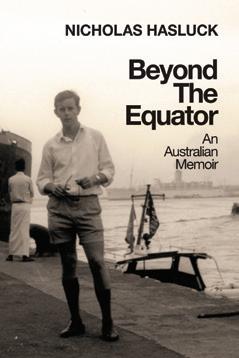
by Peter M Hall
JULIAN BURNSIDE
Peter M Hall QC is a former judge of the Supreme Court of NSW. He was appointed Chief Commissioner of ICAC (NSW) by Premier Gladys Berejiklian in August 2017. The first edition of the book was published in 2004; the second edition was published in 2019. In the preface Hall writes:
…the Public trust concept is foundational to integrity in government and public administration…
The book is very big, even as law-books go. It runs to more than 1200 pages, and contains chapters on:
1. Integrity and corruption in public office
2. Corruption investigations—evidential matters
3. Bribery and corruption offences
4. Search and seizure under statutory warrant
5. Electronic surveillance and telecommunications interception.
6. Controlled operations and entrapment
7. Privilege and public interest immunity
8. Commission of inquiry principles
9. Judicial review of commissions of inquiry
10. Investigative commissions, the principle of legality and the right to a fair trial.
Chapters 11-16 deal with ICACs (by whatever name) in NSW (ICAC: Independent Commission Against Corruption), Victoria (IBAC: Independent Broad-based Anti-corruption Commission), Queensland (CCC: Crime and Corruption Commission), Western Australia (CCC: Crime and Corruption Commission), South Australia (ICAC: Independent Commission Against Corruption) and Tasmania (IC: Integrity Commission). Sadly, it does not contain a chapter on a Commonwealth ICAC, because we don’t have a Commonwealth ICAC. Recent and earlier events make it obvious that we need one.
Hall knows his subject extremely well. Apart from his time as a legal practitioner, and as a Judge of the NSW Supreme Court, he is Chief Commissioner of ICAC in the State that spawned the Rum Corps: a phenomenon which, on one view, has never disappeared.
In the chapter on integrity and corruption in Public Office, he notes that:
While codes of conduct and statutory regulation have increasingly been employed to establish standards, constraints and imitations, the important task of ensuring compliance, and of determining what constitutes proper or improper conduct in particular circumstances, is less certain
and tests the law’s capacity in setting boundaries by which such conduct may be evaluated…
That is clearly so and, for reasons which are obscure, the standards appear to be slipping. While misconduct in public office is a common law offence in NSW and Victoria, with statutory equivalents in the Commonwealth, the ACT and South Australia, prosecutions for misconduct in public office seem to be much less common than the conduct they are aimed at.

Peter M Hall
This is a book which explores its subject in extraordinary detail. So, for example, chapter 5, which discusses electronic surveillance and telecommunications interception is divided into 14 different sections. Selfevidently, we live in an age when electronic surveillance has vastly more significance than ever before, and the techniques are developing at a remarkable rate, but the treatment of the subject in Hall’s book is exemplary.
Since the first edition, there have been royal commissions concerning corruption in public matters. So the second edition discusses the functions, powers and procedures of royal commissions and anti-corruption commissions.
On one view, such a large book may deserve a much longer review than this. But anyone who is interested in the subject of public corruption will, almost certainly, want to explore this book. It is the sort of book which may only need to be examined with specific questions in mind. But it is hard to think of any questions it would not answer. If I needed to express any criticisms of the book at all, there would be two only: the index is very brief, just 35 pages for a book of over 1200 pages. And it gives little or no attention to the glaring shortfall in Australia’s anti-corruption system: the Commonwealth government seems to be a hotbed of corruption and misconduct and yet, we do not have a federal ICAC. If the Murray-Darling fiasco was not enough, the sports rorts scandal which emerged after the 2019 federal election added weight to the need for properly resourced corruption fighting at the federal level.
The timing of the second edition could hardly be better. We live in a society in which public corruption seems to be thriving. But the absence of a properly resourced federal ICAC is the shadow cast by this book.
The essential point of Hall’s second edition is powerfully made (coincidentally, and unintentionally) by Donald Trump, whose conduct shows just how much we depend on honest, competent behaviour by our officials. Consider, for example, Trump’s response to the coronavirus pandemic and the killing of George Floyd by Minnesota police, coupled with his successful stacking of the federal judiciary. Right now, various forces are driving society to the edge of revolution or collapse. In these circumstances honesty, competence and public trust in our officials matter more now than ever before.
JUSTIN WHEELAHAN
The administrative law Bar don’t cite Homer J Simpson much. Perhaps that will change with the publication of Janina Boughey and Lisa Burton Crawford’s Interpreting Executive Power, a new collection of essays published by Federation Press. Matthew Groves has contributed an essay “The Return of the (Almost) Absolute Discretion”. “I am no fan of legal or other philosophy”, writes Groves, “but even I cannot ignore the greatest American thinker of our time, Homer J Simpson. Among his many piercing thoughts on life was the rhetorical question ‘donuts. Is there anything they can’t do?’”
Groves cites the Marge vs the Monorail, episode 12 from season 4 of the Simpsons, as authority for this proposition. This segues into a discussion of the analogy Ronald Dworkin made between discretion and the hole in the doughnut in Taking Rights Seriously. “Discretion, like the hole in the doughnut,” wrote Dworkin, “does not exist except as an area left open by a surrounding belt of restriction. It is therefore a relative concept.” Groves then examines how courts have eroded the scope of broad discretionary powers, while at the same time the breadth of the ‘national interest discretion’ has become largely beyond the interpretative control of the courts. It is great to see one of the three coauthors of Aronson’s Judicial Review of Administrative Action taking Homer J Simpson seriously.
Groves’ essay is one of the many gems you will find in this excellent collection of essays for any barrister who has to ponder the depth and breadth of executive power. The editors explain in the first chapter, “Executive Power in an Age of Statutes”, that the focus of the book is on how courts do interpret executive power and should interpret power. As Justice Edelman notes in the preface:
The title to this book reveals the highly ambitious project of its authors and editors to explain the scope of executive power. To do so requires an explanation of executive power, its operation, and the manner in which courts constrain that power. The very starting point illustrates the minefield of theory that the authors encounter.
The minefield of theory surrounding executive power, deference to the administrative state, statutory displacement of the prerogative, and the values that underpin the application of the principle of legality can be navigated a little more easily after reading chapters
Interpreting Executive Power by Janina Boughey and Lisa Burton
Crawford (2020/272pp) RRP $160.00
Authority to Decide—The Law of Jurisdiction in Australia by Mark Leeming (2020/368pp)
RRP $175.00
Justice in Tribunals
by J.R.S. Forbes (2019/464pp)
RRP $150.00
Federation Press Publishing Pty Ltd



clearly explaining these concepts by the editors, John McMillan, John Basten, Brendan Lim, Bruce Chen, Anna Huggins, Sangeetha Pillai, Shreeya Smith, Nick Seddon, Dominique Dalla-Pozza, Greg Weeks, Peta Stephenson, and Amanda Sapienza.
Federation Press has also published a second edition of Mark Leeming’s Authority to Decide—The Law of Jurisdiction in Australia. Some text books, like Gurry’s Breach of Confidence, get cited so much they become the law. Authority to Decide is another case in point: many of the points in the first edition have now received judicial support from the High Court, such as avoidance of the term “accrued jurisdiction”, and cautioning against the wide use of the term “inherent jurisdiction”.
This second edition contains a section on the New South Wales Court of Appeal and Criminal Court of Appeal, a new account of the role played by the cross-vesting legislation in requiring some appeals from state and territory courts to be brought to federal courts, and references to some 240 decisions made since the first edition was published in 2012, lucidly explaining significant developments in the field. As the author’s preface explains, the book is written for the working lawyer, and is “intended to be useful to a practitioner in answering a particular problem, as well as permitting deeper reflection on issues of principle.”
J.R.S. Forbes’ Justice in Tribunals is now into its fifth Federation Press edition. As the preface notes, since its first publication in 1990, the text has been noted with approval by the Supreme Court of New Zealand, and Australian federal, state, and territory courts—most recently in the decision of Justice Riordan in Setka v Carol about whether the rules of a voluntary organisation become justiciable when a voluntary association attains significance in public affairs.
As the author states in the preface, “This book deals with the court’s application of jurisdictional limits and procedural fairness to other bodies—public and private— that decide the rights of individuals.” This new edition has useful chapters updating the 2014 fourth edition on jurisdiction, judicial control of domestic tribunals, private tribunals, legal error, the right to be heard, tribunal procedure, bias, reasons, and judicial control of royal commissions. Justice in Tribunals is an indispensable tool for any barrister venturing into a disciplinary or civil administrative appeals tribunal.
ANNETTE CHARAK
The swift implementation of social distancing measures is no reason to drop spelling standards. Or so one attentive individual seems to have thought in correcting a notice in the lifts of Owen Dixon West (see image, right). But was the original use of “practice” wrong? The answer is not the easy “yes” or “no” one might first think.
The starting point is simple: verbs are spelt with “s” and nouns with “c”—think advise and advice. This distinction holds true for other pairs like license and licence, and practise and practice, despite no difference in pronunciation. (Curiously, it is also true for prophesy and prophecy.) This distinction between “s” for the verb and “c” for the noun is consistent in standard UK English.
However, in standard US English, practice—with a “c”—has been adopted for both the verb and the noun (and “license”—with an “s”— for both the verb and the noun). Therefore any use of “practise” would be wrong in US spelling. In Australia, both US and UK customary usage are generally acceptable, meaning the original notice was arguably correct. However, spelling conventions are a question of style, often governed by a style guide. Like all style guides, the VBN style guide is intended—in the interests of consistency—to resolve questions that are neither right nor wrong, but just a matter of style. UK spelling is more prevalent in Australia and is therefore adopted for this publication. That means using “practise” for the verb and “practice” for the noun. This editor therefore commends the correction, despite recognising that the original author was not wrong.

Beyond this lift notice, a question sometimes arises in the context of lawyers’ admission to practise. Or practice? The “practise v practice” entry in our style guide reflects a common—if not universal—practice in Australia and the UK: to refer to “admission to [legal] practice”; hence the noun. In some contexts, one does see the minority “admitted to practise [law]”, referring to the action of practising law. And only a pedant—or an American—would take issue with that use of “practise”.
Beyond this lift notice, a question sometimes arises in the context of lawyers’ admission to practise. Or practice?
Campbell Thomson
Barbara Cotterell signed the Bar Roll in 1973. Sarah Fisken was in the first intake of barristers who sat an entrance exam to do the readers’ course in 2011. Bar News interviewed them over lunch in the Essoign Club on 12 March 2020 to compare and contrast their experiences.
Barbara read with George Hampel when the first floor of Owen Dixon East still housed chambers. Merkel, Jolson and Goldberg were on the same floor. Barbara was the 19th woman at our Bar and shared a desk with Michael Rozenes. At the time there were no female magistrates or judges. Half Sarah’s intake were women. She read with Joanne Stewart, who now sits on the Federal Circuit Court. Sarah grew up on a farm near Ballarat and first worked in family law at Kennedy Partners.
Early on, Barbara was junior to Bob Vernon in a trial when the Bar was still an Old Boys Club. He told her “Pull your skirt above your knees, all the jury want to see are your legs…” Within three months she was in a robbery trial with Phil Cummins for the co-accused. Barbara’s client, Josie, was alleged to have lured a man into the Carlton Garden toilets for her mate to rob. Josie was acquitted, Phil’s client was not.
you don’t mind if I fucking swear”.
We are sitting at the window table nearest the Bar in the Essoign and passers by come over to chat. Judge Lacava discusses the funeral arrangements for Peter O’Callaghan with Barbara. David Brustman and Mark Rochford also stop to pass the time of day. Everyone knows Barbara.
When she returned to the Bar after some years in Italy, Jelena Popovic asked if Barbara would like to be a magistrate. Chief Magistrate Darcy Duigan phoned to confirm her interest and then Attorney-General Jim Kennan invited her to Spring Street for a chat.
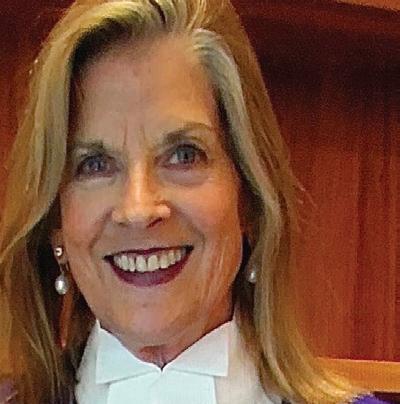
Years later in 2008, another attorney rang to ask if she was interested in taking a five-year contract as a County Court judge. Barbara jumped at it. It was a controversial appointment as the Bar maintained that temporary appointments undermined judicial independence.

Sarah’s first trial was before Judge Maguire in the Federal Circuit Court for a mother seeking custody of her child, opposed to John Williams. Williams cross-examined Sarah’s client about her drinking. Sarah sought to clarify in re-examination how much a night she drank. “Only about a bottle of saki.” Sarah thought she was bound to lose so when the judge said “the child lives with the mother”, she did a double fist pump at the Bar table.
When George Hampel was busy in a long trial he tossed a brief on Barbara’s desk. She recalls he was pessimistic about its chances. The client was said to have carried out an illegal abortion. All parties were from different parts of the former Yugoslavia. Robert Redlich prosecuted. Barbara was able to demonstrate that it was a false complaint motivated by ethnic hatred. Her client walked.
Sarah has chambers on the third floor of East with a happy gang of family barristers, mostly women. When she first met her next door neighbour, Trevor Monti, they went out for a smoke. He said “We’ll get along as long as
Other women had already marked the path to the County Court. Lynette Schiftan, the first appointed in 1985, is on the record for having had an unhappy time. There wasn’t a female toilet on her floor. She never had permanent chambers of her own but was shifted into the rooms of judges on leave.
When the government changed, Barbara’s appointment was made permanent. She loved the job and has only just retired from the reserve bench.
When asked how her experience compares with Barbara’s, Sarah says that, in her view, the sexism is more subtle these days. No one raises an eyebrow when a male barrister dresses flamboyantly but if a woman dresses fashionably she is accused of using her sex appeal. No journalist ever started a story with the cut of Tony Abbott’s suit but every first paragraph of a piece on Julie Bishop was about the designer of her dress.
Sarah says that there are now more women than men in family law so she thinks sexism is rare. But she believes that in the commercial sphere male silks still think blokes will be more prepared to put up with their tantrums and work through the night. She says that the stellar performance of Rowena Orr in the Financial Services Royal Commission shows skill and preparation, not gender, are what count. She looks forward to the day when there is no need for equitable briefing policies.
PETER HEEREY
Barbara Tuchman (1912–1989) was a leading American historian. She won the Pulitzer Prize twice: for The Guns of August, a history of the beginning of World War I, and for a biography of General Joseph Stilwell, a United States Army general who served in World War II, the Korean War and the Vietnam War.
One of Tuchman’s works is A Distant Mirror: The Calamitous 14th Century. Published in 1978, the reflection suggested by the title is that of the 20th century. Along with the Hundred Years’ War, anti-Semitism and popular revolts, there was the Black Plague—the latter having so much resonance now. The pandemic has for the moment rather upstaged climate change. But Tuchman’s account of the 14th century again bears comparison. There was the “Little Ice Age”, which reduced the average temperature of Europe until the 18th century.
Practising History (1981) is a collection of Tuchman’s articles and addresses on the art and craft of the historian—wonderfully readable and persuasive. As one reviewer opined, Tuchman “writes with lucidity and grace and a most elegant economy”.
Tuchman’s book has provoked some thoughts about history, storytelling, and how they work.
Research is the starting point for the historian, and in particular research into primary sources. Tuchman found the research “endlessly seductive”, but the writing “hard work”:
One has to sit down on that chair and think and transform thought into readable, conservative, interesting sentences that both make sense and make the reader turn the page.
Communication is what language was invented for. A collaboration between author and reader. Tuchman quotes Theodore Roosevelt: “Writings are useless unless they are read, and they cannot be read unless they are readable ”
Especially for the historian, there is a need to sustain interest in a narrative of which the outcome is known. A historian is a storyteller, a narrator who deals in true stories, not fiction. The least the storyteller can do is to stay within the evidence. Tuchman is critical of the “systematizers”, who arrange systems and cycles into which history must be squeezed so it will come out evenly and have a pattern and a meaning. But history, “wickedly disobliging”, can pop up in the wrong place. The human record is illogical. Putting the system first “cannot escape

the heresy of preferring facts which suit the system first”. Nevertheless, Tuchman regards emotion as “an essential element of history”. History is “emotion plus action recollected … after a close and honest examination of the records”. Yet poets, limited by no such rule, have often done very well with history.
Tuchman’s example is Tennyson’s Charge of the Light Brigade, written within three months of the Crimean War battle.
“Forward, the Light Brigade!” Was there a man dismayed? Not though the soldier knew Someone had blundered. Theirs not to make reply, Theirs not to reason why, Theirs but to do and die. Into the valley of Death Rode the six hundred.
In Tuchman’s view, the poem: as poetry may lack the modern virtue of incomprehensibility, [I like that!] but as history captures that combination of the
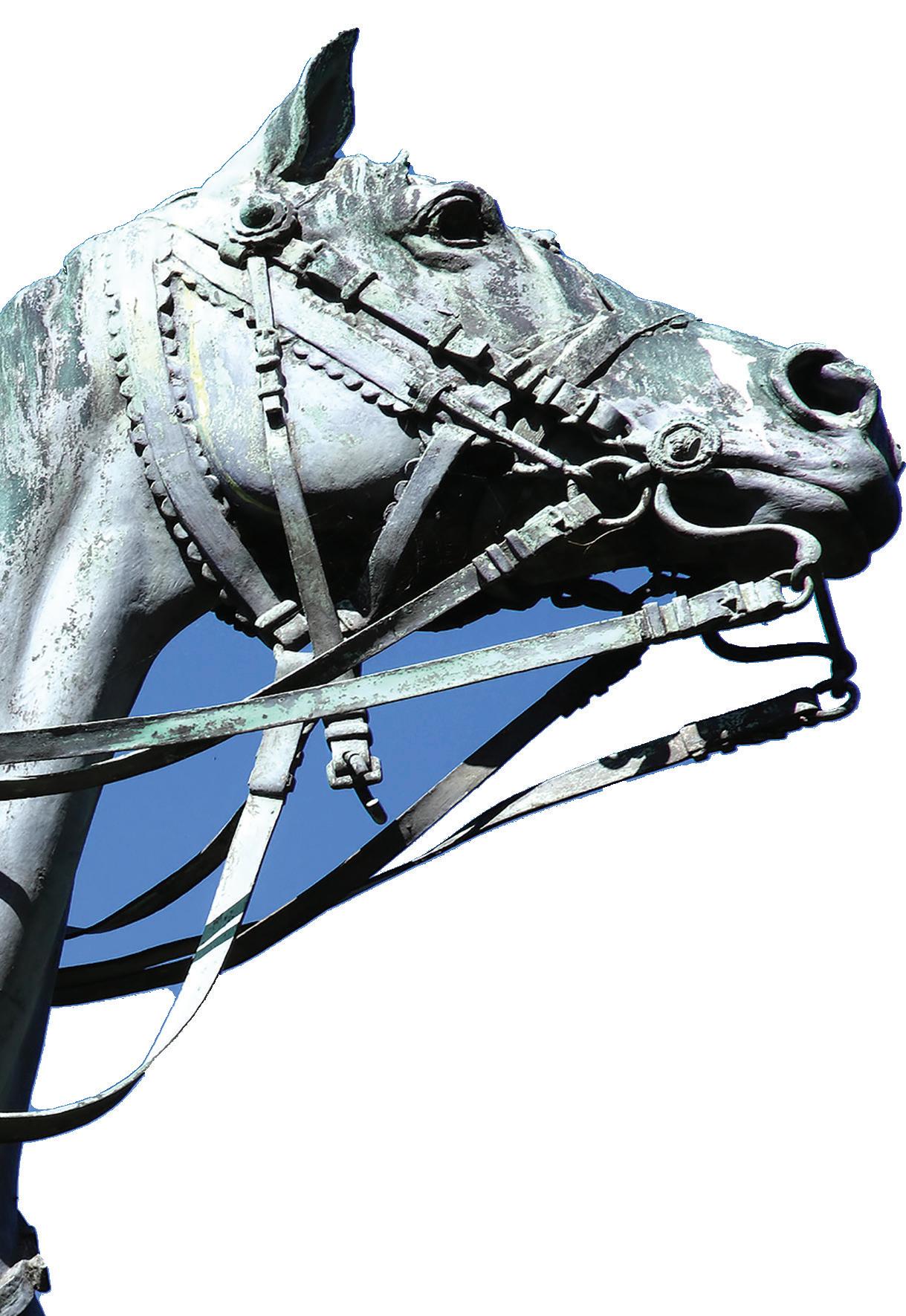

glorious and the ridiculous which was a nineteenth century cavalry charge against cannon.
Indeed there may be room for just entertainment. As George Wilson, my history lecturer and rugby coach at the University of Tasmania, would mark on essays, “factually correct, but lacks colour and amusing anecdotes”.
In an article entitled “History by the Ounce”, Tuchman refers to PoohBah’s explanation in The Mikado that he had added “corroborative detail intended to give artistic verisimilitude to an otherwise bald and unconvincing narrative”.
But Tuchman points out that corroborative detail will often reveal a historical truth besides keeping one grounded in historical reality. She cites an example in her writing on the Dreyfus Affair, which bitterly
Tuchman found the research ‘endlessly seductive’, but the writing ‘hard work’
divided France along political, religious and social lines for many years.
General Mercier, Minister of War, was responsible for the original condemnation of Dreyfus and became the hero of the Right. Tuchman discovered that, at parties of the haut monde, ladies rose to their feet when General Mercier entered the room. Tuchman comments:
That is the kind of detail which to me is worth a week of research. It illustrates the society, the people, the state of feeling at the time more vividly than anything I could write. … It epitomizes, it crystallizes, it visualizes. The reader can see it; moreover it sticks in his mind; it is memorable.
In Practising History, Tuchman discusses whether we learn from
the stories of history. Her example is Pearl Harbour. The US authorities should have learned from history that a surprise attack by Japan in the midst of negotiations, while dishonourable, was not unthinkable—exactly the same procedure had been adopted in 1904 when Japan opened the RussoJapanese War by a surprise attack on the Russian fleet at Port Arthur. Moreover, the Americans had broken the Japanese code, and had warnings on radar and a constant flow of accurate intelligence. But as Tuchman observes, “Men will not believe what does not fit in with their plans or suit their prearrangements.”
Judgement is “the product of a mass of individual, social, and political biases, prejudgements, and wishful thinkings; in short it is human and therefore fallible.”
(Another example is Stalin’s refusal to heed clear warnings of Hitler’s attack in June 1941.)
While on Pearl Harbour, one historical fact that does not get much attention is that four days after the Japanese attack, Hitler declared war on the US. But Germany’s treaty obligation only arose if it was Japan who was attacked. As a counterfactual, a what-if, imagine the consequences of no such declaration. Isolationist feeling was strong in the US. While there was obviously going to be war with Japan, all the more reason for the US not to get entangled in European wars.
So to adapt Toynbee, history is just one damn story after another.

KAREN MAK
The next time you watch the Australian Open, look carefully—when she is not in a court of law, Karen Mak may be found on a tennis court, working as a line umpire at the Australian Open. Each January, the world’s best tennis players compete in front of more than 800,000 fans at the first Grand Slam of the season—the Australian Open. But the players aren’t the only ones feeling the pressure. Line umpires, tasked with accurately making split-second decisions on whether the ball is in or out, also feel the heat. The ball can land within millimetres of the line and if you get it wrong, you risk being overruled by the dreaded Hawkeye on live TV. Feedback to line umpires on a close call is immediate, whether it be a McEnroe-esque player reacting, crowd booing, or chair umpire overruling.
I’ve long played competitive tennis and have attended countless professional matches.
But several years ago I decided to try something new; I applied for a line umpire position with Tennis Australia. Months later, I attended tryouts. The tryouts consisted of a combination of quizzes, instruction on technique and performance assessments umpiring actual matches. After advancing through several rounds of tryouts and passing an eye exam, I was soon officiating my first match as a line umpire. I was so nervous, standing there waiting to deliver my first ‘out’ call, hoping I would get it right.
The job of an umpire doesn’t just take place during the Australian Open. Throughout the year, local line umpires hone their skills working in tournaments in and around Victoria, from junior tournaments to AMT and professional tournaments. During each match, the chair umpires evaluate each line umpire’s
You have been selected to work as an official at Australian Open 2020!”
In mid-January, I went to Melbourne Park to pick up my accreditation badge and my uniforms. I was given a tour of the venue, including the officials’ break room (where we rest between rotations), the employee dining areas, as well as the private tunnels under the arenas that we and the players use to get to our assigned courts.
It was at this point that I really started to appreciate the magnitude of the tournament that I was about to be involved in. The venue was teeming with activity, a rush of lastminute construction projects being completed, kiosks being assembled, television crews feverishly setting up for the big event, now just days away.
performance on a scale of 1 (unacceptable) to 7 (outstanding) on factors such as accuracy, movement, voice, and signalling. An average score of at least 4.25 is required to be eligible for selection to work at the Australian Open.
One key to success is to be confident in my ability and rely on my initial impression. I have seen too many line umpires lose their confidence.
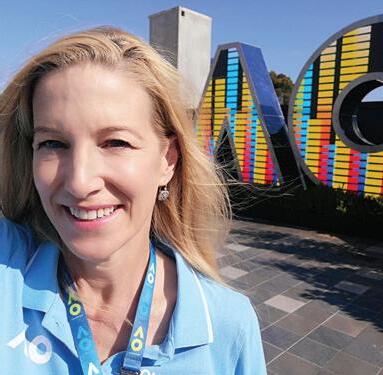
An umpire with selfdoubt on the court is pretty transparent, for example, in a weak or slightly delayed “out” call. Like making an objection during a trial, there is no time to contemplate or intellectualize. You have to make a decision and act quickly, or the opportunity is gone.
In mid-2019, after several years as a line umpire, I submitted an application to work my first Australian Open. In early October I received the email I had been hoping for. In bold letters it read: “CONGRATULATIONS!
My first day working the Australian Open finally arrived. At 8:15am, I scanned my badge at the entrance of Melbourne Park and walked across the nearly empty venue to our designated meeting area. On the way, I walked past Stan Wawrinka, a former AO champion, giving a press interview and later Naomi Osaka, last year’s AO champion warming up before an exhibition match. I put my items in my locker and checked the roster to see which squad I had been assigned to for the day. I grabbed my hat and sunglasses and went to my squad meeting. I was anxious, but nevertheless excited to begin. The reality of walking onto the court and assuming my position behind the baseline was intimidating. However, not long after the play began, I quickly settled in and concentrated. Our first one-hour shift quickly came to an end. Our squad performed well; no overrules or Hawkeye challenges (at least this time).
Karen is a member of the Royal South Yarra Tennis Club and also plays at Fawkner Park tennis centre. She welcomes opportunities to play tennis with other members of the Bar. Karen accepts commercial and criminal briefs. Her mentor is Susan Gatford and her senior mentor is Colin Golvan AM QC.
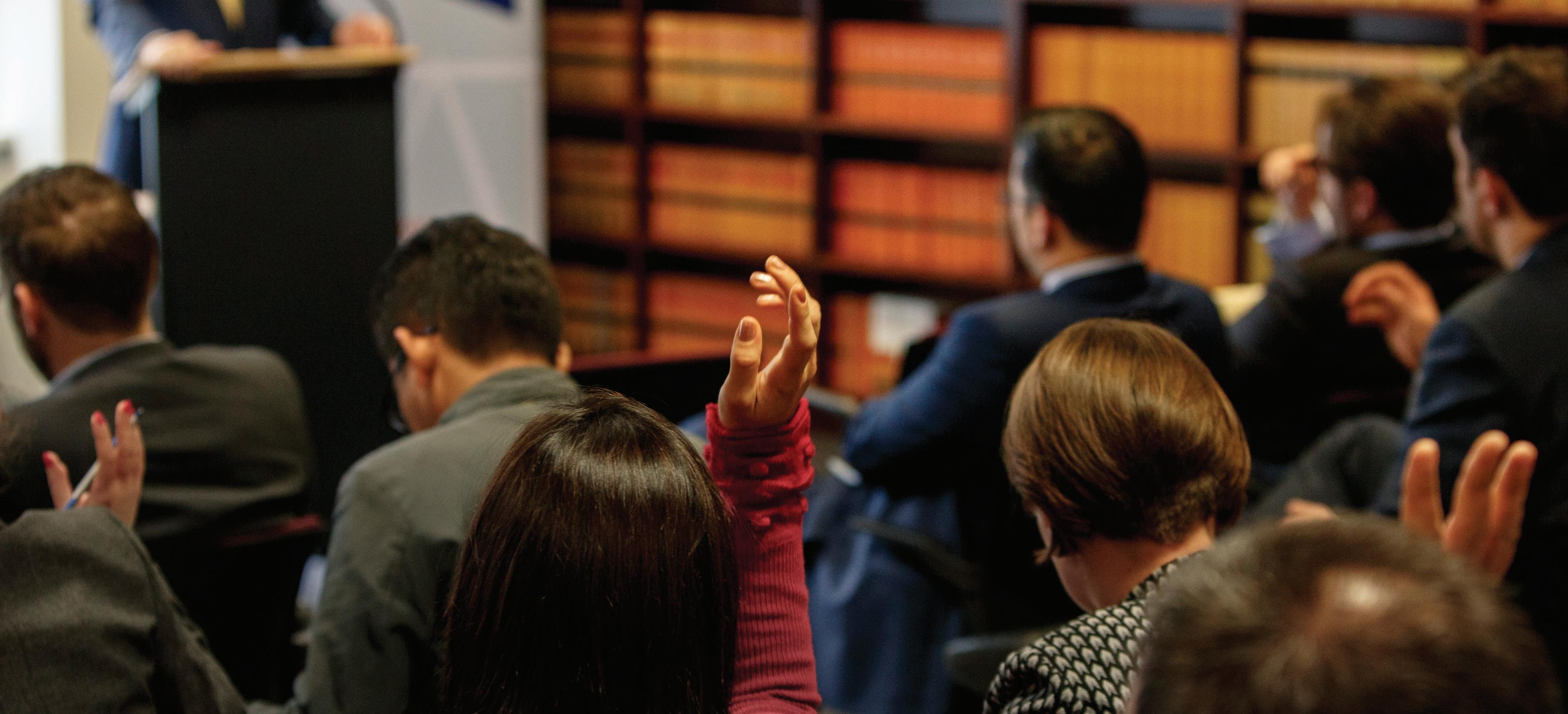
Continuing professional development by the Bar for the profession
Specialist legal education from the Victorian Bar’s acclaimed CPD program is now available for purchase by external subscribers on-line.
What is CPD in session?CPDINSESSION
CPD in SESSiOn provides online legal education by the Victorian Bar for solicitors, in-house and government lawyers offering a range of expert seminars and Q&A sessions with expert presenters from the judiciary, the Bar and more.
Fully resPonsive
View or listen on your PC, tablet or mobile device, ondemand anywhere, anytime
subjeCt matter exPerts CPDINSESSION
Sessions presented by eminent panellists, skilled advisors and speakers from across the legal profession. CPD in SESSiOn provides high quality continuing professional development from subject matter experts that is relevant, accessible, valuable and responsive to changes occurring within the legal profession.
Earn your CPD points across all CPD categoriesSubstantive law, Professional skills, Practice management and business skills and Ethics & professional responsibility. Categories CPDINSESSION


Purpose-built mediation and conference rooms in the heart of Melbourne’s legal precinct.
The Victorian Bar knows how important the mediation process is. We’ve put our experience and knowledge into creating the right space to support parties through mediation.
• Modern neutral decor with abundant natural light
• Business room and printing facilities
• Reception and administration services
• Fully equipped kitchen with tea & coffee making facilities
• After hours operation available
• Video and teleconferencing facilities
• Central location within Melbourne’s legal and business precinct
• Secure free Wi-Fi



